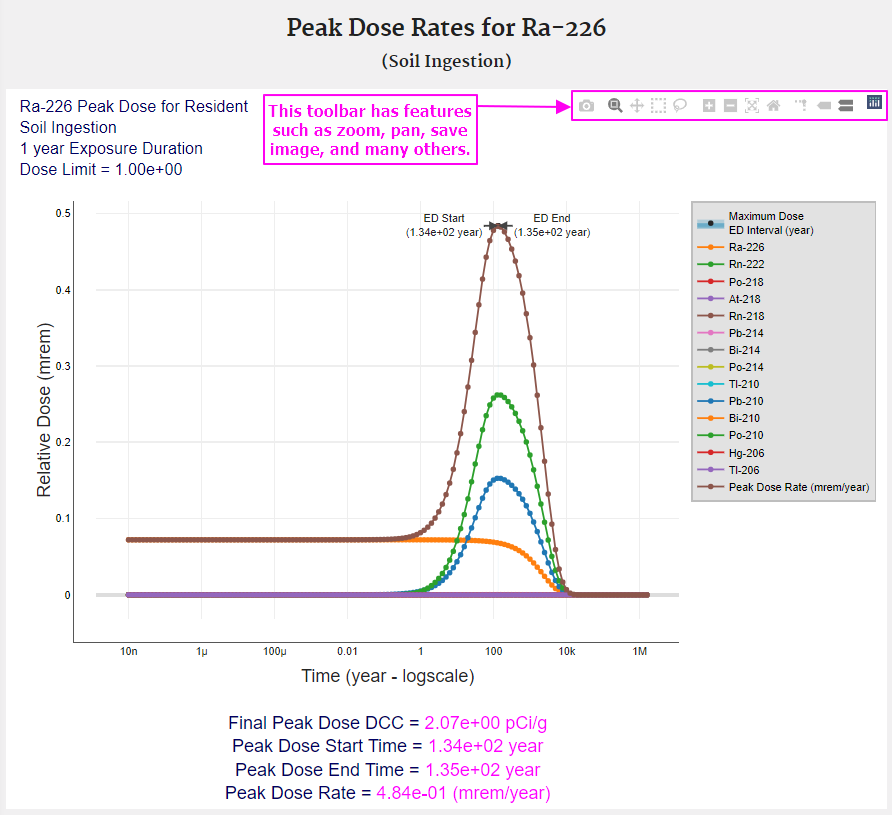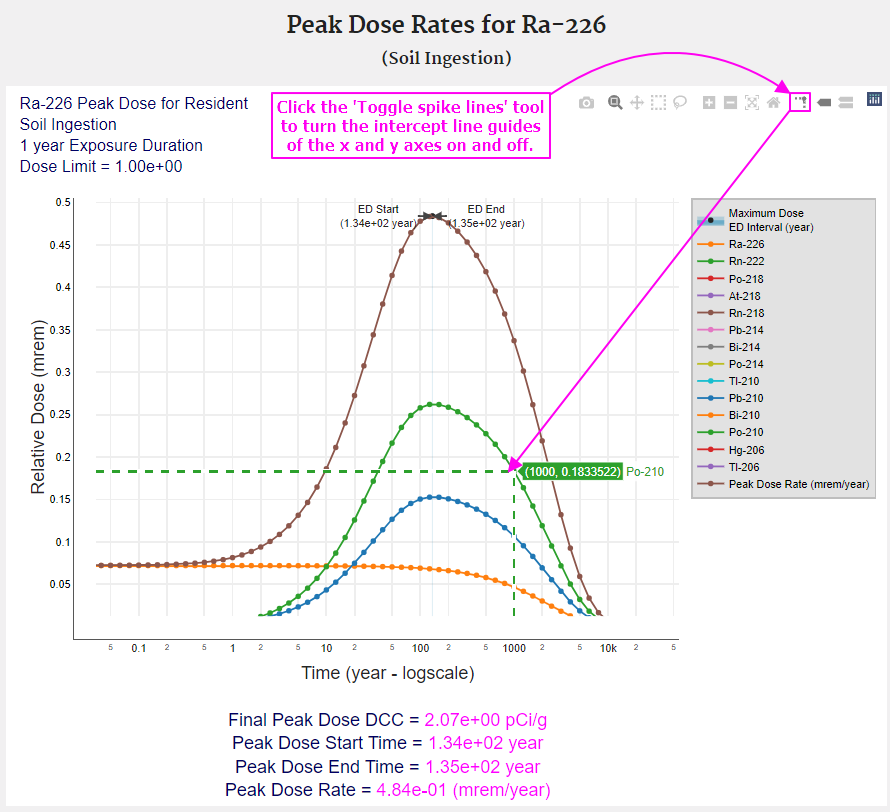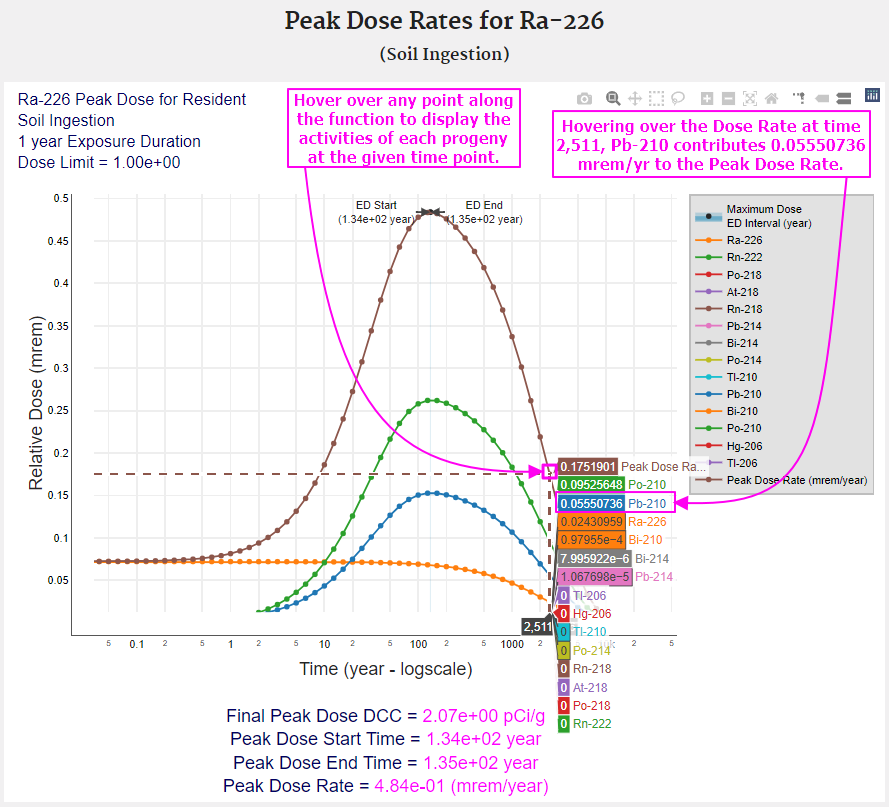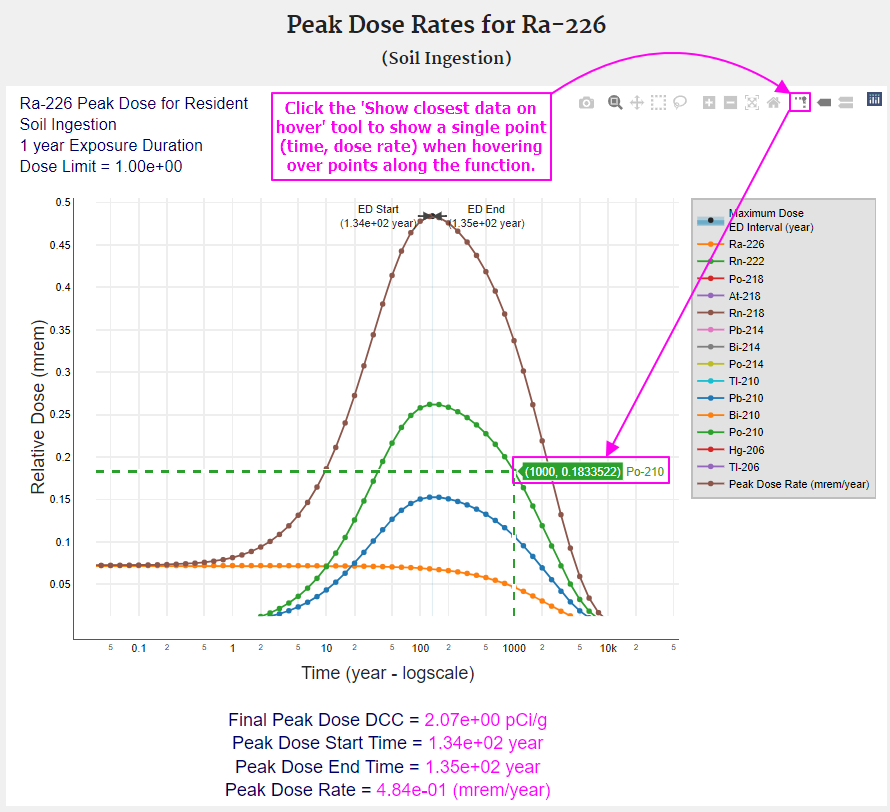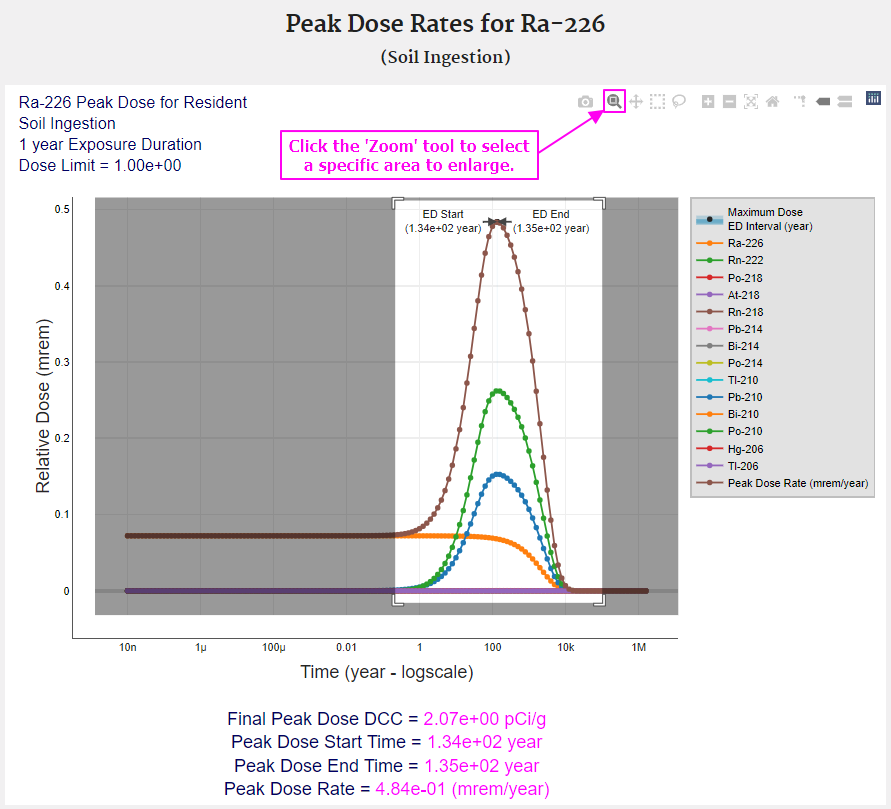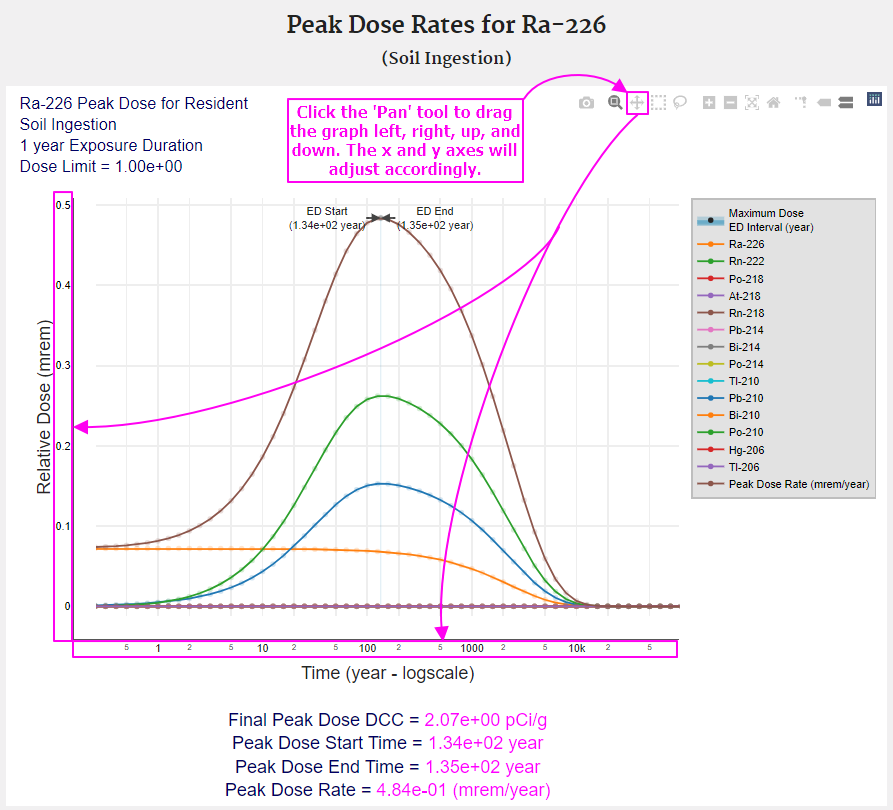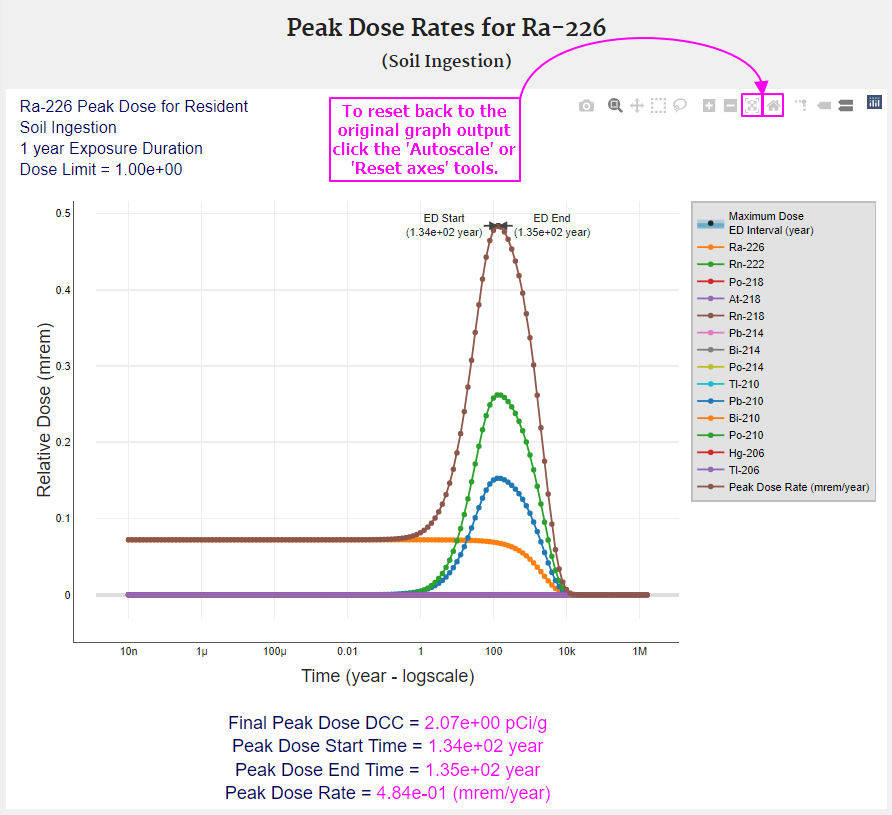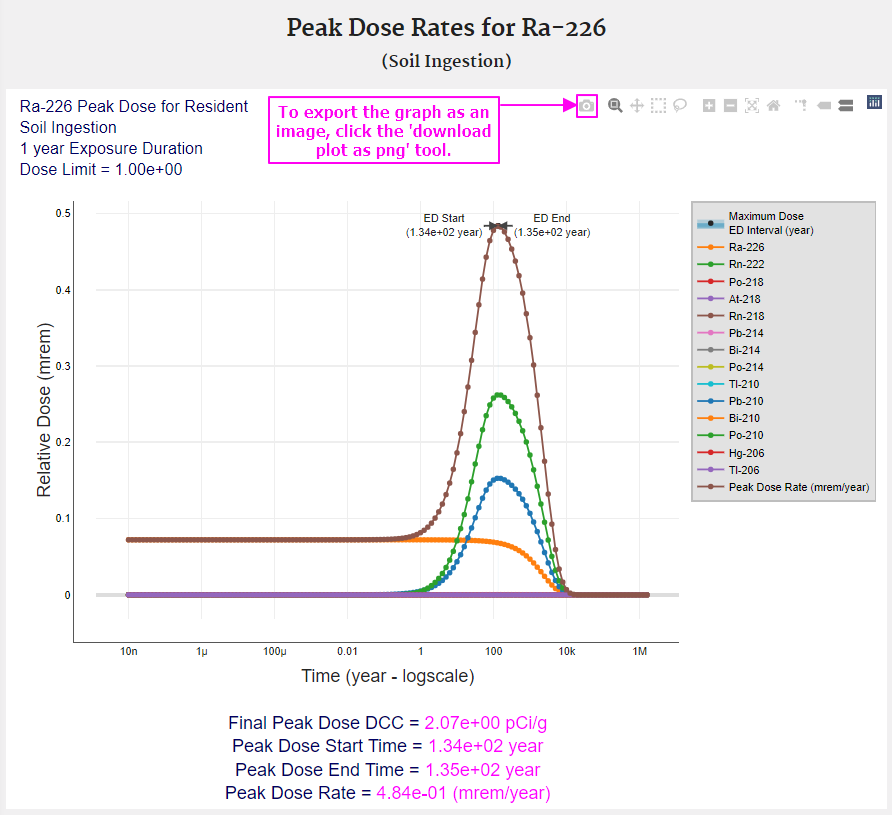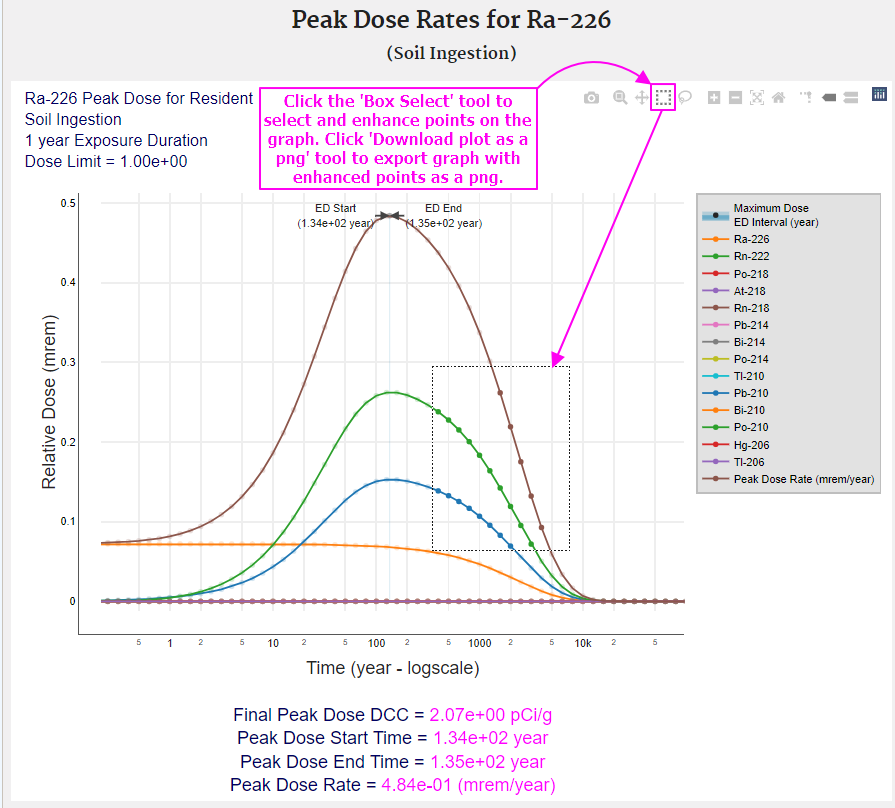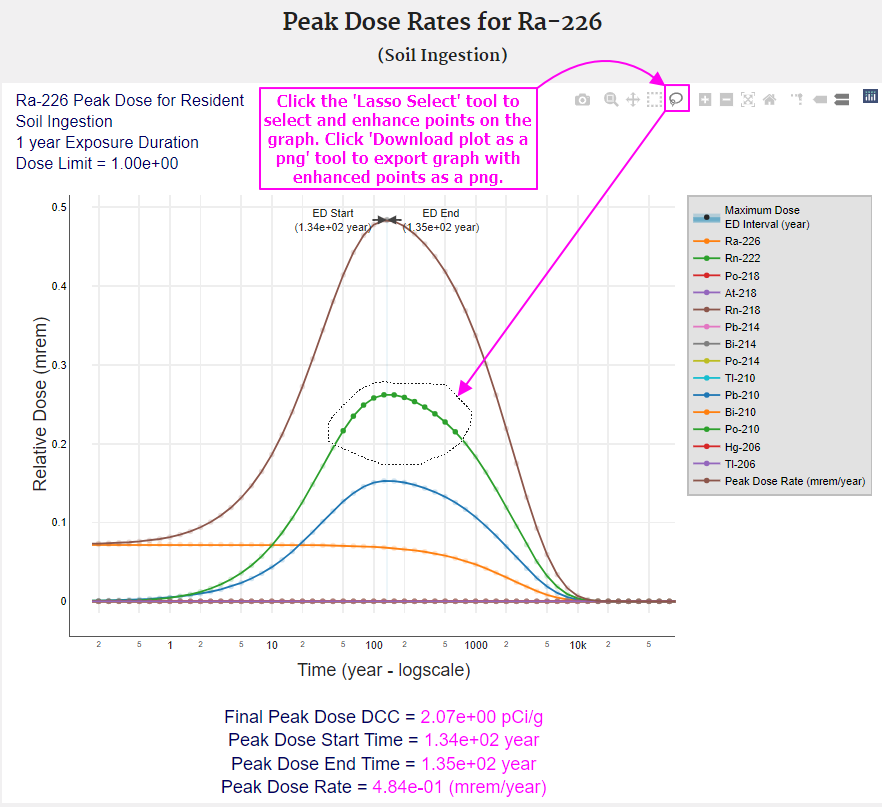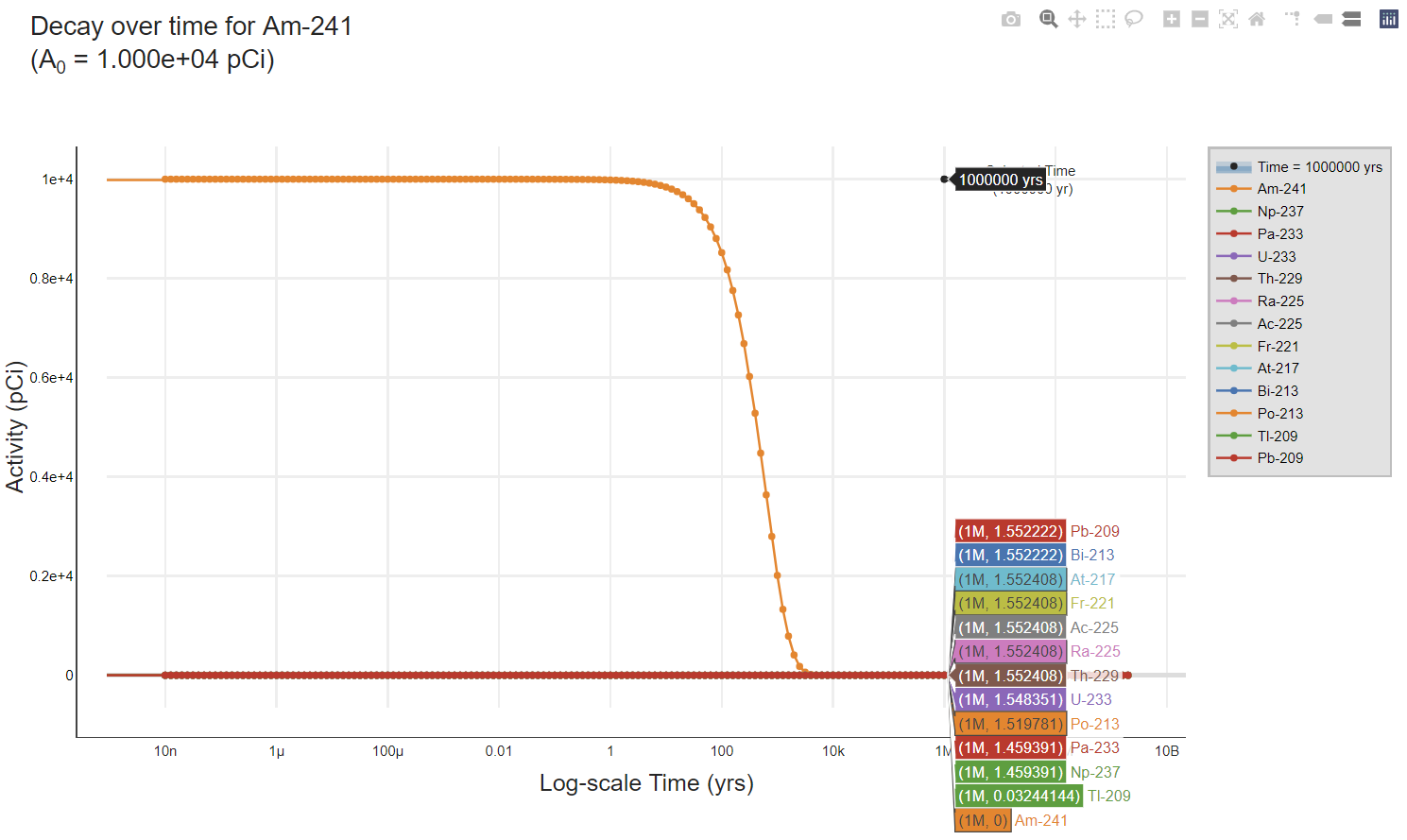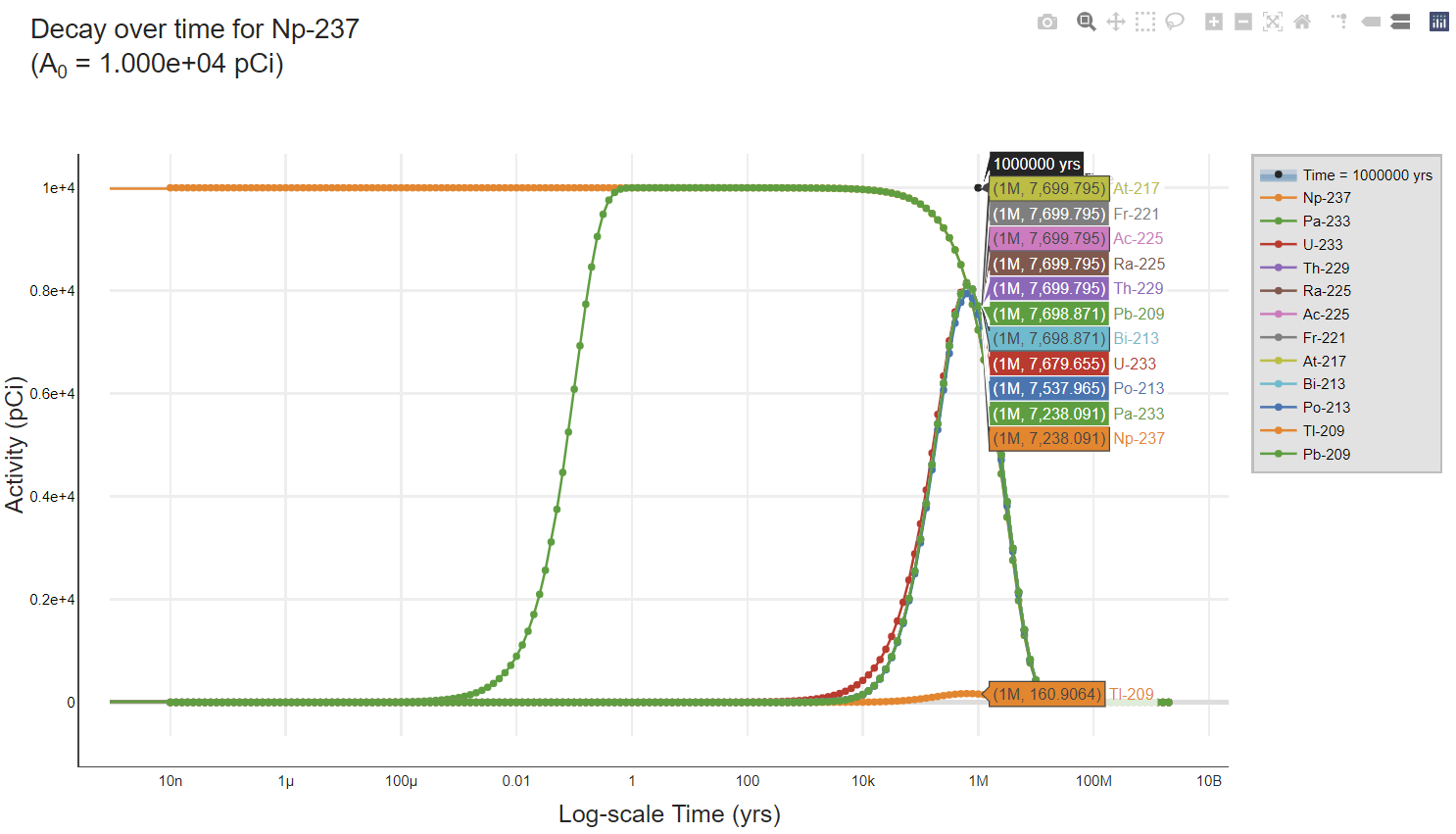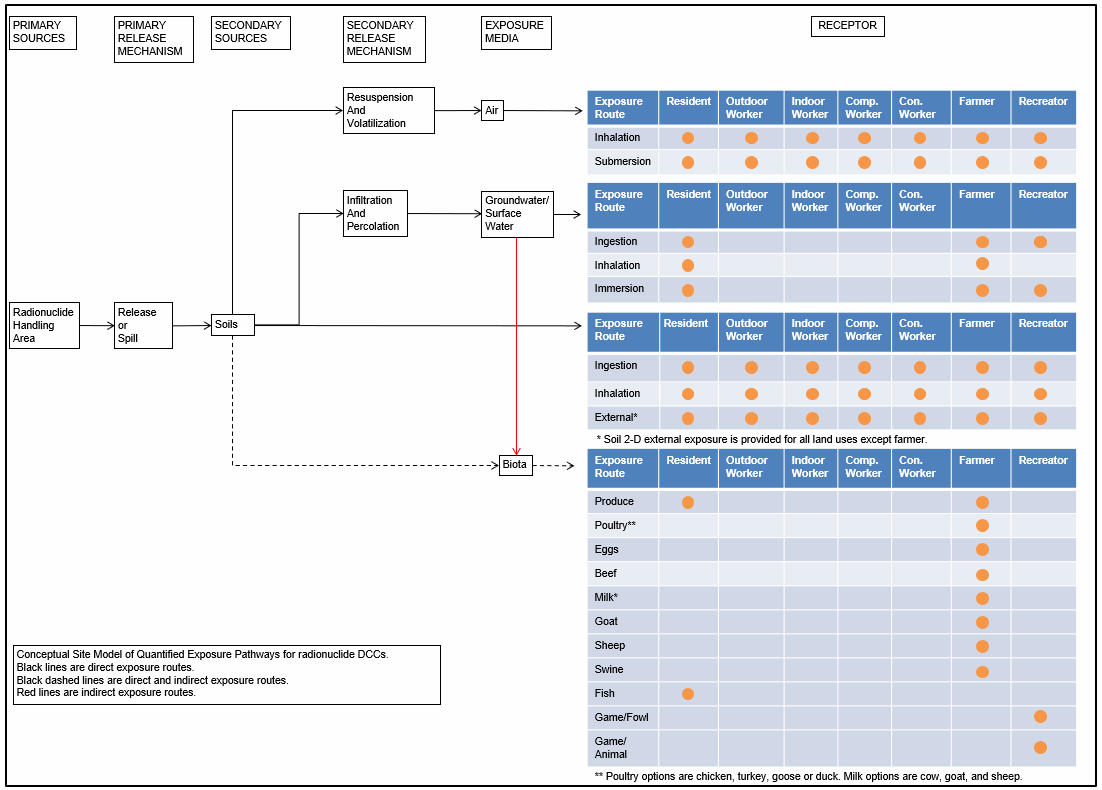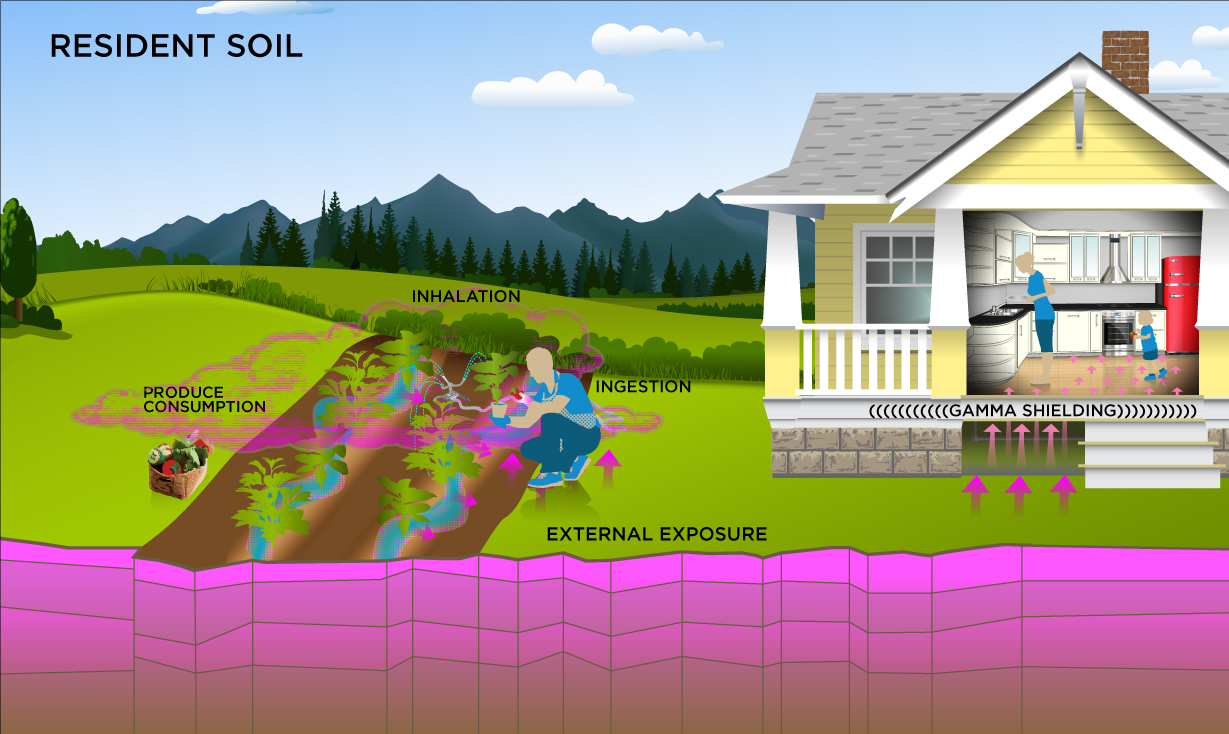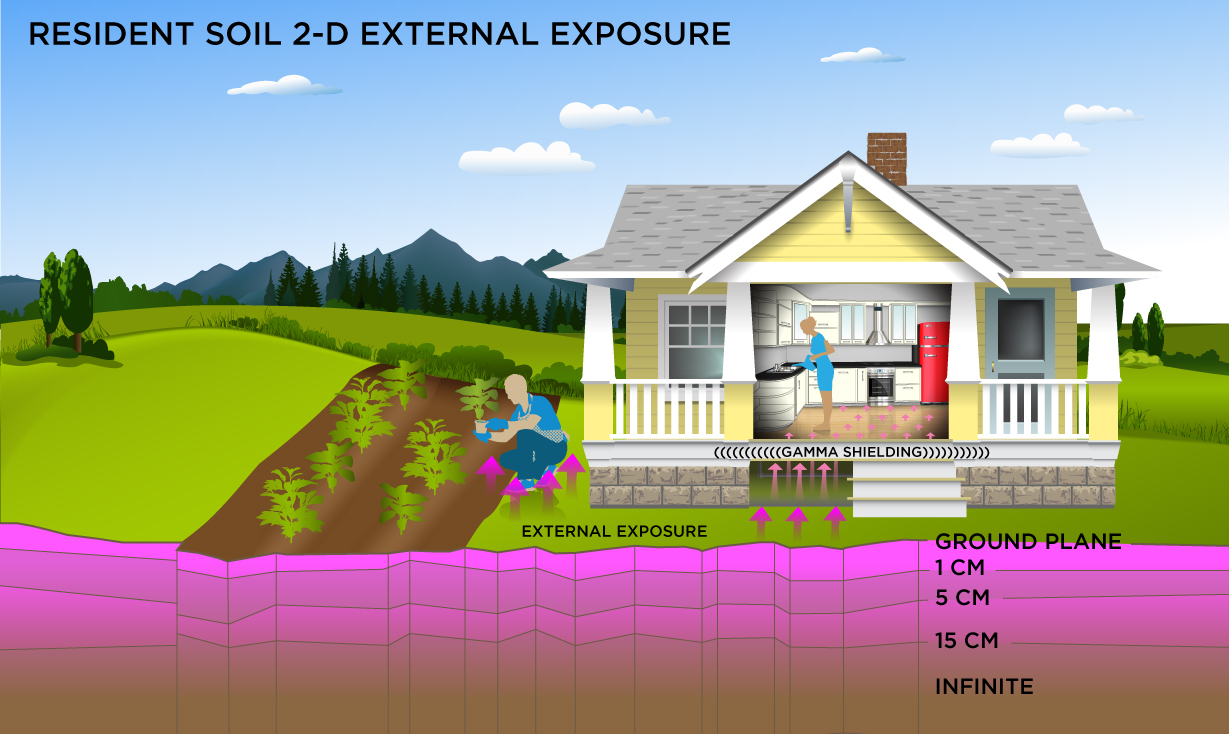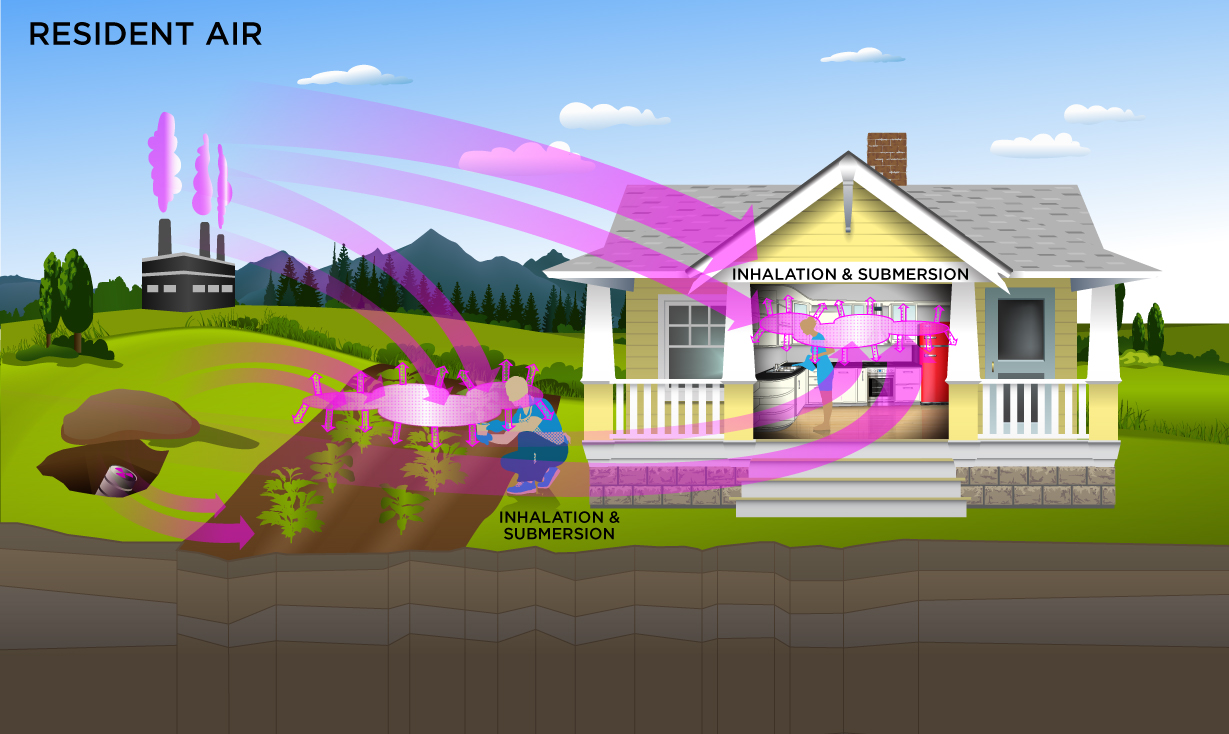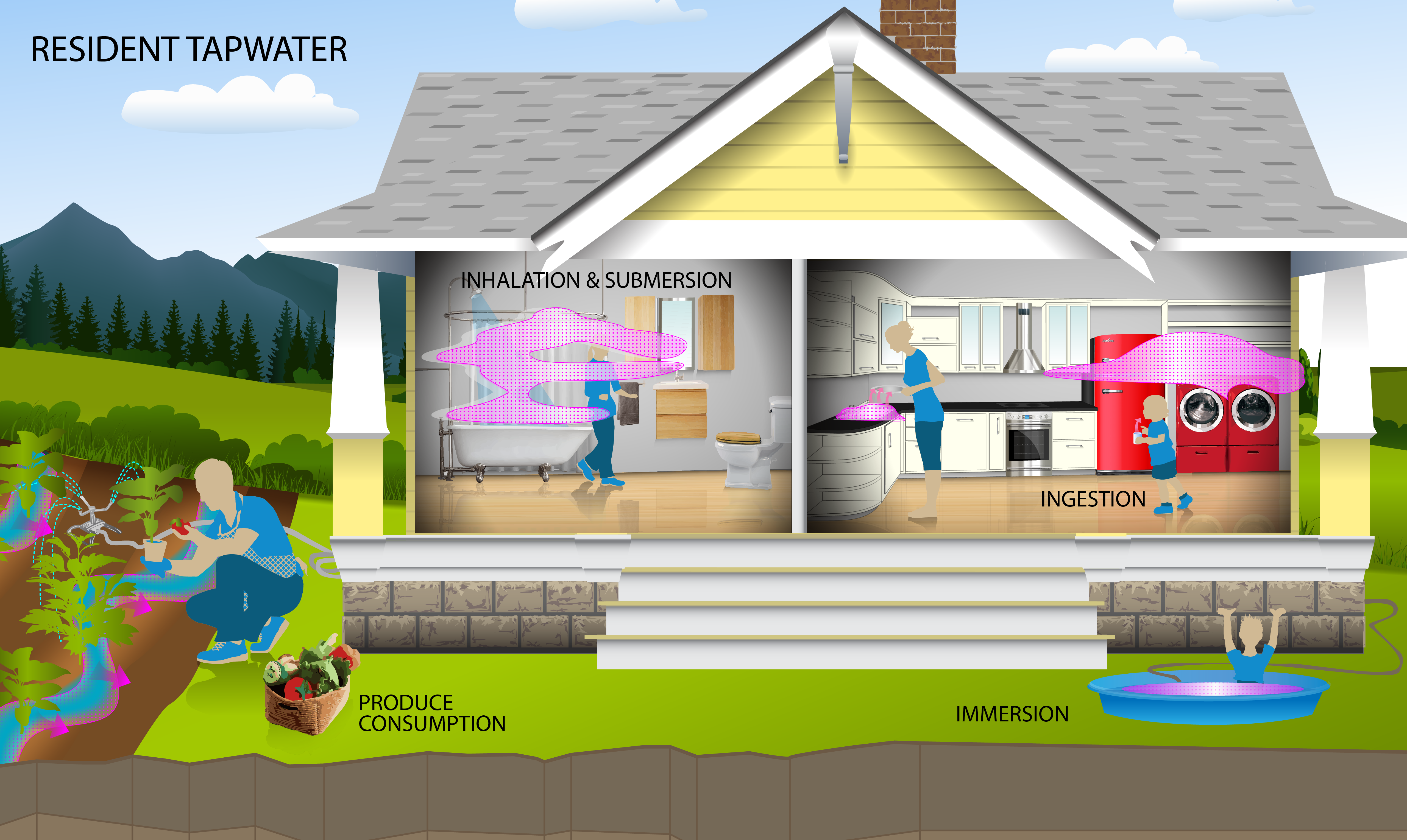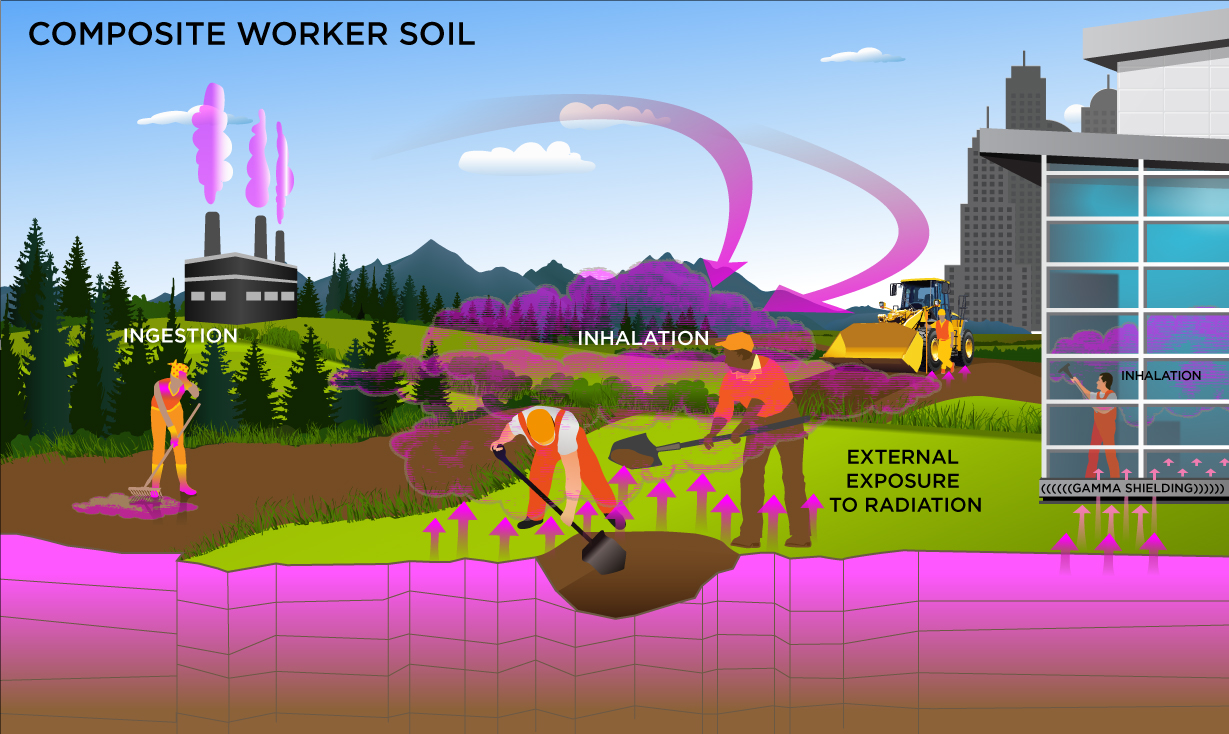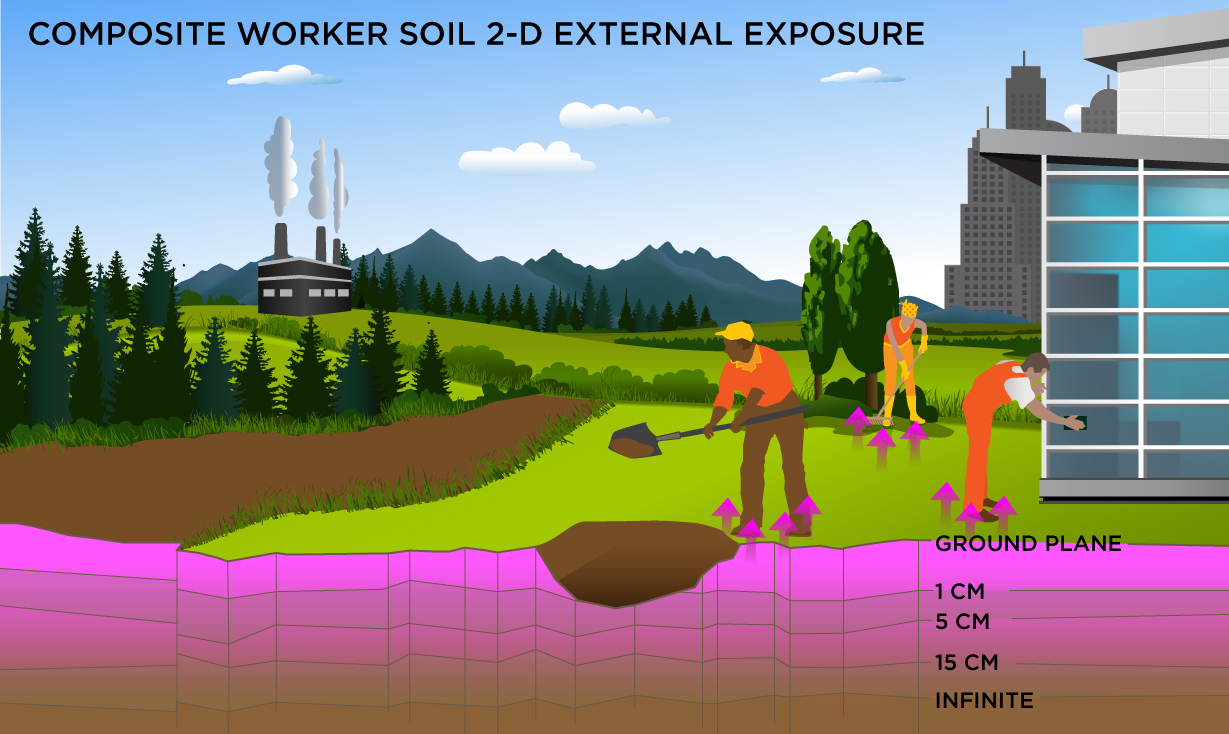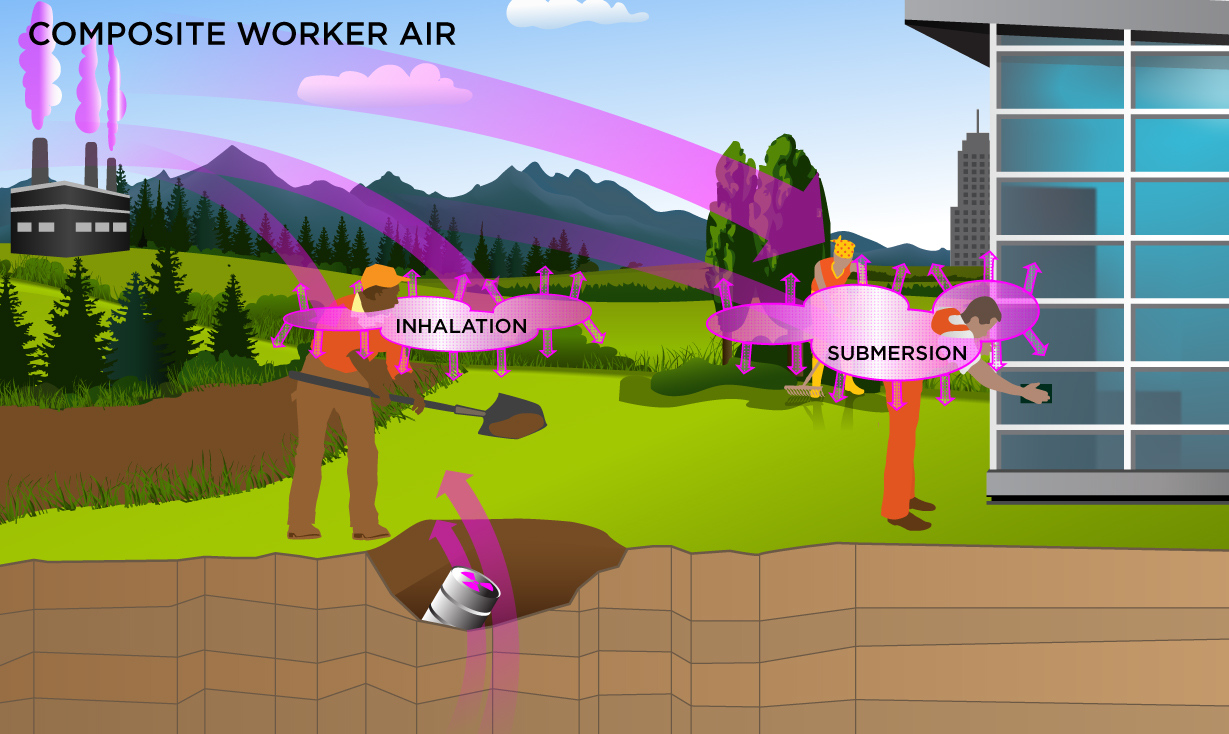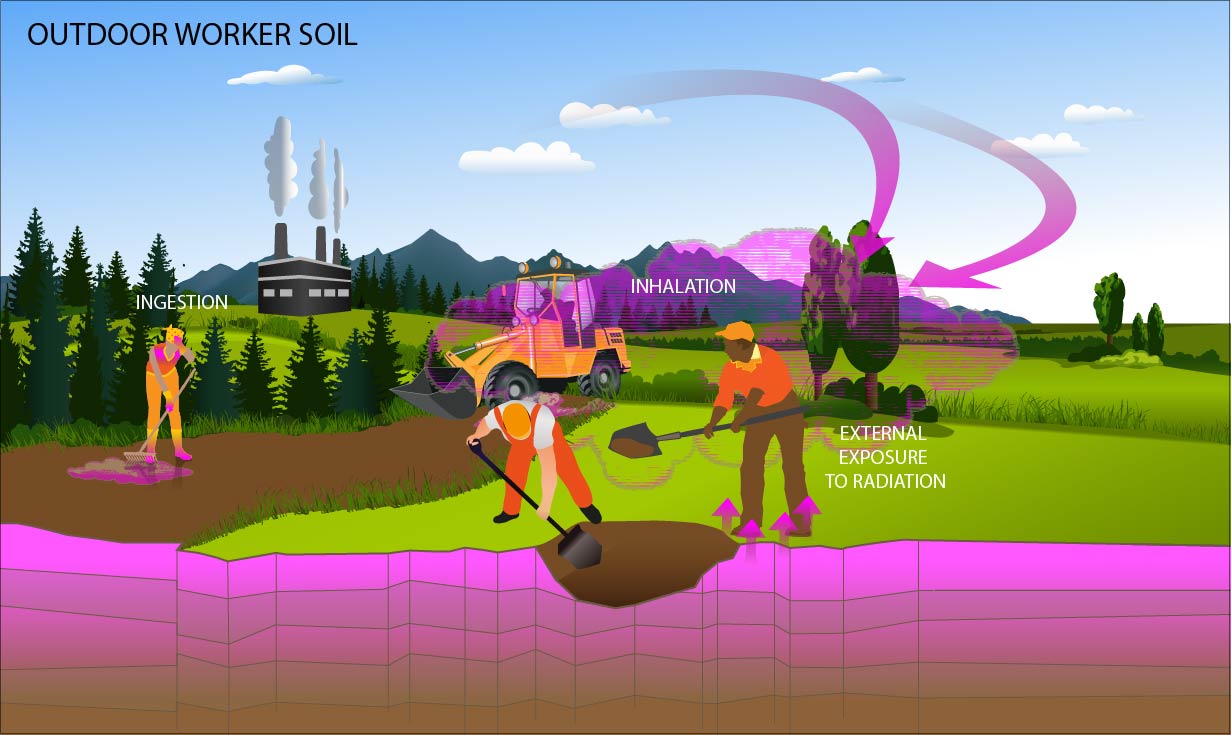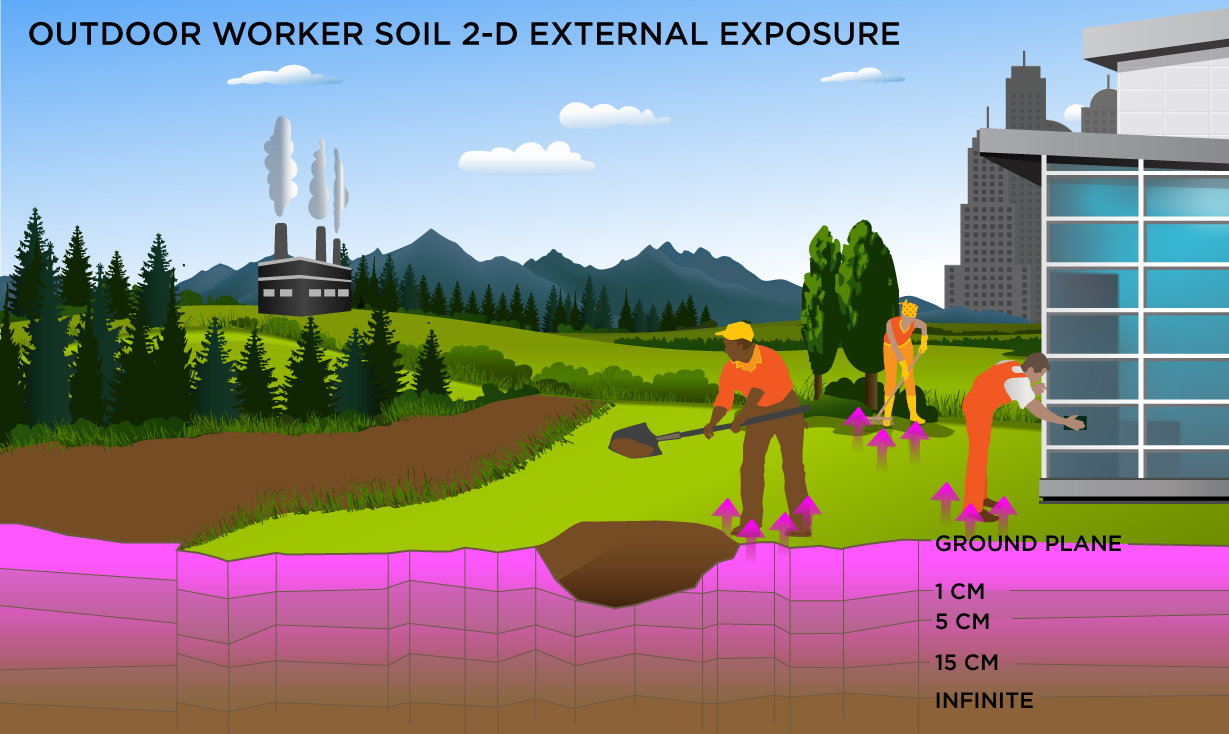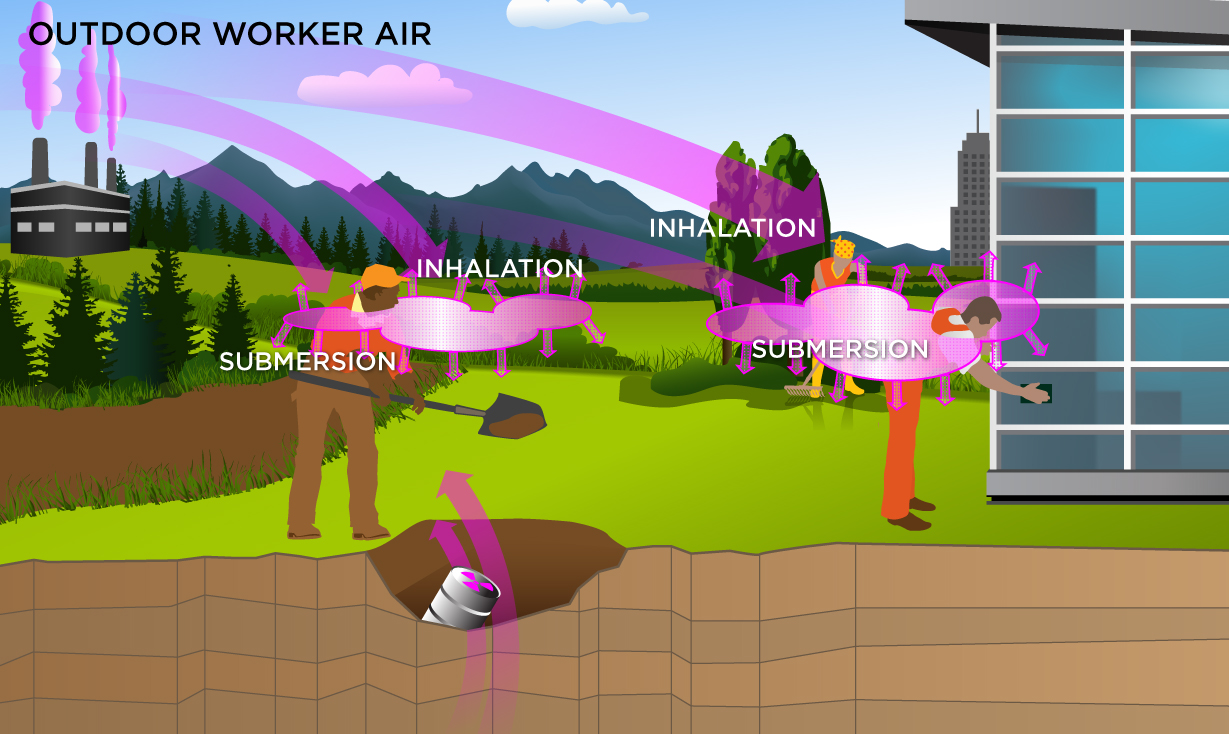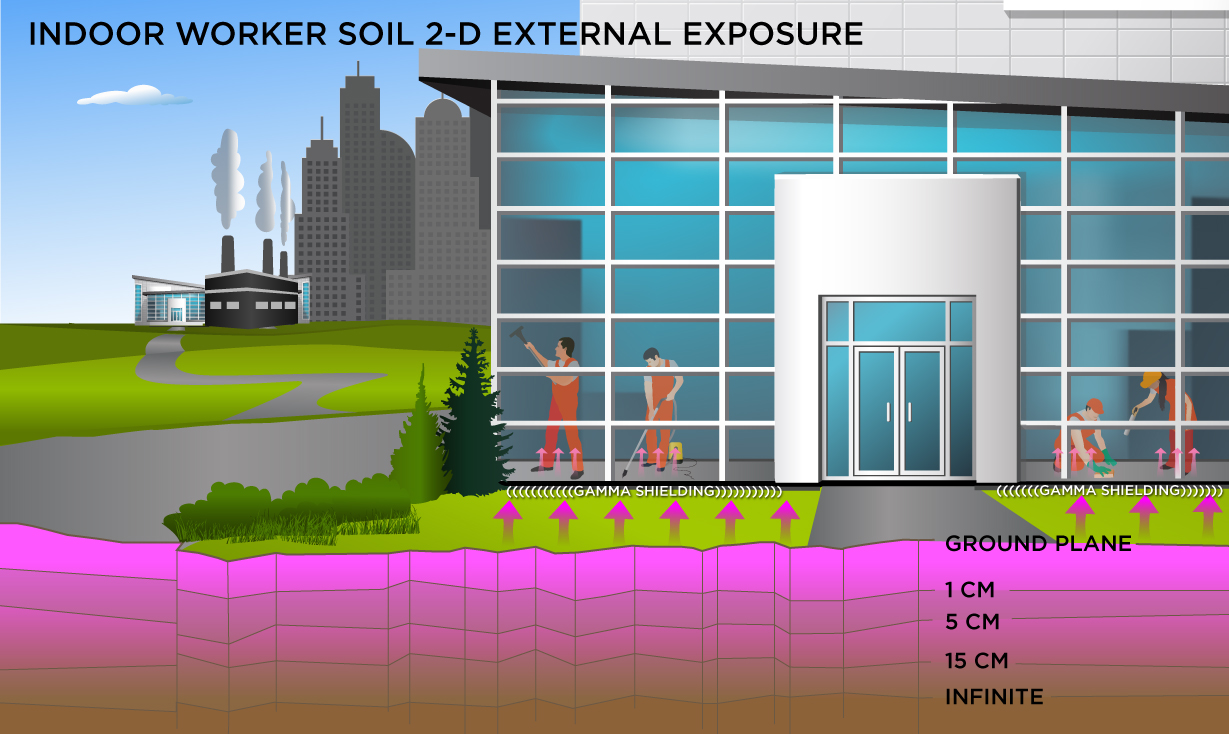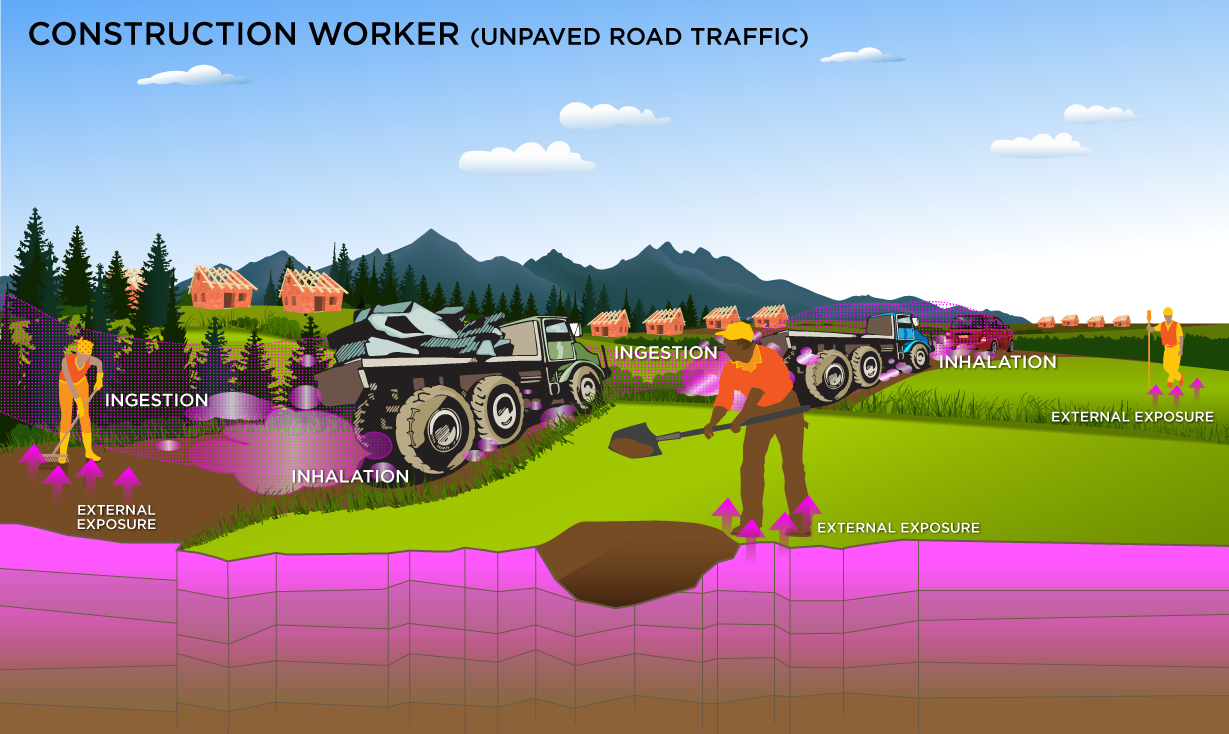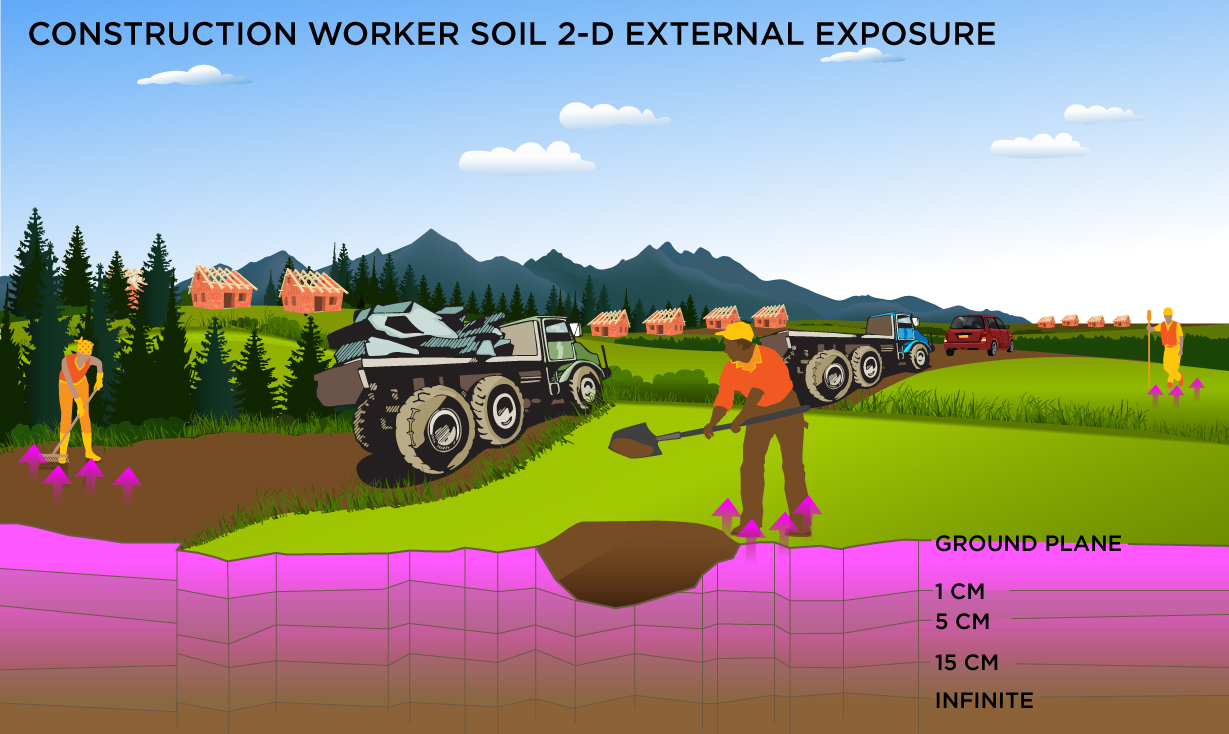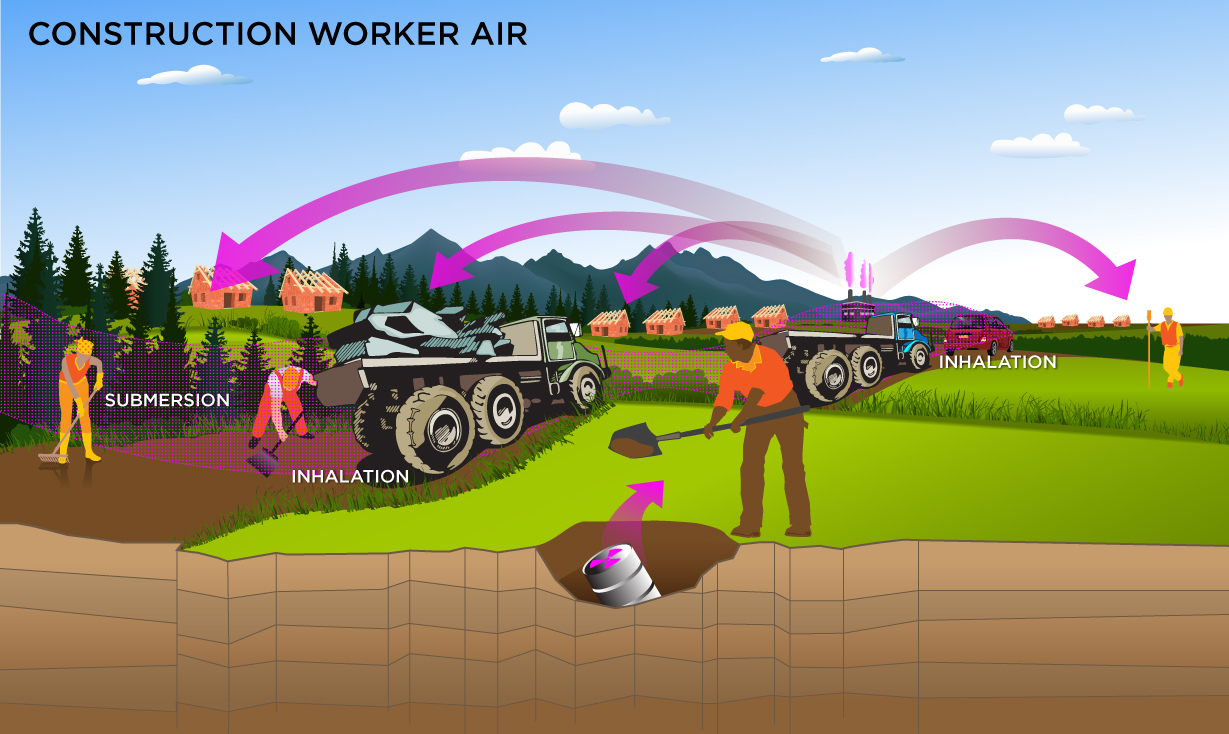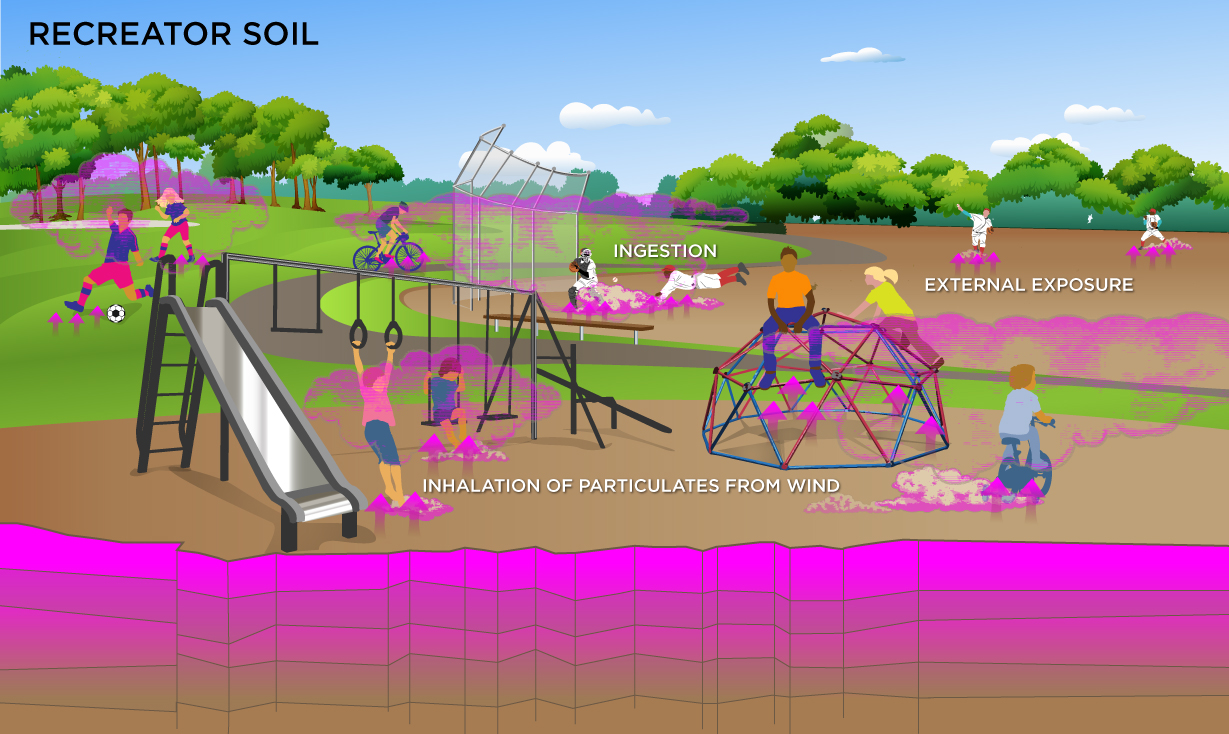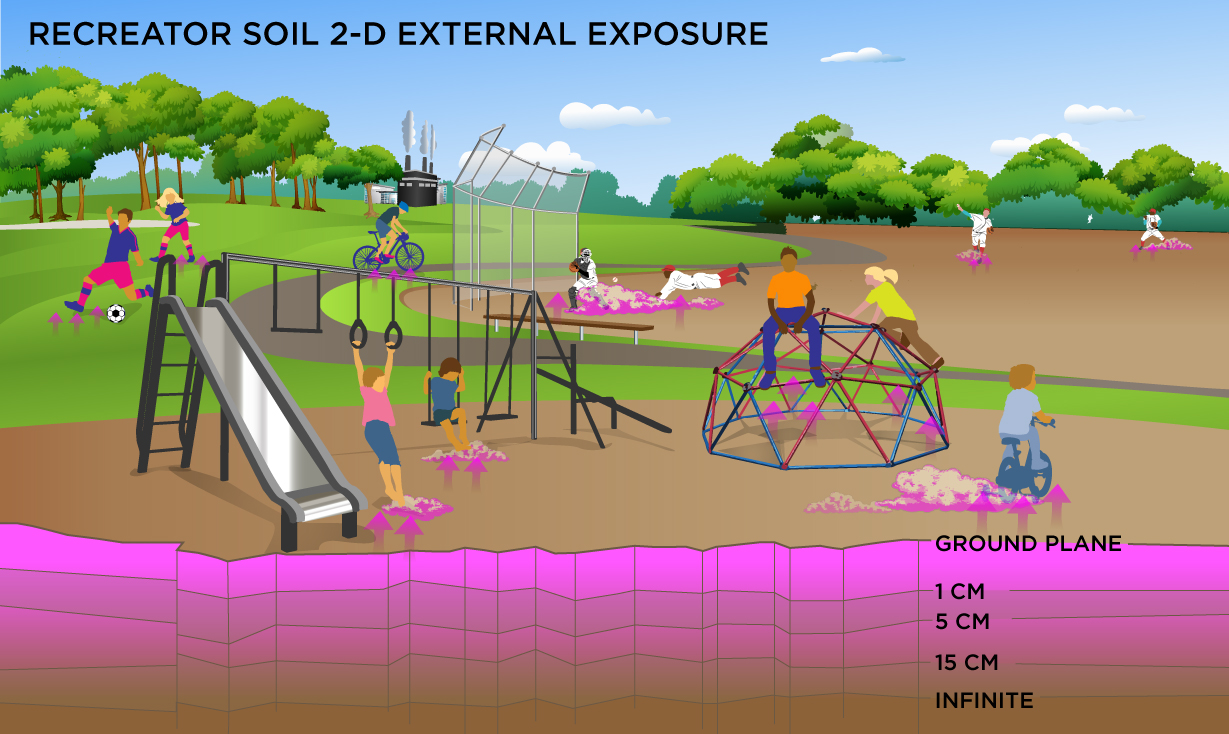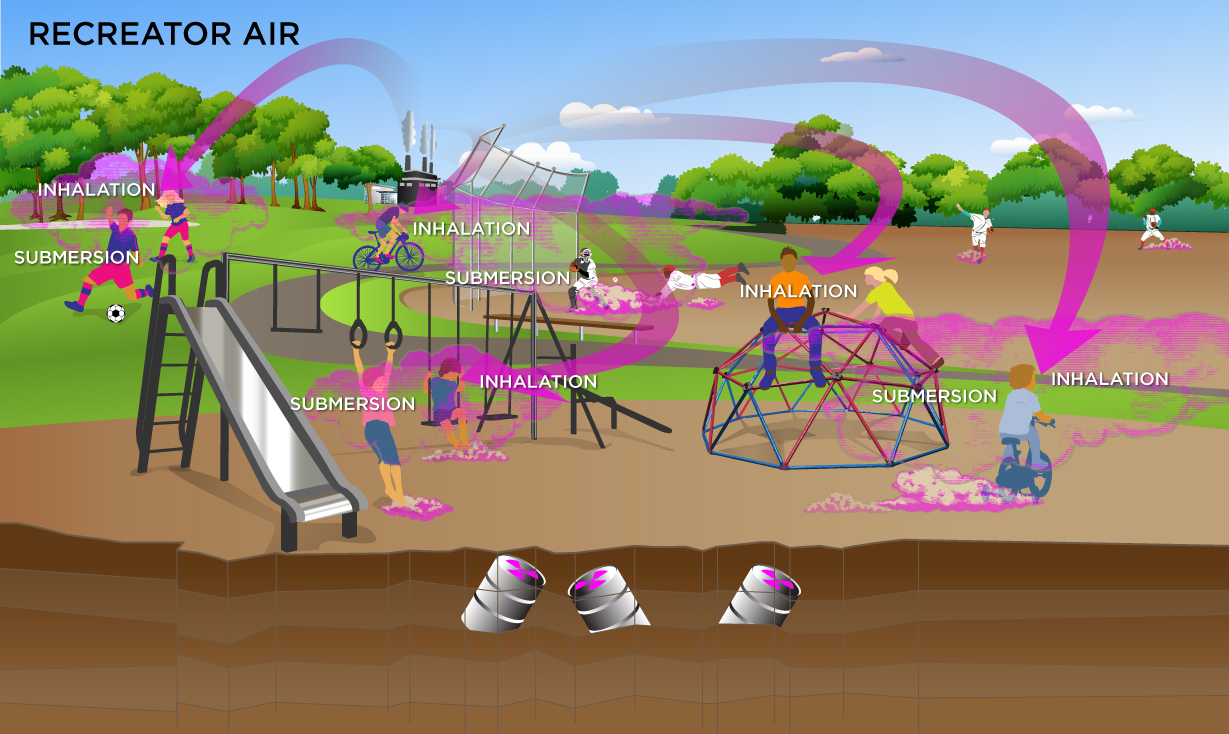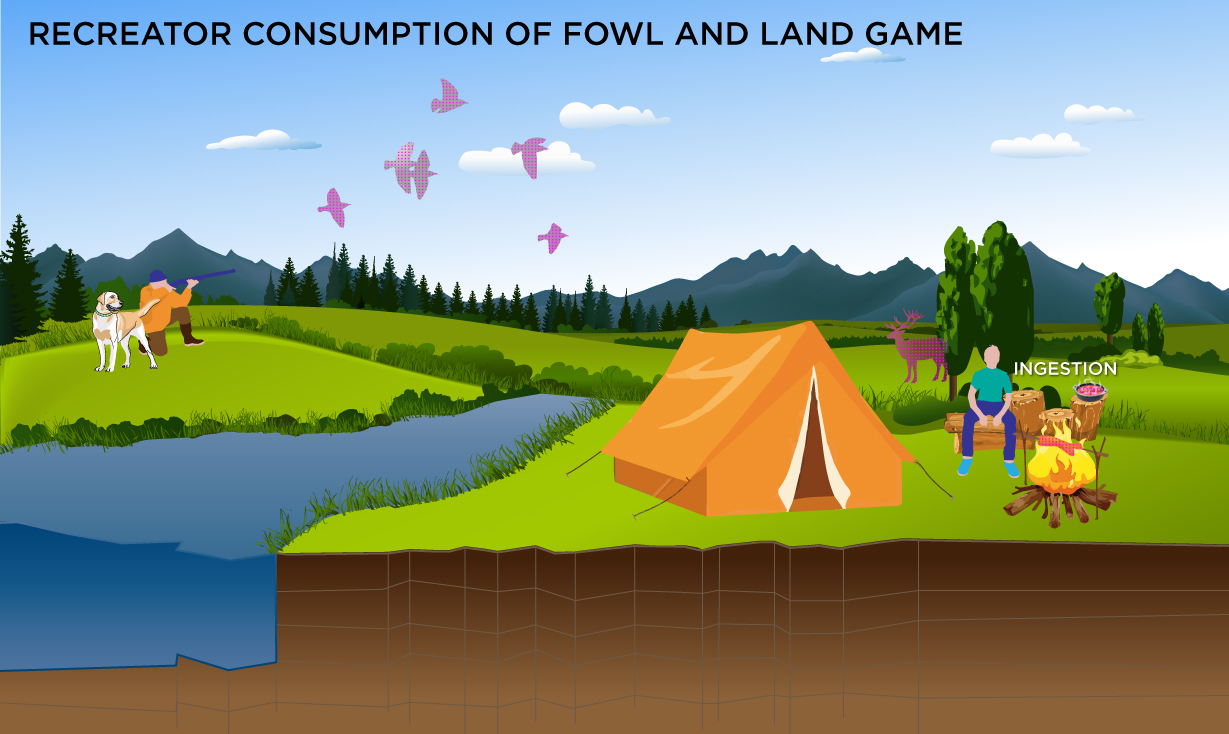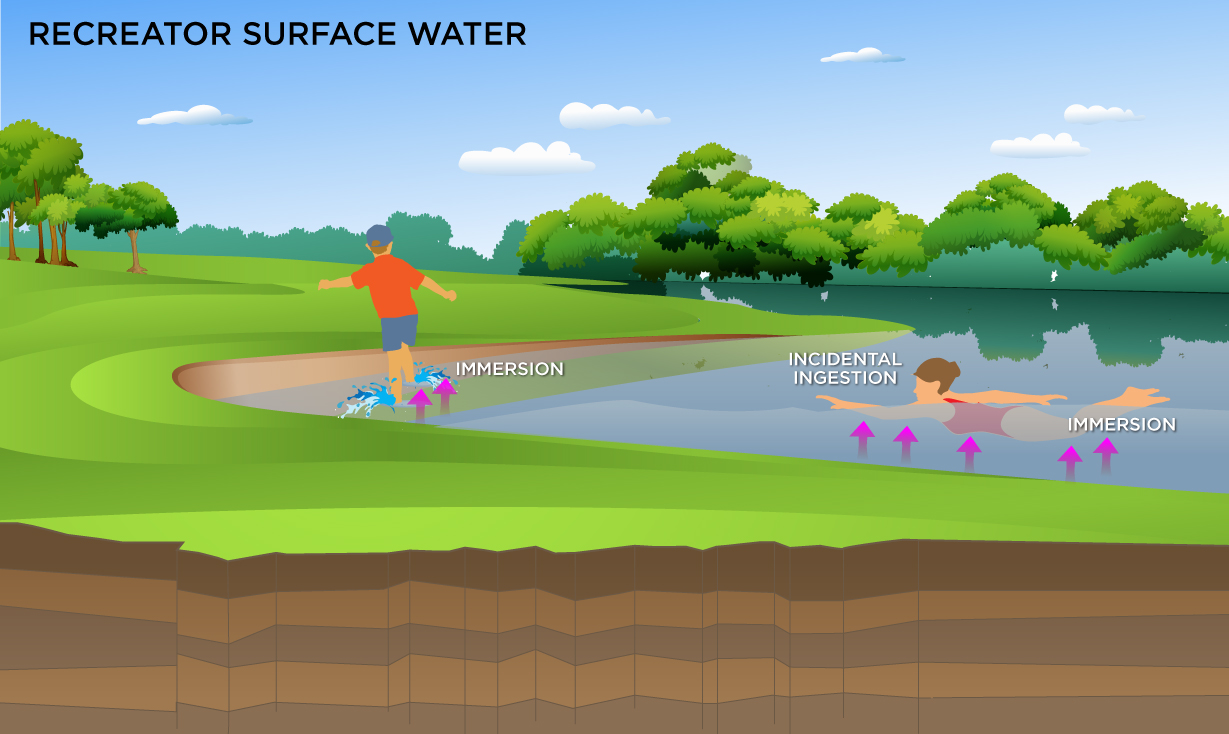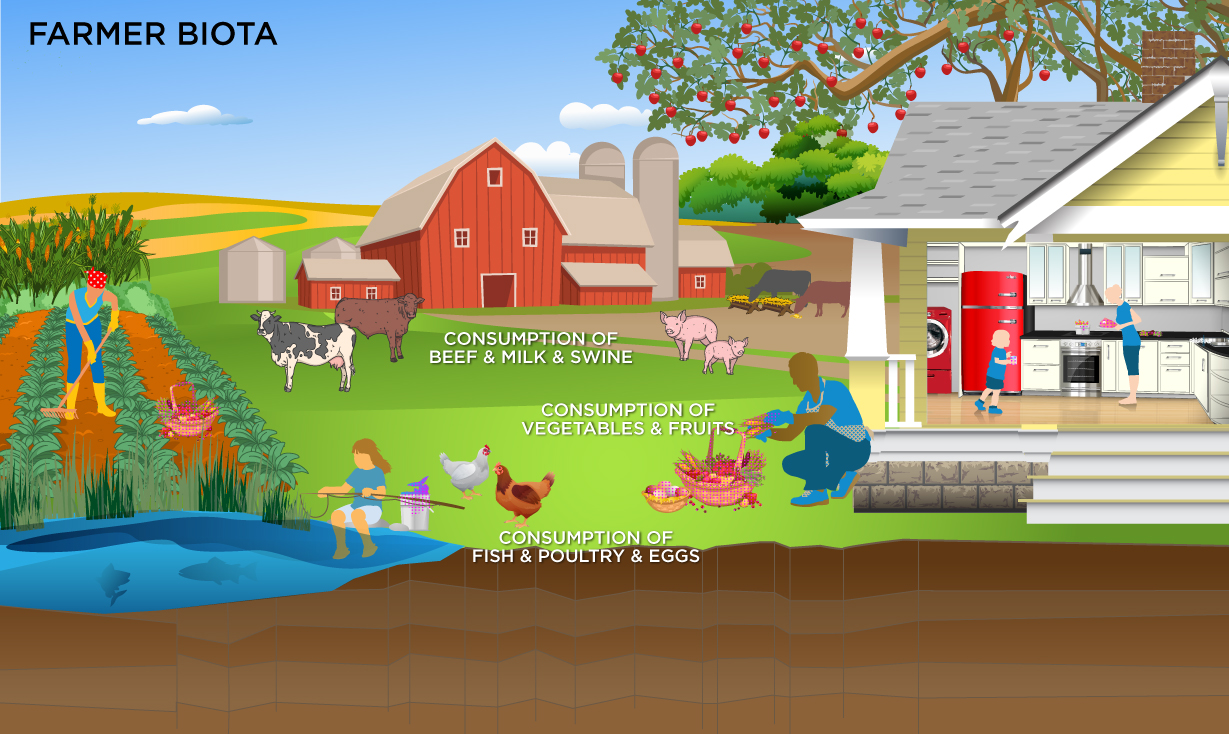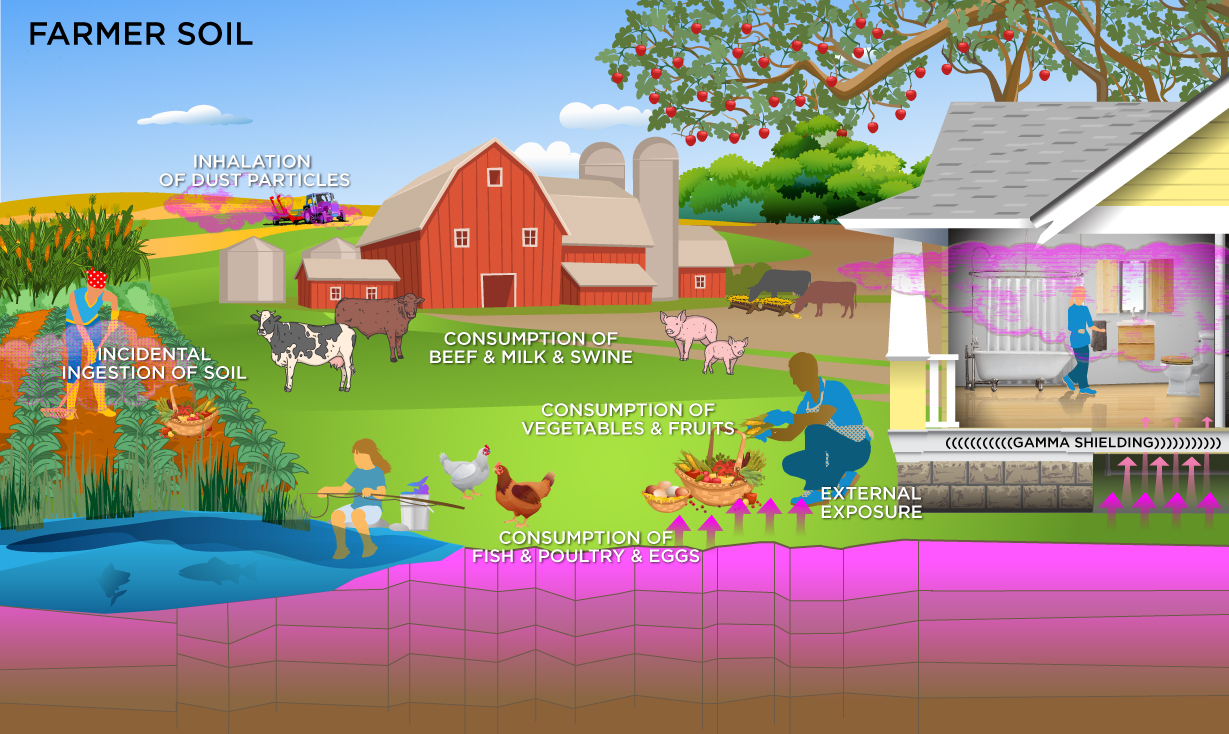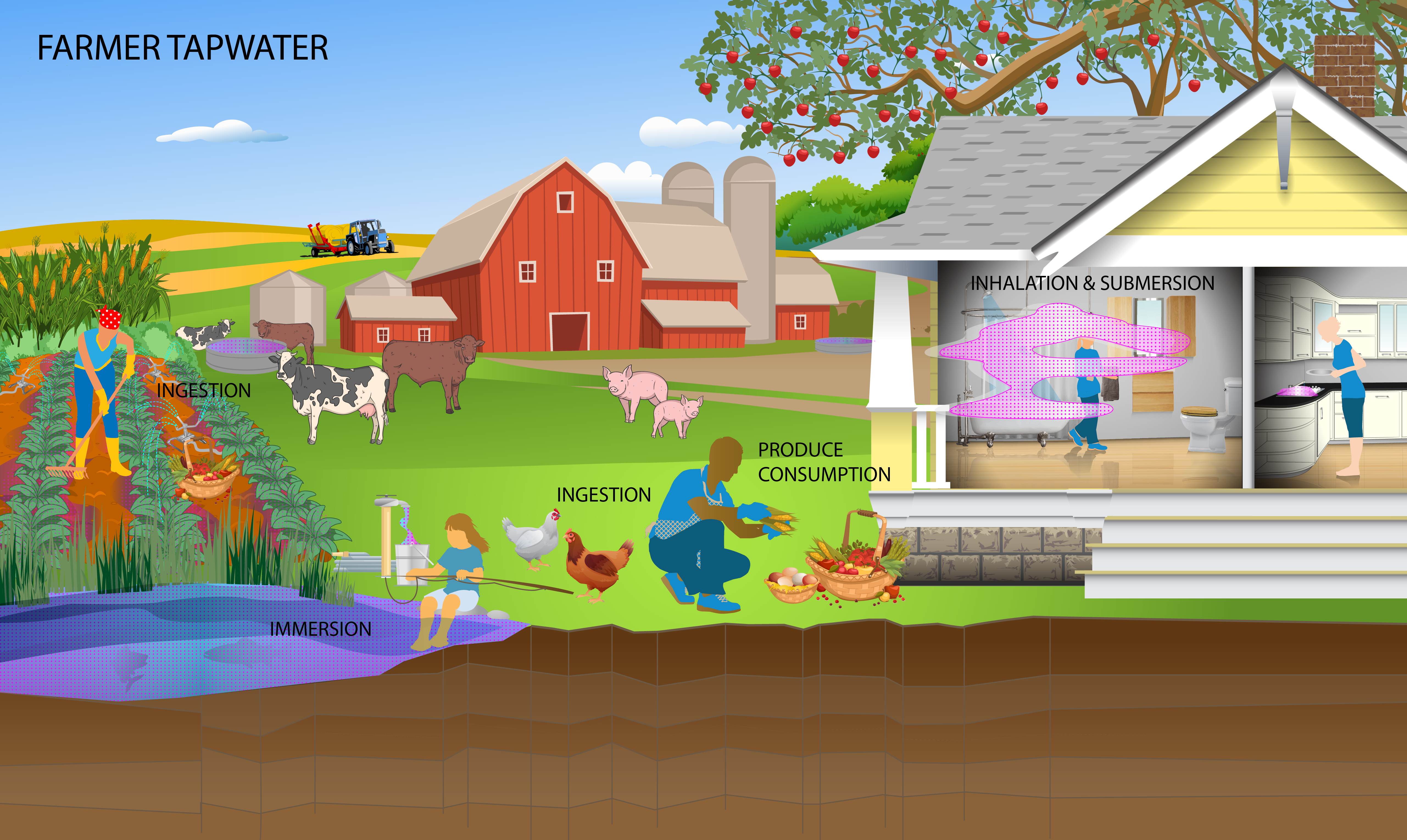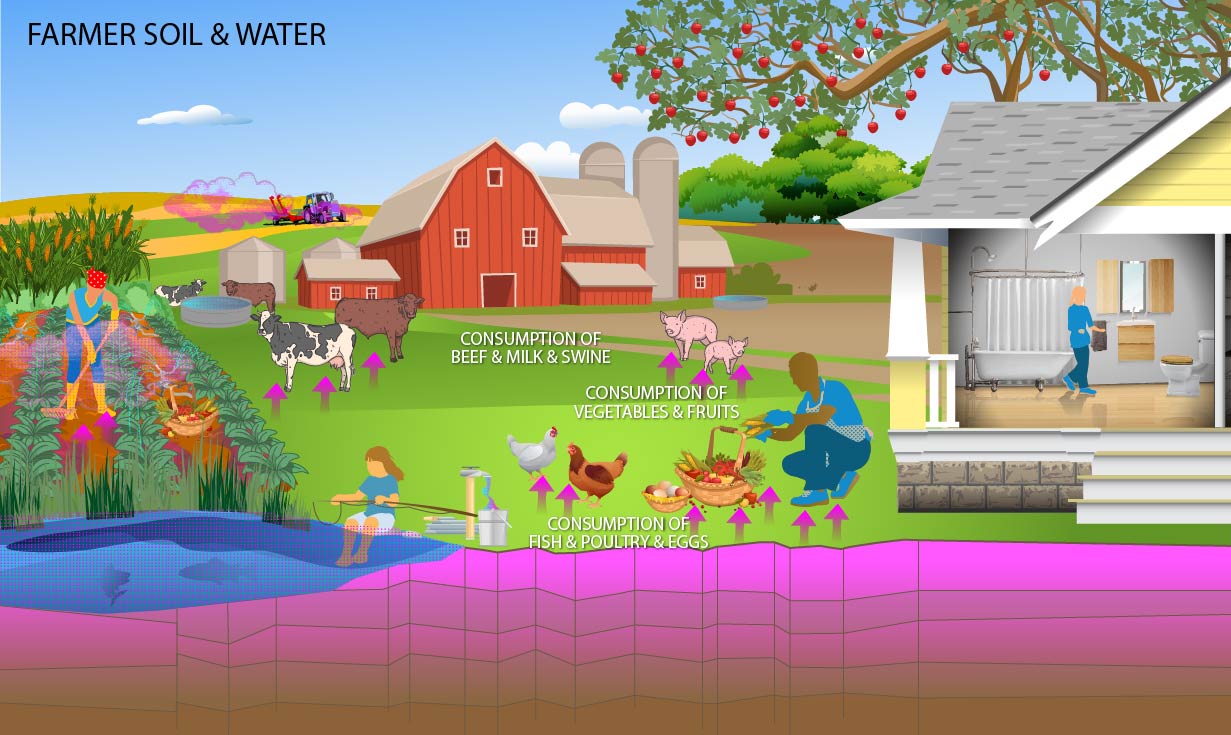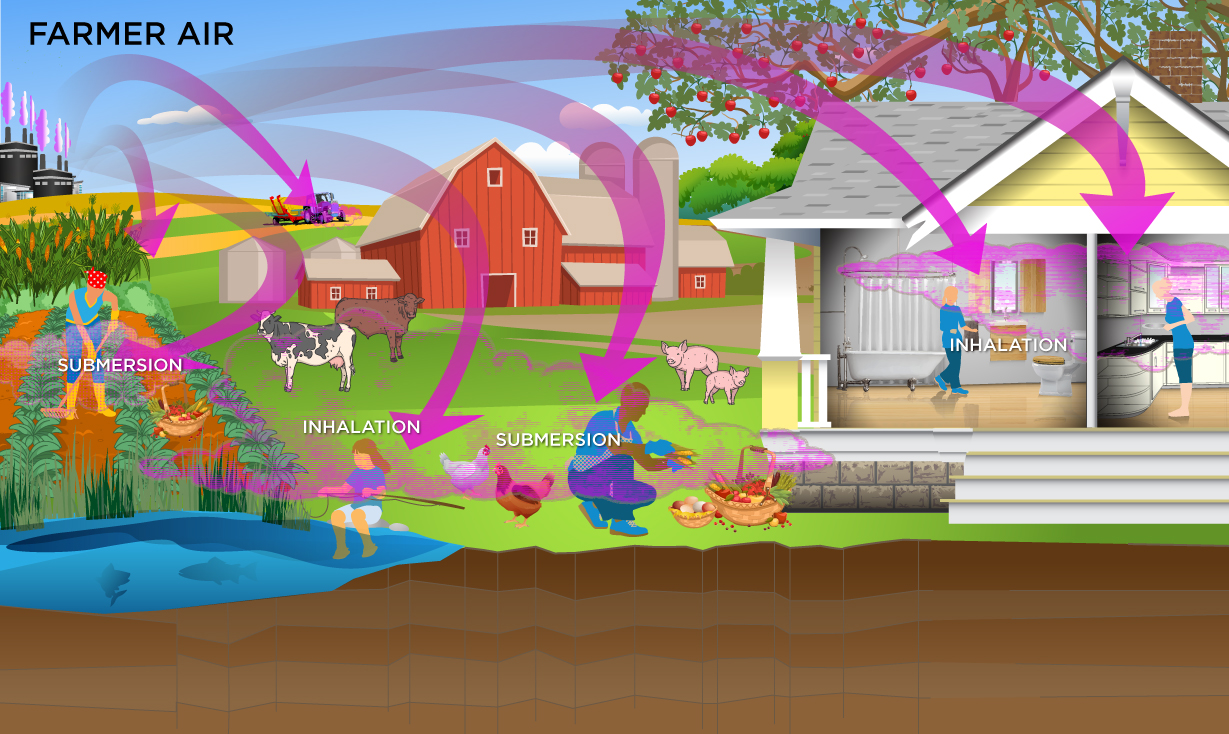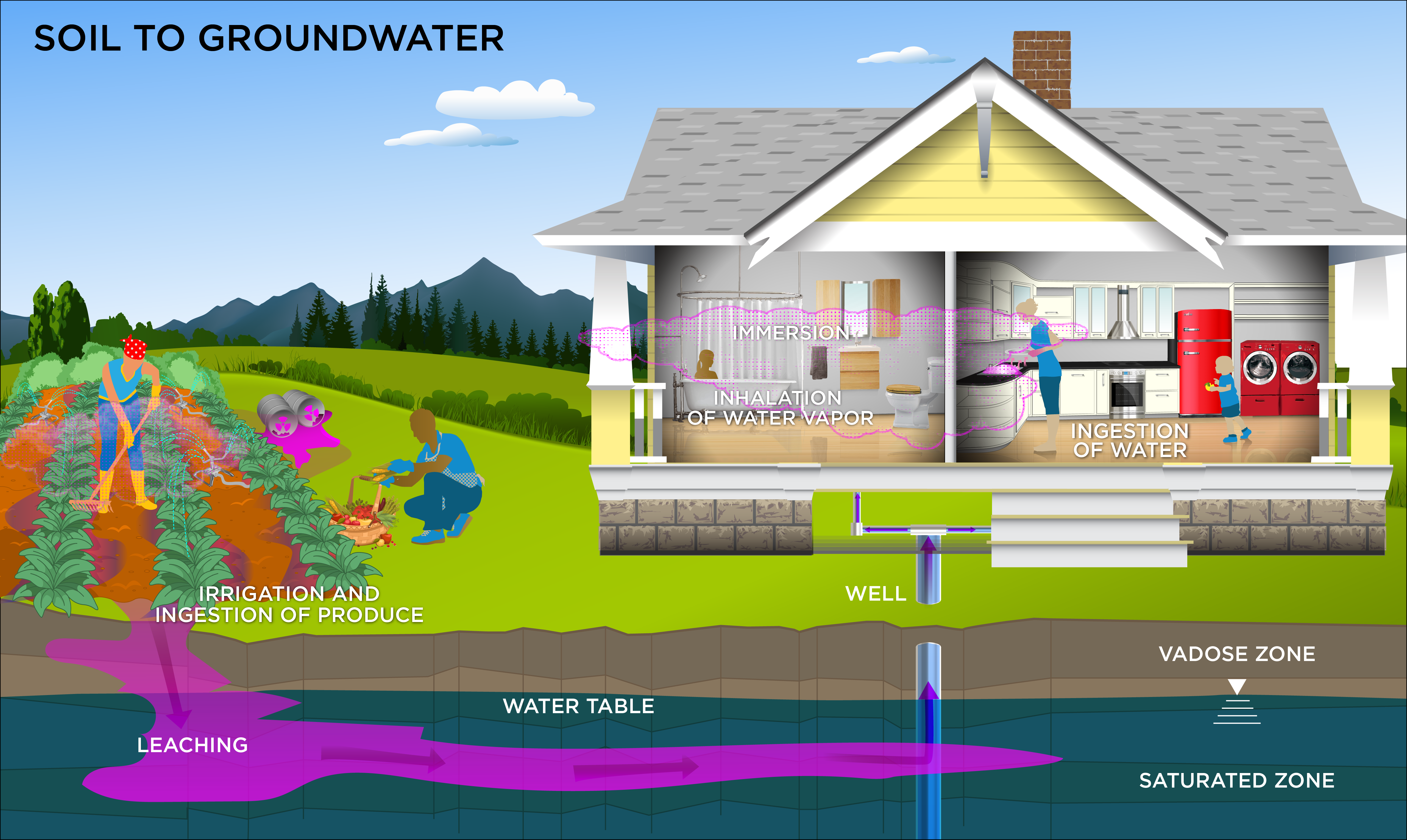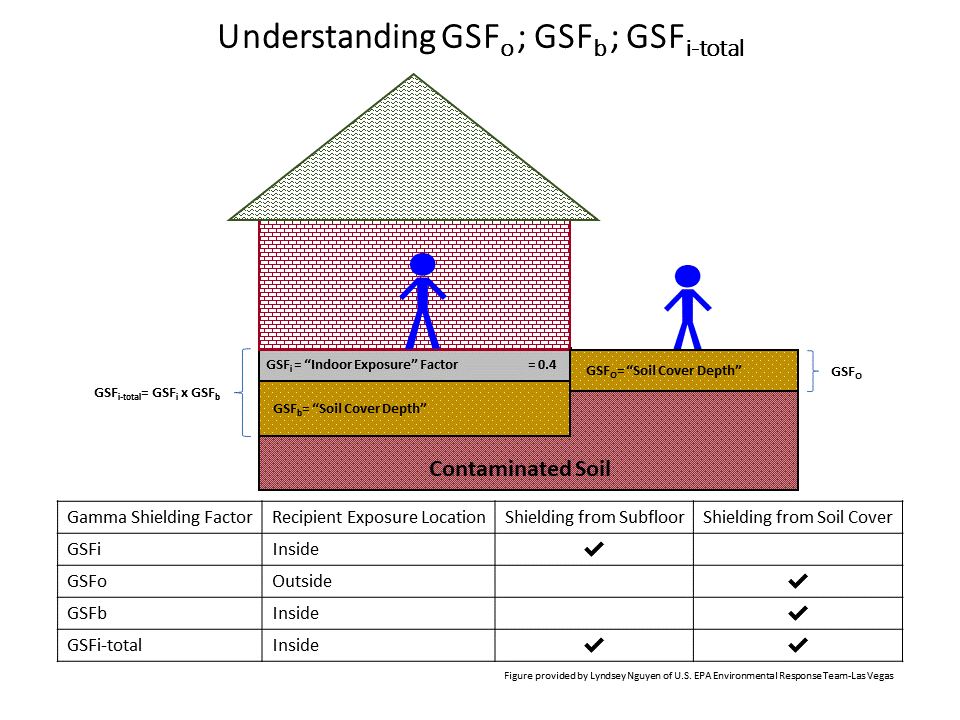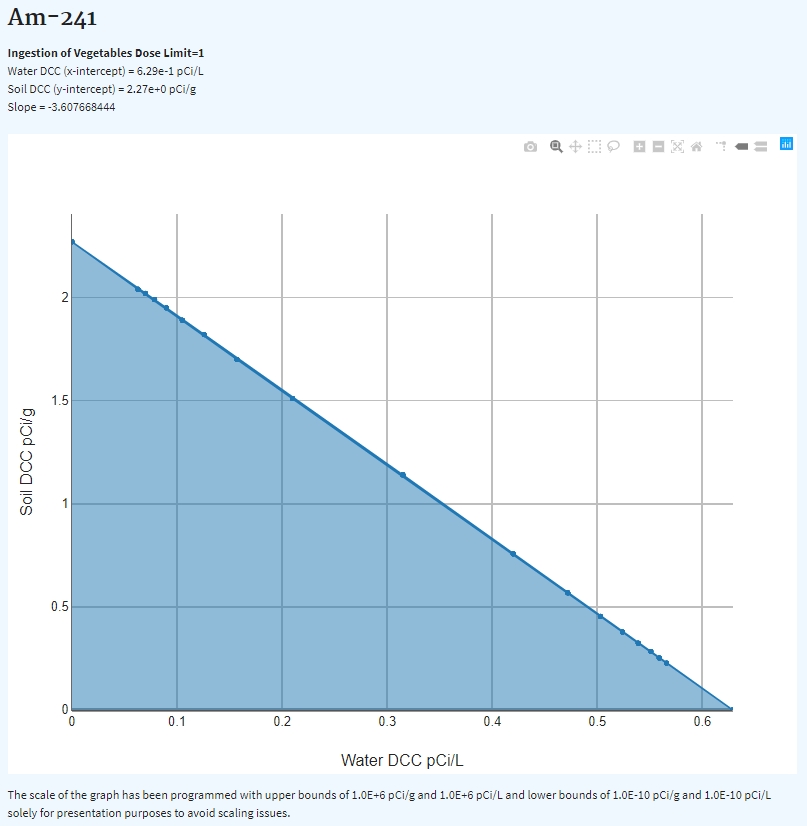page title goes here Risk Assessment
DCC User's Guide
DCCs for
Radionuclides
Welcome to the EPA's "Dose Compliance Concentrations for Radionuclides at Superfund Sites" (DCC) user's guide. Here, you will find descriptions, equations, and default exposure parameters used to calculate the dose-based DCCs. If this is your first time using the DCC Calculator, it is strongly recommended that you first read "Radiation Risk Assessment At CERCLA Sites: Q & A". Additional guidance is also provided on sources of parameters and proper DCC use. It is suggested that users read the DCC FAQ page before proceeding. The user guide is extensive, so please use the "Open All Sections" and "Close All Sections" links below as needed. Individual sections can be opened and closed by clicking on the section titles. Before proceeding through the user's guide, please read the Disclaimer.
Open All Sections | Close All Sections
Disclaimer
This guidance document sets forth recommended approaches based on EPA's best thinking to date with respect to dose assessment for response actions at CERCLA sites. This document does not establish binding rules. Alternative dose assessment approaches may be more appropriate at specific sites (e.g., where site circumstances do not match the underlying assumptions, conditions, and models of the guidance). The decision to use an alternative approach and a description of any such approach should be placed in the Administrative Record for the site. Accordingly, if comments are received at individual sites questioning the use of the approaches recommended in this guidance, the comments should be considered and an explanation provided for the selected approach.
The policies set out in the Radionuclide Applicable or Relevant and Appropriate (ARAR) DCC User Guide provide guidance to EPA staff. It also educates the public and regulated community on how EPA intends the National Oil and Hazardous Substances Pollution Contingency Plan (NCP) be implemented. EPA may change this guidance in the future, as appropriate. This calculator is intended for use by risk assessors, health physicists, and other qualified environmental protection specialists.
It should also be noted that DCCs do not address human cancer risk, noncancer toxicity, or potential ecological risk. Of the radionuclides generally found at CERCLA sites, only uranium has potentially significant noncancer toxicity. When assessing sites with uranium as a contaminant, it may also be necessary to consider the noncancer toxicity of uranium using other tools, such as EPA's Regional Screening Levels (RSLs) for Chemical Contaminants at Superfund Sites electronic calculator for uranium in soil, water, or air and the WTC for uranium inside buildings. EPA's SDCC Calculator should be used to assess radionuclide dose for hard outside surfaces and the BDCC Calculator for radionuclide dose inside buildings. EPA's PRG Calculator should be used to assess radionuclide cancer risk for soil, water, and air; BPRG Calculator for radionuclide cancer risk inside buildings; and the SPRG Calculator for radionuclide cancer risk for hard outside surfaces. Similarly, some sites with radiological contaminants in sensitive ecological settings may also need to be evaluated for potential ecological risk. EPA's guidance "Ecological Risk Assessment Guidance for Superfund: Process for Designing and Conducting Ecological Risk Assessment" contains an eight step process for using benchmarks for ecological effects in the remedy selection process.
This web calculator may be used to develop generic DCCs for radionuclides for several different exposure scenarios. The calculator is flexible and may be used to derive site-specific DCCs as more site characterization is obtained (U.S. EPA 2000a). Models reviewed by EPA in the Soil Screening Guidance for Radionuclides: Technical Background Document are presented in Section 3-2. This report provides a detailed technical analysis of five unsaturated zone fate and transport models for radionuclides. This report supports the information provided in Part 3 - Unsaturated Zone Models for Radionuclide Fate and Transport [PDF 383KB, 25 pages] of the Soil Screening Guidance for Radionuclides: Technical Background Document on determining the general applicability of the models to subsurface conditions and assessing each model's potential applicability to the soil screening process.
1. Introduction
Radionuclide Applicable or Relevant and Appropriate (ARAR) Dose Compliance Concentrations (DCCs) are dose concentrations derived from standardized equations that combine exposure information, assumptions, and dose conversion factors (DCFs). Dose conversion factors (DCFs) (U.S. EPA 1988) , more recently called dose coefficients, are used to calculate dose. For the purposes of this guide we retain the DCF abbreviation.
The Dose Assessment Guidance is a tool that the U.S. Environmental Protection Agency developed to help standardize the evaluation and cleanup of radioactively contaminated sites when doses are being assessed. This guidance provides a methodology for radiation professionals to calculate dose-based, site-specific, dose compliance concentrations (DCCs) for radionuclides that comply with a dose-based standard as an ARAR. This guidance supersedes the dose assessment methodology contained in the Risk Assessment Guidance for Superfund Volume I Human Health Evaluation Manual (Part A) (U.S. EPA 1989).
A number of different radiation standards may be used as Applicable or Relevant and Appropriate Requirements (ARARs) to establish cleanup levels at a site. Cleanup levels may be based on a number of Federal or State ARARs. Federal standards expressed in terms of dose that are potential ARARs at CERCLA sites include 40 CFR Part 190, "Environmental Radiation Protection Standards for Nuclear Power Operations," 40 CFR Part 191, "Environmental Radiation Protection Standards for Management and Disposal of Spent Nuclear Fuel, High-Level and Transuranic Radioactive Wastes," or 10 CFR Part 61, "Licensing Requirements for Land Disposal of Radioactive Waste," among others.
One set of radiation standards consists of a combination of whole body and critical organ dose annual limits, generally either (1) 25 mrem to the whole body, 75 mrem to the thyroid, and 25 mrem to any other critical organ besides the thyroid or (2) 25 mrem to the whole body and 75 mrem to any critical organ (including the thyroid). Another set of annual standards consists of a single limit (e.g., 10 mrem). The type of dose limit used in a particular standard would use the same dose methodology as used for dose assessments to demonstrate ARAR compliance.
The approach to dose limitation and the methods used to calculate doses have evolved over time. The first two radiation protection standards listed above (the 25/75/25 and 25/75 mrem annual dose limits) are based on the older, critical organ concept of dose limitation. This approach limits dose and long-term effects to a specific target tissue or organ (e.g., the thyroid), the most radiosensitive tissue or organ, or the tissue or organ receiving the highest dose. Under this approach, introduced in 1959 by the International Commission on Radiological Protection (ICRP) in its Publication 2, "Report of Committee II on Permissible Dose for Internal Radiation" (ICRP 1959), the dose to an organ from internally-deposited radionuclides is calculated separately from the dose due to external exposure, and the whole body is essentially treated as one of the critical organs.
Later, standards were based on the effective dose equivalent concept of dose limitation, introduced in 1977 by the ICRP in its Publication 26, "Recommendations of the International Commission on Radiological Protection" (ICRP 1977). The effective dose equivalent approach accounts for the differences in the cancer induction rates in organs and tissues subjected to equal doses of radiation and normalizes these doses and effects on a whole body basis. Under this approach, the effective dose equivalent dose is calculated as the weighted sum of the committed dose equivalents (from ingested and inhaled radionuclides) and the dose equivalent (for external exposure from photon-emitting radionuclides) to all organs and tissues. The weighting factors used in these calculations are organ-specific and correspond to the fractional contribution of each organ or tissue to the total risk of fatal cancers when the body is uniformly irradiated. Thus, the summation of all organ and tissue factors is equal to one.
ICRP has since updated the effective dose equivalent concept with the introduction of effective dose quantity in its Publication 60, "1990 recommendations of the International Commission on Radiological Protection" (ICRP 1991). While similar to the effective dose equivalent approach, the effective dose quantity incorporates updated scientific information in the dose conversion factors. Effective dose quantity incorporates a greater number of organs, updated information on organ-specific risk, and age-specific dose coefficients for internal exposure that incorporate new physiologically-based biokinetic models.
ICRP Publication 107 (ICRP 2008) provides an electronic database of the physical data for calculations of radionuclide-specific protection and operational quantities. This database supersedes the data of ICRP 38 and will be used in future ICRP publications of dose coefficients for the intake of or exposure to radionuclides in the workplace and the environment.
The purpose of this document is to guide EPA personnel in calculating release criteria based on regulations promulgated under various methods of dose calculation. This guidance will relate these dose limits to a single measure (i.e., cleanup concentration). This guidance will assist RPMs in making decisions at these sites.
Note: use of this calculator to develop dose compliance concentrations for some dose-based ARARs does not affect the CERCLA requirement to comply with all other Federal and State ARARs at a site (e.g., 40 CFR 141.66, 40 CFR 192.12). ARARs are determined site-specifically. For a list of "Likely Federal Radiation Applicable or Relevant and Appropriate (ARARs)", see Attachment A of EPA's guidance "Establishment of Cleanup Levels for CERCLA sites with Radioactive Contamination." For additional guidance documents on compliance with ARARs at radioactively contaminated sites, see https://www.epa.gov/superfund/radiation-superfund-sites.
This website combines current EPA DCFs with "standard" exposure factors to estimate contaminant concentrations in environmental media (biota, air, soil, and water) that are protective of humans(including sensitive groups) over a lifetime. Sufficient knowledge about a given site may warrant the use of site-specific assumptions that may differ from the defaults. Exceeding a DCC usually suggests that further evaluation of the potential doses is appropriate. The DCCs presented on this website can be used to screen pollutants in environmental media, trigger further investigation, and provide initial cleanup goals, if applicable. DCCs should be applied in accordance with guidance from EPA Regions.
In addition to this guidance, for relevant training, see the internet-based course "Radiation Risk Assessment: Updates and Tools".
2. Understanding the DCC Website
This website offers the ability to quickly look up or calculate DCCs. Within the DCCs are many complex models that require a greater understanding when using the calculator in site-specific mode. The sections that follow expand upon these models and should be consulted before generating site-specific DCCs.
2.1 General Considerations
DCCs are radionuclide concentrations that correspond to annual levels of dose from exposure to air, soil, water, and biota. The DCCs, regardless of land use, are based on annual dose and differ from PRGs which are based on 26 years for resident, 25 years for workers (except construction worker), and 40 years for farmer. Dose Coefficients (DCFs) represent the dose equivalent per unit intake (i.e., ingestion or inhalation) or external exposure for a given radionuclide. In dose assessments, these DCFs are used in calculations with radionuclide concentrations and exposure assumptions to estimate dose from exposure to radioactive contamination. The calculations may be rearranged to generate DCCs for a specified level of dose. DCFs may be specified for specific body organs or tissues of interest or as a weighted sum of individual organ dose, termed the effective dose equivalent. These DCFs may be multiplied by the total activity of each radionuclide inhaled or ingested per year or the external exposure concentration to which a receptor may be exposed to estimate the dose to the receptor. Dose Coefficients used are provided by the Center for Radiation Protection Knowledge. The main report is Calculations of Slope Factors and Dose Coefficients, and the tables of DCFs are in a separate appendix.
Inhalation dose coefficients are tabulated separately for each of the three lung absorption types considered in the lung model currently recommended by the International Commission on Radiological Protection (ICRP) and, where appropriate, for inhalation of radionuclides in vapor or gaseous forms.
The designations "F", "M", and "S" (expressed as fast (F), medium (M), or slow (S)) presented in the Radionuclide Table under the heading "ICRP Lung Type" refer to the lung absorption type for inhaled particulate radionuclides used in the current ICRP model of the respiratory tract. The inhalation dose coefficient values tabulated in the Radionuclide Table for each radionuclide have been selected based on the following guidelines: (1) for those elements where Table 4.1 of Federal Guidance Report No. 13 (and Table 2 of ICRP Publication 72) specifies a recommended default lung absorption type for particulates, the inhalation dose coefficient for that type is tabulated in the Radionuclide Table for each radioisotope of that element; (2) for those elements where no specific lung absorption type is recommended and multiple types are indicated as plausible choices, the inhalation dose coefficient reported in the Radionuclide Table for each radioisotope of that element is the maximum of the values for each of the plausible lung absorption types; and (3) where Federal Guidance Report No. 13 specifies risk coefficients for multiple chemical forms of certain elements (tritium, carbon, sulfur, iodine, and mercury), the inhalation dose coefficient value for the form estimated to pose the maximum dose is reported in the Radionuclide Table in most cases.
Inhaled particulates are assumed to have an activity median aerodynamic diameter (AMAD) of 1 um, as recommended by the ICRP for consideration of environmental exposures in the absence of specific information about physical characteristics of the aerosol. Where appropriate, radionuclides may be present in gas or vapor form, designated by "G" and "V", respectively; such radionuclides include tritium, carbon, sulfur, nickel, ruthenium, iodine, tellurium, and mercury.
The most common land uses and exposure assumptions are included in the equations on this website: Resident Soil, Composite Worker Soil, Outdoor Worker Soil, Indoor Worker Soil, Construction worker Soil, Farmer Soil, Recreator Soil, Resident Air, Composite Worker Air, Outdoor Worker Air, Indoor Worker Air, Construction worker Air, Farmer Air, Recreator Air, Tap Water, Soil to Groundwater, and Ingestion of Fish.
The DCCs are generated with standard exposure route equations using EPA DCFs and exposure parameters. Exposures to other media can be addressed by other calculators. For exposure to contaminated materials inside and outside buildings, use the BDCC (Dose Compliance Concentrations for Radionuclides in Buildings at Superfund Sites) and the SDCC (Dose Compliance Concentrations for Radionuclides on Outdoor Surfaces at Superfund Sites), respectively. A DCC calculator receptor represents the reasonably maximum exposed (RME) individual, as does a BDCC receptor. Since the DCC RME is often outside and the BDCC RME is always indoors, an individual receiving both indoor and outdoor exposures at a site should be protected when both tools are used.
For the calculation of dose conversion factors, area correction factors, and gamma shielding factors, a standard soil density of 1.6 g/cm3 has been used.
2.2 DCC Output Options
The calculator offers four options for calculating DCCs. Previous versions of this calculator employed dose coefficients that included progeny ingrowth for 100 years, designated "+D." The +D dose coefficients are no longer included in the pick list. See section 2.9.2 to learn more. The DCCs presented in sections 2.2.1 and 2.2.2 independently model progeny during migration to groundwater and biota uptake, while the +D DCCs did not. This section describes the potential applications of the four choices and recommends a default DCC calculation.
2.2.1 DCC Output Option #1: Assumes period of peak dose (with decay and progeny ingrowth)(Peak DCC)
This is the preferred DCC calculation option and is marked as the default selection in the calculator. The Peak DCC is calculated for the time period when the parent and progeny activities present the most dose. The underlying assumption of the Peak DCC option is that a pure isotope was released and progeny begin ingrowth and decay. This DCC is protective, as future progeny may contribute more dose than the parent. When a single isotope is selected, the calculator identifies all the progeny in the chain. The DCCs for each progeny are combined with the parent based on their fractional contribution (FC). The FC is determined by branching fractions, where a progeny may decay into more than one isotope. Section 2.2.2 provides detail on calculating the FC. Unlike previous DCC output options that included progeny contribution (i.e., +D DCCs as discussed in section 2.9.2.), the Peak DCC models each progeny independently of the parent for half-life, migration to groundwater, and biota uptake. The DCC provided in the output is the inverse sum of the reciprocal DCCs of the parent and all the progeny present at the period of peak dose. All the DCC equation images are presented without a radioactive decay term; however, decay and ingrowth is included in this DCC option.
When the Peak DCC output option is selected, the DCC Calculator shows the individual progeny contributions for the total DCC. At the top of the output page, the results are separated into tabs by media. In the Peak DCC output, the individual exposure routes are presented separately. This is done to help determine the exposure routes that are drivers and may help to focus site-specific remedial efforts. The period of peak dose may differ for some exposure routes (e.g., external, soil ingestion, food ingestion, and inhalation) as well as the total Peak DCC. Forward dose calculations are also available for this output option.
The Peak DCC output option can be run for an infinite time period or a user-defined time period.
2.2.1.1 Infinite Time
The default setting for the Peak DCC option is to search for the period of peak dose out to infinity. To accomplish this, the Peak DCC uses a Bateman solver to determine the parent and progeny activities out to a trillion years. This isotopic activity curve is then converted to dose; another routine selects the time period with the most dose from parent and progeny and determines the parent activity (DCC) that would represent the target dose. Users should note that for long-lived isotopes that have a peak dose that begins in the future, progeny are likely already ingrown, and the secular equilibrium (SE) DCCs may be appropriate. This ORNL Technical Memorandum offers explanation of the derivation of the Peak DCCs.
2.2.1.2 User-defined Time Period
The user may also select a defined time period to search for the period of peak dose. This option operates just like the infinite time option but stops searching for the period of peak dose at a user-defined time in the future. Predefined time points of 10,000, 1,000, and 100 years are offered as well as the option for the user to enter a specific time period between 70 and one trillion years. These options are only offered for use in certain situations where a regulatory agency is concerned with dose at certain time points in the future. If a peak hasn't been resolved in the entered time period, as is the case when progeny are still ingrowing, the dose interval will be calculated for the last exposure duration span. For instance, if the time period of 100 years is selected for default resident soil for U-238 (ED of 1 year), year 100 will be selected by default, because U-238 peak dose isn't until year 3,981,072.
User-defined time periods should only be considered when a purified radionuclide was recently disposed or released. These time periods should not be considered when a radionuclide has been present long enough for progeny to ingrow (e.g., uranium, thorium, and radium as ore material) or was recently disposed or released. The default selection of infinity is the preferred option for use on Superfund sites being remediated for unrestricted future land uses.
Click Here for a Tutorial on Understanding Peak DCC Graphs
The following images provide instructions for exploring and understanding the peak dose graphs.
2.2.2 DCC Output Option #2: Assumes Secular Equilibrium Throughout the Chain (no decay - parent and progeny in constant equilibrium)
This was the default DCC calculation option prior to the release of the Peak DCC. When a single isotope is selected, the calculator identifies all the progeny in the chain. The DCCs for each progeny are combined with the parent based on their FC. The FC is determined by branching fractions, where a progeny may decay into more than one isotope. The FC calculation process is described later in this section. The resulting DCC is now based on secular equilibrium of the full chain. For straight chain decay, all the progeny would be at the same activity of the parent, and the DCC provided in the output would be the inverse sum of the reciprocal DCCs of the parent and all the progeny. Unlike previous DCC output options that included progeny contribution (i.e., +D DCCs as discussed in section 2.9.2.), the secular equilibrium DCC models each progeny independently of the parent for half-life, migration to groundwater, and biota uptake. All the soil DCC equation images are presented without a radioactive decay term. Decay is not included in this DCC option, as the assumption of secular equilibrium is that the parent is continually being renewed.
When the secular equilibrium DCC output option is selected, the DCC Calculator now gives the option to show the individual progeny contributions for the DCC (and dose) output. When the option to display progeny contribution is selected, the DCC Calculator output gives the secular equilibrium DCC and the individual progeny DCCs in separate tables.
A total DCC is calculated using the following formula:
The EPA Decay Chain tool provides the branching fractions for each radionuclide's decay chain, based on the ICRP 107 data. The branching fractions presented for non-converging chains are used directly in the DCC equation above for the FC (fractional contribution) term. Convergence in a chain is when there are multiple decay pathways to a particular isotope or when multiple isotopes can decay to a particular isotope. When a chain converges, as is the case with the Ra-226 chain, the effect of multiple branches needs to be taken into account. Consider the branching fractions in the Ra-226 decay chain in the table below.
Nuclide Half-life Mode Mass Branching
FractionProgeny Branching
FractionProgeny Ra-226 1600 years A 226.025409 1.00e+0 Rn-222 Rn-222 3.8235 days A 222.017577 1.00e+0 Po-218 Po-218 3.10 minutes B-,A 218.008973 1.00e+0 Pb-214 2.00e-4 At-218 Pb-214 26.8 minutes B- 213.999805 1.00e+0 Bi-214 At-218 1.5 seconds A,B- 218.008694 9.99e-1 Bi-214 1.00e-3 Rn-218 Bi-214 19.9 minutes B-,A 213.998711 1.00e+0 Po-214 2.10e-4 Tl-210 Rn-218 3.50e-2 seconds A 218.005601 1.00e+0 Po-214 Po-214 1.64e-4 seconds A 213.995201 1.00e+0 Pb-210 Tl-210 1.3 minutes B- 209.990073 1.00e+0 Pb-210 Pb-210 22.2 years B-,A 209.984188 1.00e+0 Bi-210 1.90e-8 Hg-206 Bi-210 5.01 days B-,A 209.984120 1.00e+0 Po-210 1.32e-6 Tl-206 Hg-206 8.15 minutes B- 205.977514 1.00e+0 Tl-206 Po-210 138.38 days A 209.982873 1.00e+0 Stable Pb-206 Tl-206 4.2 minutes B- 205.976110 1.00e+0 Stable Pb-206 For example, the branching fraction presented in the above table, for At-218 decaying to Rn-218, is 0.1% (0.001 or 1.0E-03); however, this isn't the complete picture, because At-218 appears in the chain as only 0.02% of Po-218 decay. To determine the true fractional contribution of Rn-218 to the whole chain, multiply the two branching fraction ratios together as follows: (2.0E-04 x 1.0E-03 = 2.0E-07). Technically, to calculate the fractional contribution of each isotope in a chain, each unique pathway to that isotope should have its branching fractions multiplied together and each result summed. The tables below present this process for At-218, Rn-218, Tl-210, Hg-206, and Tl-206, respectively. The FCs for the other progeny are all 1.0.
Determination of Fractional Contribution (FC) from Converging Branching Fractions in the Ra-226 Decay Chain. At-218 FC Ra-226
to
Rn-222Rn-222
to
Po-218Po-218
to
At-218Fraction 1 1 2.00E-04 2.00E-04 Total FC 2.00E-04 Rn-218 FC Ra-226
to
Rn-222Rn-222
to
Po-218Po-218
to
At-218At-218
to
Rn-218Fraction 1 1 2.00E-04 1.00E-03 2.00E-07 Total FC 2.00E-07 Tl-210 FC Ra-226
to
Rn-222Rn-222
to
Po-218Po-218
to
At-218At-218
to
Bi-214Bi-214
to
Tl-210Fraction 1 1 2.00E-04 1 2.10E-04 4.20E-08 Ra-226
to
Rn-222Rn-222
to
Po-218Po-218
to
Pb-214Pb-214
to
Bi-214Bi-214
to
Tl-2101 1 1 1 2.10E-04 2.10E-04 Total FC 2.10E-04 Hg-206 FC Ra-226
to
Rn-222Rn-222
to
Po-218Po-218
to
At-218At-218
to
Rn-218Rn-218
to
Po-214Po-214
to
Pb-210Pb-210
to
Hg-206Fraction 1 1 2.00E-04 1.00E-03 1 1 1.90E-08 3.8E-15 Ra-226
to
Rn-222Rn-222
to
Po-218Po-218
to
At-218At-218
to
Bi-214Bi-214
to
Po-214Po-214
to
Pb-210Pb-210
to
Hg-2061 1 2.00E-04 1 1 1 1.90E-08 3.8E-12 Ra-226
to
Rn-222Rn-222
to
Po-218Po-218
to
At-218At-218
to
Bi-214Bi-214
to
Tl-210Tl-210
to
Pb-210Pb-210
to
Hg-2061 1 2.00E-04 1 1 1 1.90E-08 3.8E-12 Ra-226
to
Rn-222Rn-222
to
Po-218Po-218
to
Pb-214Pb-214
to
Bi-214Bi-214
to
Po-214Po-214
to
Pb-210Pb-210
to
Hg-2061 1 1 1 1 1 1.90E-08 1.90E-08 Ra-226
to
Rn-222Rn-222
to
Po-218Po-218
to
Pb-214Pb-214
to
Bi-214Bi-214
to
Tl-210Tl-210
to
Pb-210Pb-210
to
Hg-2061 1 1 1 2.10E-04 1 1.90E-08 3.99E-12 Total FC 1.90E-08 Tl-206 FC Ra-226
to
Rn-222Rn-222
to
Po-218Po-218
to
At-218At-218
to
Rn-218Rn-218
to
Po-214Po-214
to
Pb-210Pb-210
to
Bi-210Bi-210
to
Tl-206Fraction 1 1 2.00E-04 1.00E-03 1 1 1.00E+00 1.32E-06 2.64E-13 Ra-226
to
Rn-222Rn-222
to
Po-218Po-218
to
At-218At-218
to
Rn-218Rn-218
to
Po-214Po-214
to
Pb-210Pb-210
to
Hg-206Hg-206
to
Tl-2061 1 2.00E-04 1.00E-03 1 1 1.90E-08 1.00E+00 3.80E-15 Ra-226
to
Rn-222Rn-222
to
Po-218Po-218
to
At-218At-218
to
Bi-214Bi-214
to
Po-214Po-214
to
Pb-210Pb-210
to
Bi-210Bi-210
to
Tl-2061 1 2.00E-04 1 1 1 1.00E+00 1.32E-06 2.64E-10 Ra-226
to
Rn-222Rn-222
to
Po-218Po-218
to
At-218At-218
to
Bi-214Bi-214
to
Po-214Po-214
to
Pb-210Pb-210
to
Hg-206Hg-206
to
Tl-2061 1 2.00E-04 1 1 1 1.90E-08 1.00E+00 3.80E-12 Ra-226
to
Rn-222Rn-222
to
Po-218Po-218
to
At-218At-218
to
Bi-214Bi-214
to
Tl-210Tl-210
to
Pb-210Pb-210
to
Bi-210Bi-210
to
Tl-2061 1 2.00E-04 1 2.10E-04 1 1.00E+00 1.32E-06 5.54E-14 Ra-226
to
Rn-222Rn-222
to
Po-218Po-218
to
At-218At-218
to
Bi-214Bi-214
to
Tl-210Tl-210
to
Pb-210Pb-210
to
Hg-206Hg-206
to
Tl-2061 1 2.00E-04 1 2.10E-04 1 1.90E-08 1.00E+00 7.98E-16 Ra-226
to
Rn-222Rn-222
to
Po-218Po-218
to
Pb-214Pb-214
to
Bi-214Bi-214
to
Po-214Po-214
to
Pb-210Pb-210
to
Bi-210Bi-210
to
Tl-2061 1 1 1 1 1 1.00E+00 1.32E-06 1.32E-06 Ra-226
to
Rn-222Rn-222
to
Po-218Po-218
to
Pb-214Pb-214
to
Bi-214Bi-214
to
Po-214Po-214
to
Pb-210Pb-210
to
Hg-206Hg-206
to
Tl-2061 1 1 1 1 1 1.90E-08 1.00E+00 1.90E-08 Ra-226
to
Rn-222Rn-222
to
Po-218Po-218
to
Pb-214Pb-214
to
Bi-214Bi-214
to
Tl-210Tl-210
to
Pb-210Pb-210
to
Bi-210Bi-210
to
Tl-2061 1 1 1 2.10E-04 1 1.00E+00 1.32E-06 2.77E-10 Ra-226
to
Rn-222Rn-222
to
Po-218Po-218
to
Pb-214Pb-214
to
Bi-214Bi-214
to
Tl-210Tl-210
to
Pb-210Pb-210
to
Hg-206Hg-206
to
Tl-2061 1 1 1 2.10E-04 1 1.90E-08 1.00E+00 3.99E-12 Total FC 1.34E-06 2.2.3 DCC Output Option #3: Does Not Assume Secular Equilibrium, Provides Results for Progeny Throughout Chain (with decay where appropriate)
This option displays the DCCs calculated with half-life decay that accounts for half-lives shorter than the exposure duration. See section 4.10.7 to learn more about the half-life decay function. In addition to the selected isotope, all the individual progeny DCCs are displayed. Each DCC is determined with each isotope's respective half-life and not that of its parent isotope. This option does not assume secular equilibrium and presents all the individual progeny DCCs, so that the dose or risk assessor can identify any isotopes that will be present and those that have no data. Users can alter progeny half-life to match the parent isotope or other progeny or to account for ingrowth and decay over a chain. The individual isotope DCCs then would be combined (using the inverse sum of reciprocals method described in section 2.9.2) to give a parent DCC protective of progeny ingrowth.
2.2.4 DCC Output Option #4: Does Not Assume Secular Equilibrium, Selected Isotopes Only (with decay where appropriate)
This option displays DCCs for only the selected isotopes with half-life decay that accounts for half-lives shorter than the exposure duration. See section 4.10.7 to learn more about the half-life decay function. In this output, secular equilibrium is not assumed, progeny DCCs are not displayed, and progeny contribution is not combined into the DCC for the selected isotope. This option is useful when contamination is from one radionuclide with a very long half-life, where secular equilibrium would be too conservative.
2.2.5 Comparison of Peak DCC to the other 3 DCC Output Options
The Peak DCC output option returns results that are similar to one of the three other output options, but it varies as to which of these 3 output options provides results that most resemble the Peak DCC results. For example, some transuranic isotopes (TRUs), such as Pu-238, Pu-239, Pu-240, and Am-241, have relatively short half lives in comparison to subsequent progeny. In such cases, equilibrium is not achieved. The activity of the relatively long-lived progeny grows in slowly, in some cases taking thousands of years to reach a significant fraction of the total activity. Furthermore, the activity of the progeny only reaches a small fraction of the parent's initial activity. For example, U-234 reaches a maximum activity of about 0.04 percent of the initial Pu-238 activity at approximately 1000 years. As such, the DCC for the parent only option is very similar to that of the Peak DCC option.
Conversely, secular equilibrium (SE) only occurs when the half-life of the progeny is much shorter than the half-life of the parent. When the progeny has a longer half-life than the parent, equilibrium does not exist. The assumption of SE in these cases significantly overestimates the activity of the progeny, resulting in a much lower DCC.
The following table presents a comparison of the default composite worker soil DCC options for Pu-238, Pu-239, Pu-240, and Am-241 and their long-lived progeny U-234, U-235, U-236, and Np-237, respectively. This table shows that each parent has a half-life about four orders of magnitude shorter than its progeny. As expected, of the three DCC options presented, the SE DCC is always the most protective (smallest). For the TRU isotopes, the peak and the parent only DCCs are shown to be essentially identical; for the long-lived progeny, the SE and Peak DCC are more closely related. Also, of interest is that the SE DCCs for the TRU isotopes and their long-lived progeny are very similar but slightly more protective than the TRU isotope DCCs. This is expected, as the dose contribution to the parent DCC is only different by one isotope in a long chain.
Isotope Half-life (years) Parent only DCC (pCi/g) SE DCC (pCi/g) Peak DCC (pCi/g) Transuranics With Relative Short Half-lives Compared to Progeny Am-241 4.32E+02 3.49E+01 1.47E+00 3.49E+01 Pu-238 8.77E+01 4.44E+01 3.80E-01 4.44E+01 Pu-239 2.41E+04 4.01E+01 1.26E+00 4.01E+01 Pu-240 6.56E+03 4.02E+01 2.98E-01 4.02E+01 Long-lived Progeny of Transuranics Above, Respectively Np-237 2.14E+06 3.94E+01 1.53E+00 1.88E+00 U-234 2.46E+05 2.09E+02 3.83E-01 6.46E-01 U-235 7.04E+08 6.08E+00 1.30E+00 1.30E+00 U-238 4.47E+09 2.33E+02 3.77E-01 3.77E-01
The figure above shows a decay curve for Am-241 over one million years with an initial activity of 10,000 pCi. The progeny levels are near zero, because the first progeny is long-lived relative to the parent. The figure below is for Np-237, the first progeny of Am-241, which has a half-life approximately four orders of magnitude longer than its parent. The initial activity was also 10,000 pCi. At 1 million years, the progeny activity is approximately four orders of magnitude higher than the Am-241 decay curve. This analysis demonstrates the reason the Peak DCC is similar to the parent only DCC for these transuranics with short half-lives relative to their progeny.
To further evaluate the Peak DCC option, the table below presents the three DCC output options for the common Superfund nuclides, in an effort to categorize the decay characteristics. The table presents the default composite worker soil DCCs at a target dose of 1.0. Several categories are identified.
Category 1: TC-99 and I-129 make up the first category, where the decay is straight to stable over a period of time much greater than the exposure duration (ED). In this case, all three DCC output options return the same value. Category 2: H-3 and C0-60 make up the second category, where the decay is also straight to stable, but the half-life is a fraction of the ED. In this case, the Peak DCC matches the parent-only DCC and the SE DCC is overprotective. Category 3: U-235, U-238, and Th-232 make up the third category, where the decay chain is long and the parent half-life is much longer than the progeny. In this case, the Peak DCC matches the SE DCC and the parent only DCCs are under protective. Category 4: U-234, Ra-226, Ra-228, Sr-90, Cs-137, Th-228, and Th-230 comprise the fourth category, where the SE DCCs and the Peak DCCs are much closer than the Peak DCCs and parent-only DCCs. There are multiple reasons the parent only DCCs are under protective compared to the Peak DCCs. Category 5: I-131 comprises the fifth category, where the Peak DCC only matches the parent-only DCC. In this instance, there is only one progeny and both chain members have a relatively short half-life compared to ED. Category 6: The final category is the focus of this section and consists of the transuranic isotopes: Pu-239, Am-241, Pu-240, and Pu-238. In these instances, the parent has a short half-life relative to immediate progeny and the Peak DCCs match the parent only DCCs.
Common Superfund Isotopes
(half-life)SE Total DCC Parent Only Total DCC Peak DCC Total DCC Peak DCC = SE? Peak DCC = Parent Only? Percent Peak DCC larger than SE Percent Parent-only DCC larger than Peak DCC Category 1 Tc-99
(0.211M years)1.18E+04 1.18E+04 1.18E+04 Yes Yes 0% 0% I-129
(15.7M years)8.19E+01 8.19E+01 8.19E+01 Yes Yes 0% 0% Category 2 H-3
(12.3 years)3.18E+00 3.27E+00 3.27E+00 No Yes 3% 0% Co-60
(5.27 years)2.85E-01 3.04E-01 3.04E-01 No Yes 7% 0% Category 3 U-235
(704M year)1.30E+00 6.08E+00 1.30E+00 Yes No 0% 368% U-238
(4.47B years)3.77E-01 2.33E+02 3.77E-01 Yes No 0% 61704% Th-232
(14.1B years)3.00E-01 4.58E+01 3.00E-01 Yes No 0% 15167% Category 4 U-234 (0.246M years) 3.83E-01 2.09E+02 6.46E-01 Nearly No 69% 32253% Ra-226 (1600 years) 3.87E-01 3.00E+01 4.01E-01 Nearly No 3.6% 7381% Ra-228 (5.75 years) 3.02E-01 1.64E+01 5.07E-01 Nearly No 68% 3135% Sr-90 (28.8 years) 8.26E+01 3.77E+02 8.37E+01 Nearly No 1% 350% Cs-137 (30.2 years) 1.37E+00 6.94E+02 1.39E+00 Nearly No 1% 49828% Th-228 (1.91 years) 4.87E-01 1.34E+02 5.73E-01 Nearly No 20% 23286% Th-230 (75400 years) 3.84E-01 4.66E+01 4.17E-01 Nearly No 9% 11075% Category 5 I-131
(0.022 years)1.26E+00 6.82E+01 6.82E+01 No Yes 3057% 0% Category 6 Pu-239 (24100 years) 1.26E+00 4.01E+01 4.01E+01 No Yes 3083% 0% Am-241 (432 years) 1.47E+00 3.49E+01 3.49E+01 No Yes 2274% 0% Pu-240 (6560 years) 2.98E-01 4.02E+01 4.02E+01 No Yes 13390% 0% Pu-238 (87.7 years) 3.80E-01 4.44E+01 4.44E+01 No Yes 11584% 0% *DCCs presented in this table are for a dose limit of 1.0.
2.2.6 DCC output options and media that use decay
As stated in section 2.2.1, a Bateman solver is used to calculate decay and ingrowth as part of the Peak DCC model. Also, as stated in section 2.2.2, decay is not included in the secular equilibrium output because it is assumed that the parent is continually being renewed. The other 2 output options, described in sections 2.2.3 and 2.2.4, apply the decay function according to the table below. See section 4.10.7 to learn more about the half-life decay function used for the last 2 output options.
Media Is decay applied? Yes With and without decay options are presented No No 2.3 Dose Conversion Factors/Dose Coefficients (DCFs)
Users should choose the DCFs [International Commission on Radiological Protection (ICRP) 30, 60 or 107] required by the ARAR. If DCFs are not specified within the regulation (for example, the Code of Federal Regulations for a federal standard that is being complied with as an ARAR), then users should generally choose ICRP 107 DCFs. This recommendation is consistent with the guidance contained in "Use of IRIS Values in Superfund Risk Assessment" (OSWER 9285.7-16) for EPA to evaluate dose based upon its best scientific judgment. For further discussion of the scientific differences between ICRP 30 and 60 methodologies, see "Dosimetric Significance of the ICRP's Updated Guidance and Models, 1989-2003, and Implications for U.S. Federal Guidance" (August 2003, ORNL/TM-2003/207). For a discussion of the impacts of the ICRP 107 nuclear decay data, see Impact of the New Nuclear Decay Data of ICRP Publication 107 on Inhalation Dose Coefficients for Workers.
EPA classifies all radionuclides as Group A carcinogens ("carcinogenic to humans"). Group A classification is used only when there is sufficient evidence from epidemiologic studies to support a causal association between exposure to the agents and cancer. The appendix radionuclide table, from the Center for Radiation Protection Knowledge, lists ingestion, inhalation, and external exposure dose coefficients for radionuclides in conventional units of picocuries (pCi). Ingestion and inhalation dose coefficients are central estimates in a linear model of the age-averaged, lifetime attributable radiation cancer incidence (fatal and nonfatal cancer) dose per unit of activity inhaled or ingested, expressed as mrem/pCi. External exposure dose coefficients are central estimates of lifetime attributable radiation dose for each year of exposure to external radiation from photon-emitting radionuclides distributed uniformly in a thick layer of soil and are expressed as mrem/year per pCi/gram soil. External exposure dose coefficients can also be used that have units of mrem/year per pCi/cm2 soil. When combined with site-specific media concentration data and appropriate exposure assumptions, dose coefficients can be used to estimate annual dose to members of the general population due to radionuclide exposures. EPA currently provides guidance on inhalation risk assessment in RAGS Part F (Risk Assessment Guidance for Superfund Volume I: Human Health Evaluation Manual, Part F, Supplemental Guidance for Inhalation Risk Assessment). This guidance only addresses chemicals. The development of inhalation dose coefficients for radionuclides differs from the guidance presented in RAGS Part F for development of inhalation unit risk (IUR) values for chemicals.
The DCFs from the Center for Radiation Protection Knowledge differ from the values presented in FGR 12 CD supplement. The DCFs were calculated using ORNL's DCAL software in the manner of Federal Guidance Report 12 and 13. For the calculation of oral dose coefficients, a standard soil density of 1.6 g/cm3 has been used. The radionuclides presented are those provided in the International Commission on Radiological Protection (ICRP) Publication 107. This document contains a revised database of nuclear decay data (energies and intensities of emitted radiations, physical half-lives, and decay modes) for 1,252 naturally occurring and man-made radionuclides. ICRP Publication 107 supersedes the previous database, ICRP Publication 38, published in 1983.
Inhalation risk and dose coefficients for Rn-222, Rn-220, Bi-212, Bi-214, Pb-212, Pb-214, and Po-218 were updated in January 2017 and can be found here. The updated values are for inhalation of individual radionuclides without accompanying progeny but include the contribution to risk from ingrowth of radioactive progeny in the body following intake of a parent radionuclide. This approach allows the user to derive cancer risk and effective dose estimates for any known or hypothetical combination of Rn-222 or Rn-220 and its short-lived progeny in air. Rn-219 is not included in the update due to the large uncertainty in the distribution of decays of Rn-219 and its progeny in the body.
2.3.1 ICRP 30
Unlike ICRP 2, which did not calculate DCF per se, ICRP 30 does present DCFs that may be used to calculate either organ dose equivalent or effective dose equivalent for ingestion and inhalation. For each radionuclide, ICRP 30 provides values for the organ dose equivalent conversion factors, hT,50, and the effective dose equivalent conversion factor, hE,50 (calculated using the organ weighting factors wT). These values are also presented in Federal Guidance Report No. 11. Organ DCFs are provided for those organs that have specific weighting factors, namely the gonads, breast, red marrow, lungs, thyroid, and bone surfaces. Organ DCFs are also given for the remainder, which include the five remaining tissues that receive the next highest doses. These include the liver, kidneys, spleen, brain, small intestine, upper large intestine, lower large intestine, etc.
Organ dose equivalent conversion factors and effective dose equivalent conversion factors for all radionuclides selected for this analysis are provided in Attachment A, Table A.2 (inhalation) and Table A.3 (ingestion). These values, in units of mrem/pCi, have been taken from Tables 2.1 and 2.2 respectively of Federal Guidance Report No. 11.
2.3.2 ICRP 60
ICRP 60 also presents DCFs. Most of the world's radiation standards are based on this document. ICRP 60 is similar to ICRP 30, except it is based on more recent findings. ICRP 60 risk estimates increased due to cancers in Japanese populations exposed to radiation from World War II bombings. There were also reevaluations of the radiation dose calculations. These values are also presented in Federal Guidance Report No. 13.
Isotopes that decay by spontaneous fission at greater than 0.1% (Cf-252, Cf-254, Cm-248, Cm-250, and Pu-244) are not in FGR-13. They are released in ICRP 72, which is analogous to the FGR 13 CD that contains most of the same values.
The use of dose conversion factors of ICRP 60/72 is mandated in the European Union by European Council Directive 96/29 of May 13, 1996. If requested, NRC can grant a licensee an exemption to use the new dosimetric data of the ICRP (e.g., ICRP 68 for occupational exposures). In accordance with a June 8, 2007 Federal Register notice, DOE no longer requires a facility to get an exception to use ICRP 68 dosimetric data for occupational exposure. Non-regulatory studies (e.g., risk assessments) use the technically best available dose coefficients, which are those of the recent ICRP Publications. In addition, the IAEA in its Safety Series has adopted the ICRP Publication 60 Recommendations and the subsequent dose coefficients. For example, the dose coefficients of ICRP Publication 68 are contained in the IAEA Safety Guide entitled "Assessment of Occupational Exposure Due to Intakes of Radionuclides", RS-G-1.2, issued in 1999.
2.3.3 ICRP 107
ICRP Publication 107 (ICRP 2008) provides an electronic database of the physical data for calculations of radionuclide-specific protection and operational quantities. This database supersedes the data of ICRP 38 and will be used in future ICRP publications of dose coefficients for the intake of or exposure to radionuclides in the workplace and the environment.
The database contains information on the half-lives, decay chains, yields, and energies of radiations emitted in nuclear transformations of 1252 radionuclides of 97 elements. The CD accompanying the publication provides electronic access to complete tables of the emitted radiations as well as the beta and neutron spectra. The database has been constructed such that user-developed software can extract the data for further calculations of a radionuclide of interest. A Windows-based application is provided to display summary information on a user-specified radionuclide as well as the general characterization of the nuclides contained in the database. In addition, the application allows users to export the emissions of a specified radionuclide for use in subsequent calculations.
2.3.4 Federal Guidance Report 12
ICRP Publications 30 and 60 provide dose coefficients for the ingestion and inhalation intake of radionuclides. Dose coefficients for exposure to the radiations emitted by radionuclides present outside the body are given in Federal Guidance Report 12. That report addresses radionuclides uniformly distributed in air, in water, on the surface of the soil, and within the volume of the soil. The published report is consistent with ICRP Publication 26; however, the CD Supplement to Federal Guidance Report 13 provides values for the effective dose as defined in ICRP Publication 60.
2.3.5 Metastable Isotopes
Most dose and risk coefficients are presented for radionuclides in their ground state. In the decay process, the newly formed nucleus may be in an excited state and emit radiation (e.g., gamma rays) to lose the energy of the state. The excited nucleus is said to be in a metastable state, which is denoted by the chemical symbol and atomic number appended by "m" (e.g., Ba-137m). If additional higher energy metastable states are present, then "n", "p", ... is appended. Metastable states have different physical half-lives and emit different radiations and thus have unique dose and risk coefficients. In decay data tabulations of ICRP 107, if the half-life of a metastable state was less than 1 minute, then the radiations emitted in de-excitation are included with those of the parent radionuclide. Click to see a graphical representation of the decay of Cs-137 to Ba-137.
Eu-152, in addition to its ground state, has two metastable states: Eu-152m and Eu-152n. The half-lives of Eu-152, Eu-152m, and Eu-152n are: 13.5 y, 9.31 min, and 96 min, respectively, and the energy emitted per decay is 1.30 MeV, 0.080 MeV, and 0.14 MeV, respectively.
2.4 Radionuclide-Specific Parameters
Several radionuclide-specific parameters are needed for development of the DCCs. The parameters are selected from a hierarchy of sources.
2.4.1 Sources
Many sources are used to populate the database of radionuclide-specific parameters. They are briefly described below.
- IAEA TRS 472 (IAEA). Handbook of Parameter Values for the Prediction of Radionuclide Transfer in Terrestrial and Freshwater Environments. Technical Reports Series No. 472. International Atomic Energy Agency, Vienna. 2010. (IAEA TRS 364. Handbook of Parameter Values for the Prediction of Radionuclide Transfer in Temperate Environments (Technical Reports Series No. 364), 1994 was used to supplement egg, poultry and swine transfer factors.) Spreadsheet of values.
- Environment Agency (EA). Initial radiological assessment methodology - part 2 methods and input data. Spreadsheet of values.
- NCRP 123 (NCRP). NCRP Report No. 123, Screening Models for Releases of Radionuclides to the Atmosphere, Surface Water, and Ground. National Council on Radiation Protection and Measurements. January 22, 1996. Spreadsheet of values.
- EPA Radionuclide Soil Screening Level (SSL). Soil Screening Guidance for Radionuclides: User's Guide. Office of Solid Waste and Emergency Response (OSWER) Directive 9355.4-16A. October 2000. Spreadsheet of values.
- RESRAD. User's Manual for RESRAD Version 6. Environmental Assessment Division, Argonne National Laboratory. ANL/EAD-4. July 2001. Spreadsheet of values.
- BAES. A Review and Analysis of Parameters for Assessing Transport of Environmentally Released Radionuclides through Agriculture. C. F. Baes III, R. D. Sharp, A. L. Sjoreen, R.W. Shor. Oak Ridge National Laboratory 1984. Spreadsheet of values.
- ICRP 107. Nuclear Decay Data for Dosimetric Calculations. International Commission on Radiological Protection Publication 107. Ann. ICRP 38 (3), 2008.
- EPAKD. Understanding Variation in Partition Coefficient, Kd, Values. Volume II: Review of Geochemistry and Available Kd Values for Cadmium, Cesium, Chromium, Lead, Plutonium, Radon, Strontium, Thorium, Tritium (3H), and Uranium. Office of Air and Radiation. EPA 402-R-99-004B. August 1999. and Volume III: Review of Geochemistry and Available Kd Values for Americium, Arsenic, Curium, Iodine, Neptunium, Radium, and Technetium. Office of Air and Radiation. EPA 402-R-04-002C. July 2004. Spreadsheet of values.
2.4.2 Hierarchy by Parameter
Generally the hierarchies below are followed.
Half-life (yr), Decay mode, Atomic weight, Atomic number and Decay energy. ICRP 107. Milk transfer factor (TFdairy (day/L)). IAEA, EA, NCRP, RESRAD. TFdairy is the volumetric activity density in milk (pCi/L) divided by the daily intake of radionuclide (pCi/day). Beef transfer factor (TFbeef (day/kg)). IAEA, EA, NCRP, RESRAD. TFbeef is the mass activity density in beef (pCi/kg fresh weight) divided by the daily intake of radionuclide (in pCi/day). Fin Fish bioconcentration factor (BCF (L/kg)). IAEA, EA, RESRAD. BCF is the ratio of the radionuclide concentration in the fin fish tissue (pCi/kg fresh weight) from all exposure pathways relative to that in water (pCi/L). Shellish bioconcentration factor (BCF (L/kg). IAEA. BCF is the ratio of the radionuclide concentration in the shellfish tissue (pCi/kg fresh weight) from all exposure pathways relative to that in water (pCi/L). Poultry transfer factor (TFpoultry (day/kg)). IAEA. TFpoultry is the mass activity density in poultry (pCi/kg fresh weight) divided by the daily intake of radionuclide (in pCi/day). Egg transfer factor (TFegg (day/kg)). IAEA. TFegg is the mass activity density in egg (pCi/kg fresh weight) divided by the daily intake of radionuclide (in pCi/day). Swine transfer factor (TFswine (day/kg)). IAEA. TFswine is the mass activity density in swine (pCi/kg fresh weight) divided by the daily intake of radionuclide (in pCi/day). Sheep Milk transfer factor (TFsheep-milk (day/L)). IAEA. TFsheep-milk is the volumetric activity density in sheep milk (pCi/L) divided by the daily intake of radionuclide (pCi/day). Sheep transfer factor (TFsheep (day/kg)). IAEA, EA. TFsheep is the mass activity density in sheep (pCi/kg fresh weight) divided by the daily intake of radionuclide (in pCi/day). Goat Milk transfer factor (TFgoat-milk (day/L)). IAEA. TFgoat-milk is the volumetric activity density in goat milk (pCi/L) divided by the daily intake of radionuclide (pCi/day). Goat transfer factor (TFgoat (day/kg)). IAEA. TFgoat is the mass activity density in goat (pCi/kg fresh weight) divided by the daily intake of radionuclide (in pCi/day). Soil to water partition coefficient (Kd (mg/kg-soil per mg/L water or simplified = L/kg)). EPAKD, IAEA, SSL, RESRAD, BAES. Kd is the ratio of the mass activity density (pCi/kg) of the specified solid phase (usually on a dry mass basis) to the volumetric activity density (Bq/L) of the specified liquid phase. Soil to plant transfer factor-wet (Bvwet (pCi/g plant per pCi/g soil)). IAEA, EA, NCRP, SSL, RESRAD, BAES. The values for cereal grain are used from IAEA. Bvwet is the ratio of the activity concentration of radionuclide in the plant (pCi/kg wet mass) to that in the soil (pCi/kg dry mass). Note: Some Bvwet values were derived from Bvdry sources, assuming the ratio of dry mass to fresh mass was presented in the source documents. For carbon, the only value in the hierarchy is found in RESRAD. This value is excluded, as it overestimates root uptake. See section 2.5.4 for a detailed discussion of the carbon transfer factor derivation. Soil to plant transfer factor-dry (Bvdry (pCi/g plant per pCi/g soil)). IAEA, EA, NCRP, SSL, RESRAD, BAES. The values for cereal grain are used. Bvdry is the ratio of the activity concentration of radionuclide in the plant (pCi/kg dry mass) to that in the soil (pCi/kg dry mass). Note: Some Bvdry values were derived from Bvwet sources, assuming the ratio of dry mass to fresh mass was presented in the source documents. For carbon, the only value in the hierarchy is found in RESRAD. This value is excluded, as it overestimates root uptake. See section 2.5.4 for a detailed discussion of the carbon transfer factor derivation.
Bvwet and Bvdry can be determined using the following equations.
and:
2.5 Biota Modeling
2.5.1 Produce Modeling
There are 23 individually calculated DCCs that make up the default produce DCC. The 23 individual fruits and vegetables selected for use in the DCC calculator are those for which the Exposure Factors Handbook (EFH) had ingestion rates for homegrown produce. Each individual DCC is determined based on produce specific data, such as intake rate, soil to plant transfer factors (Bvwet), and soil mass loading factor (MLF). These 23 individual DCCs are then summed by inverse reciprocal to determine a total produce DCC. The MLFs and intake rates used in the determination of the default biota DCCs are based on fresh weight. Intake rates, MLFs, and transfer factors were updated in June 2021 in a revised Technical Memorandum. The final version of this document was published in September 2021 and may be found here.
2.5.1.1 Intake Rates (g/day)
Table 2.5.1-A provides all of the default produce intake rates that are used to determine the total produce DCC. The delineation of (FW) in the column header indicates that the intake rates are for fresh weight; these are the intake rates used when the tool is run in default mode. In site-specific mode, the user may choose between Fresh Weight (FW) or Cooked Weight (CPW), which takes cooking and prepartion loss into account. In addition, the user may also add rice and cereal grain to the produce output. These intake rates can be found in Table 2.5.1-B below and are only given in dry weight (DW). In user-provided mode, the user may change produce-specific and element-specific parameters to model produce that is not provided in this tool, such as soil-to-plant transfer factor, mass loading factor, contaminated fraction, and intake rates.
In addition, a local food survey can be conducted. Much of the methodology in the Guidance for Conducting Fish and Wildlife Consumption Surveys may be useful for surveying produce consumption to determine site-specific food intake rates. Another potential source for intake rates, particularly for food exposures not included in the Exposure Factors Handbook, is the Food Commodity Intake Database (FCID). If the FCID is used, the user must convert the data to g/day, as it is required for use in this tool.
To determine which produce are commonly cultivated in the area around the site, users should contact their county extension office. The National Pesticide Information Center has an interactive map that allows users to choose their state and county and then connects them to their county extension office.
Table 2.5.1-A Intake Rate for Farmer Child (g/day) (FW) Intake Rate for Farmer Adult (g/day) (FW) Intake Rate for Resident Child (g/day) (FW) Intake Rate for Resident Adult (g/day) (FW) Intake Rate for Farmer Child (g/day) (CPW) Intake Rate for Farmer Adult (g/day) (CPW) Intake Rate for Resident Child (g/day) (CPW) Intake Rate for Resident Adult (g/day) (CPW) Fruit Apples 82.7 84.8 72.0 73.9 42.9 44.0 37.3 38.3 Berries other than Strawberries 24.2 35.2 24.2 35.2 12.5 18.2 12.5 18.2 Citrus 206.0 306.5 206.0 306.5 106.8 158.9 106.8 158.9 Peaches 98.2 103.1 110.2 115.7 50.9 53.5 57.1 60.0 Pears 79.6 59.8 69.4 52.1 41.3 31.0 36.0 27.0 Strawberries 27.5 40.6 27.5 40.6 14.2 21.1 14.2 21.1 Vegetables Asparagas 11.9 40.1 11.9 40.1 8.1 27.4 8.1 27.4 Beets 6.0 34.4 6.0 34.4 4.1 23.5 4.1 23.5 Broccoli 14.8 34.1 13.2 30.5 10.1 23.3 9.0 20.8 Cabbage 11.0 79.5 11.8 85.1 7.5 54.3 8.0 58.1 Carrots 13.1 24.4 14.5 27.1 8.9 16.6 9.9 18.5 Corn 31.6 82.1 23.2 60.2 21.6 56.1 15.8 41.1 Cucumbers 16.3 54.9 24.5 82.3 11.2 37.5 16.7 56.2 Lettuce 3.4 36.7 3.4 36.7 2.3 25.0 2.3 25.0 Lima Beans 22.0 33.9 22.0 33.9 15.0 23.2 15.0 23.2 Okra 9.4 30.4 9.4 30.4 6.4 20.8 6.4 20.8 Onions 7.5 27.3 5.9 21.5 5.1 18.6 4.0 14.7 Peas 20.4 31.6 22.6 35.0 13.9 21.6 15.5 23.9 Peppers 7.4 23.9 5.9 19.1 5.1 16.3 4.1 13.0 Pumpkins 21.2 63.5 21.2 63.5 14.5 43.4 14.5 43.4 Snap Beans 28.7 54.5 28.3 53.8 19.6 37.2 19.3 36.8 Tomatoes 42.2 94.0 36.0 80.1 28.9 64.2 24.6 54.7 White Potatoes 52.4 141.8 47.3 127.8 35.8 96.9 32.3 87.3 Total 837.5 1517.1 816.4 1485.5 486.7 932.6 473.5 911.9
Table 2.5.1-B Intake Rate for Farmer Child (g/day) (DW) Intake Rate for Farmer Adult (g/day) (DW) Intake Rate for Resident Child (g/day) (DW) Intake Rate for Resident Adult (g/day) (DW) Rice 49.6 98.9 41.0 81.9 Cereal Grain 48.1 84.8 39.8 70.2 Total 97.7 183.7 80.8 152.1
2.5.1.2 Soil-to-Plant Transfer Factors (Bvwet)
The new soil-to-plant transfer factors (Bvwet) from IAEA (TRS-472) are unique to climate zone, soil type, and produce type. There are three climate zones (Temperate, Tropical, and Subtropical), seven soil types (Default, Sand, Loam, Clay, Organic, Coral Sand, and Other), and 25 produce types implemented in the DCC calculator. When the tool is run in default mode, the climate zone is temperate, the soil type is Default (which applies to all soil types), and 23 produce are used. Corn and rice are not used in default mode, because the parameters used for these are based on dry weight, whereas the other 23 produce are based on fresh weight. For rice, IAEA did not specify a particular climate zone; therefore, the rice transfer factors have been applied to all three climate zones.
Climate Zones
The following map of the Holdridge Life Zones shows how the climate zones are distributed across the United States. Additionally, the Köppen-Geiger climate classification maps are available. This resource could be consulted to apply site-specific climate zone inputs for calculating DCCs and dose for ingestion of produce items. The Köppen-Geiger climate zone classification for every county in the U.S.A. is available here.
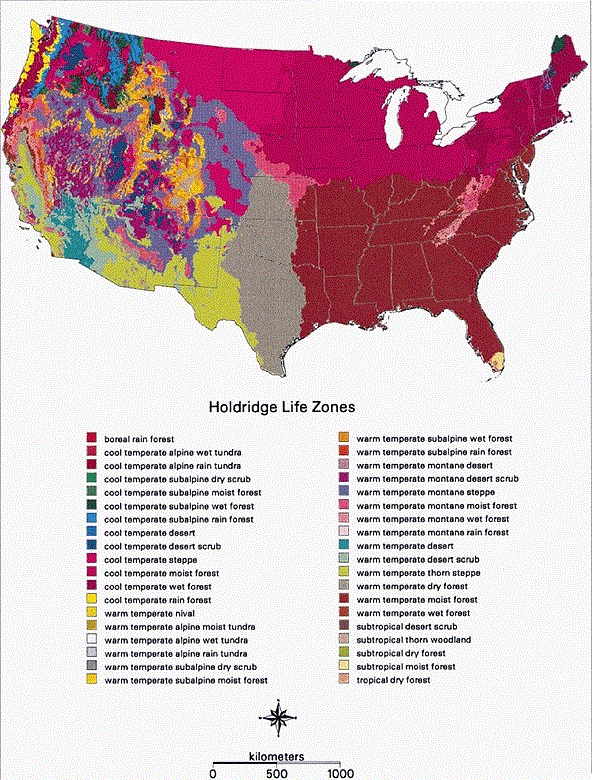
*The Holdridge life zones of the conterminous United States in relation to ecosystem mapping. Journal of Biogeography, 26, 1032.
Soil Types
Table 2 below describes the soil classification used in TRS-472. The Coral Sand and Other soil types are not listed in Table 2. The 'Other' soil type classification, in a temperate climate, was created for soils without characterization data and for mineral soils with unknown sand and clay contents (TRS-472, pg. 9). For tropical climates, the 'Coral Sand' soil type classification was changed from 'Other' (given in TRS-472, because it refers to soils that are outside the classification scheme used here, such as Marshall Island soils, classified by the authors as coral sand soil) (TRS-472, pg. 73).
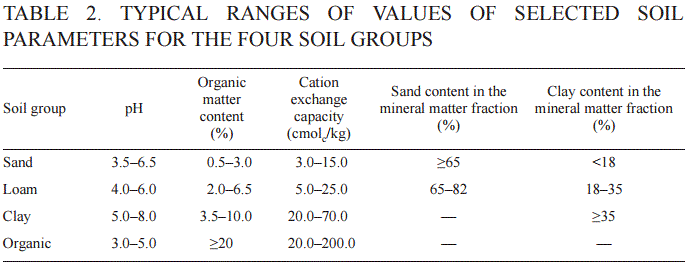
*Technical Report Series no. 472.
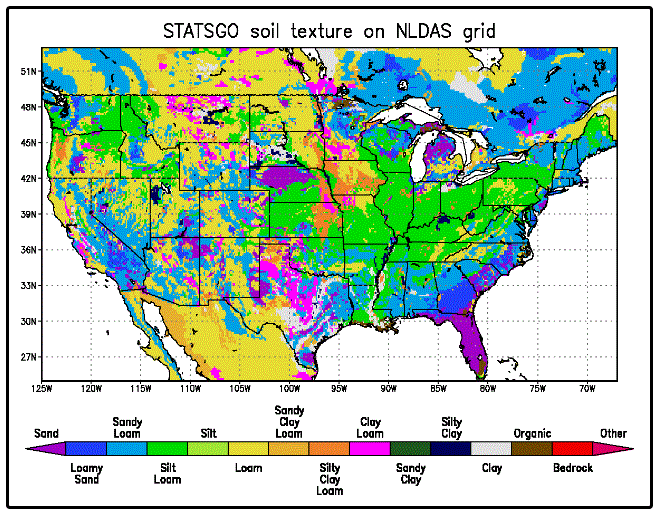
*Land Data Assimilation Systems (LDAS). NASA
Produce Types
The following table illustrates which soil-to-plant transfer factor categories from IAEA are used for each produce type in the DCC calculator. The individual produce output only lists the category name from IAEA; however, a value from a secondary source may be being utilized.
Table 2.5.1-C Primary Transfer Factor Category Primary Transfer Factor Source Secondary Transfer Factor Category Secondary Transfer Factor Source Tertiary Transfer Factor Category Tertiary Transfer Factor Source Fruit Apples Woody Tree IAEA Fruit EA None NCRP-123, RADSSL, RESRAD, and Baes Berries other than Strawberries Shrub IAEA Fruit EA None NCRP-123, RADSSL, RESRAD, and Baes Citrus Woody Tree IAEA Fruit EA None NCRP-123, RADSSL, RESRAD, and Baes Peaches Woody Tree IAEA Fruit EA None NCRP-123, RADSSL, RESRAD, and Baes Pears Woody Tree IAEA Fruit EA None NCRP-123, RADSSL, RESRAD, and Baes Strawberries Herbaceous IAEA Fruit EA None NCRP-123, RADSSL, RESRAD, and Baes Vegetables Asparagas Leafy Vegetable IAEA Green Vegetable EA None NCRP-123, RADSSL, RESRAD, and Baes Beets Root IAEA Root Vegetable EA None NCRP-123, RADSSL, RESRAD, and Baes Broccoli Non-Leafy Vegetable IAEA Green Vegetable EA None NCRP-123, RADSSL, RESRAD, and Baes Cabbage Leafy Vegetable IAEA Green Vegetable EA None NCRP-123, RADSSL, RESRAD, and Baes Carrots Root IAEA Root Vegetable EA None NCRP-123, RADSSL, RESRAD, and Baes Corn Maize Grain IAEA Green Vegetable EA None NCRP-123, RADSSL, RESRAD, and Baes Cucumbers Non-Leafy Vegetable IAEA Green Vegetable EA None NCRP-123, RADSSL, RESRAD, and Baes Lettuce Leafy Vegetable IAEA Green Vegetable EA None NCRP-123, RADSSL, RESRAD, and Baes Lima Beans Legume Seed IAEA Green Vegetable EA None NCRP-123, RADSSL, RESRAD, and Baes Okra Non-Leafy Vegetable IAEA Green Vegetable EA None NCRP-123, RADSSL, RESRAD, and Baes Onions Root* IAEA Root Vegetable EA None NCRP-123, RADSSL, RESRAD, and Baes Peas Legume Seed IAEA Green Vegetable EA None NCRP-123, RADSSL, RESRAD, and Baes Peppers Non-Leafy Vegetable IAEA Green Vegetable EA None NCRP-123, RADSSL, RESRAD, and Baes Pumpkins Non-Leafy Vegetable IAEA Green Vegetable EA None NCRP-123, RADSSL, RESRAD, and Baes Snap Beans Legume Seed IAEA Green Vegetable EA None NCRP-123, RADSSL, RESRAD, and Baes Tomatoes Non-Leafy Vegetable IAEA Green Vegetable EA None NCRP-123, RADSSL, RESRAD, and Baes White Potatoes Tuber IAEA Root Vegetable EA None NCRP-123, RADSSL, RESRAD, and Baes Grains Rice Rice IAEA None NCRP-123 None RADSSL, RESRAD, and Baes Cereal Grain Cereal Grain IAEA None NCRP-123 None RADSSL, RESRAD, and Baes *The IAEA TRS-472 guidance lists onions as both root vegetables and non-leafy vegetables. The environment agency (EA), however, only lists onions as root vegetables. When the ORNL/TM-2016/328 was originally released, onion was listed as a non-leafy vegetable. For consistency with EA and due to root vegetable BVs being generally more protective, the onion BV designation was updated from non-leafy vegetable to root vegetable.
While included in the initial hierarchy analysis, RESRAD and BAES sources do not contribute to the current output. They are retained in the user guide for informational purposes.
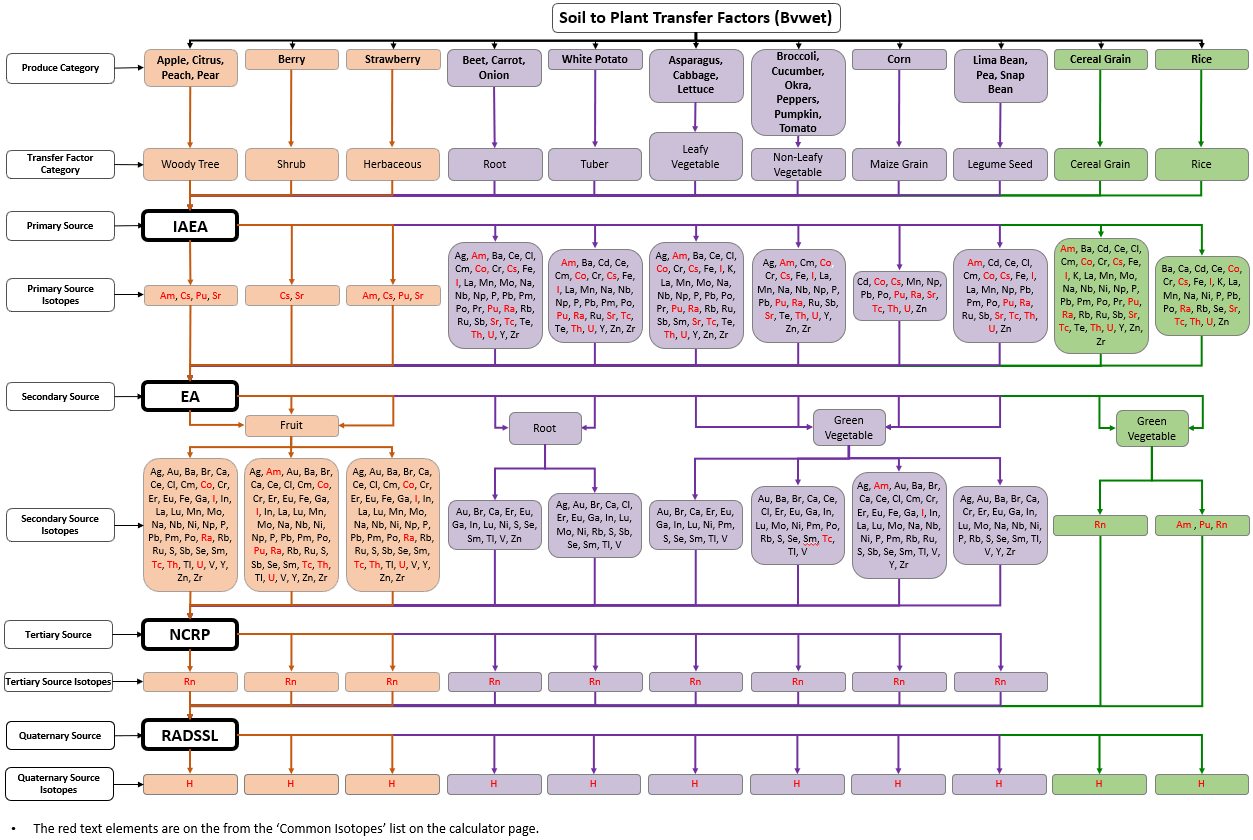
Please open the flow chart in a new tab to view a larger image. Carbon is missing from this chart. Please see section 2.5.4 of this user guide for information about how a soil-to-plant transfer factor was derived for Carbon in the DCC calculator.
2.5.1.3 Irrigation Rate (Ir) and Period (F) Derivation
The default irrigation rate used in the produce models is based on the commonly reported requirement of 1 inch of water per square foot per week. To convert this value to units of L/m2 - day used in the calculator, the following conversions are necessary.
If 1 square foot = 144 square inches, then 1 inch of water/sqft makes 144 cubic inches which is equal to 2.36 L/sqft per week. There are 10.76 square feet per square meter and 7 days per week. The following equation presents all the conversions to convert the units.
2.36 L/ft2 - week × 10.76 ft2/m2 × 1 week/7 days = 3.62 L/m2 - day (truncated).
The calculator assumes all the water will be coming from irrigation and not rainfall. The average rainfall for the continental United States is 30 inches per year or 0.762 meters per year. The area of the United States is 8.08E+12 square meters. Using the above conversion process the average daily rainfall is 2.1 L/m2 - day. Use the calculator in site-specific mode to adjust the irrigation rate to match the meteorological conditions at your site.
The default Irrigation period is 0.25. This equates to 3 months of the year or about 91 days. Using seed to harvest times for 65 fruits and vegetables a range of 70 to 95 days was calculated to be the growing season when irrigation would occur. An irrigation period of 91 days, or a 0.25 fraction of the year, represents a protective irrigation rate. The seed to harvest times and watering requirements for specific fruits and vegetables are presented in the following table.
Table 2.5.1-D* days to harvest days to harvest (min) days to harvest (max) watering requirement (inches) Fruit Banana NA great amount Blackberry NA evenly moist Cantaloupe (Melons) 70-100 70 100 1 or more/week Kiwifruit NA evenly moist Melons (Honeydew) 70-100 70 100 1 or more/week Pineapple NA evenly moist Raspberry NA evenly moist Strawberry NA evenly moist Watermelon 65-90 65 90 1-2/week Vegetables Artichoke 365 moist soil Arugula 40 40 40 moist soil Asparagus 730 1 inch Beans 60 60 60 1-1.5/week Beets 45-65 45 65 1/week Belgium Endive 21-28 21 28 evenly moist Broccoli 70-100 70 100 1-2/ week Brussels Sprouts 85-110 85 110 1 or more/week Cabbage 80-180 80 180 1-1.5/week Cardon 28-42 28 42 evenly Carrots 50-80 50 80 1/week Cauliflower 55-100 55 100 moist always Celeriac 90-120 90 120 moist always Celery 112 112 112 well watered Chard (Swiss) 55-60 55 60 moist always Chayote 120-150 120 150 moist always Chickpeas (garbanzo beans) 100 100 100 evenly moist Chicory and Radicchio 85-100 85 100 evenly moist Chinese cabbage 50-70 50 70 lightly moist Collards 85-95 85 95 1-1.5/week corn (sweet) 60-100 60 100 1 or more/week Cresses quick evenly moist Cucumbers 55-65 55 65 1/week Eggplant 100-150 100 150 1/week Endive and Escarole 85-100 85 100 evenly moist Fava Beans 85 85 85 do not over water Florence Fennel 90-115 90 115 moist but not wet Garlic 120-150 120 150 moist but not wet Horseradish 140-160 140 160 evenly moist Jerusalem Artichoke (Sunchoke) 120-150 120 150 even watering Kale 70-80 70 80 well watered Kohlrabi 48-60 48 60 evenly moist Leeks 75-120 75 120 evenly moist Lettuce (Head) 40-50 40 50 regular even water Lettuce (Leaf) 65-90 65 90 regular even water Lima Beans 60-80 60 80 1/week Mizuna 40 40 40 moist but not wet Mustard Greens 30-40 30 40 moist never dry New Zealand Spinach 55-65 55 65 evenly moist Okra 55-65 55 65 1/week Onions 80-150 80 150 evenly moist Parsnips 100-130 100 130 moist but not wet Peanuts 120-130 120 130 1/week Peas 55-80 55 80 evenly moist Peas (Southern) 60-90 60 90 moist never dry Peppers 60-95 60 95 evenly moist Potato (Sweet) 100-150 100 150 1/week Potatoes 75-135 75 135 moist but not wet Pumpkins 90-120 90 120 1-1.5/week Radicchio 60-100 60 100 evenly moist Radish 20-60 20 60 moist but not wet Rhubarb 730 moist but not wet Rutabaga 60-90 60 90 moist never dry Salsify 120-150 120 150 evenly moist Scorzonera 120-150 120 150 evenly moist Shallots 100-120 100 120 1/week Sorrel 60 60 60 evenly moist Soybeans 45-100 45 100 evenly moist Spinach 37-53 37 53 evenly moist Squash (Summer) 50-65 50 65 evenly moist Squash (Winter) 60-110 60 110 evenly moist Taro 200 well watered Tomatillos 65-70 65 70 moist not totally dry Tomatoes 40-80 40 80 moist but not wet Turnips 30-60 30 60 1-2/week Zucchini 40-60 40 60 evenly moist Average 70 95 2.5.2 Animal Product Modeling
2.5.2.1 Intake Rates (g/day)
In default mode, the (FW) intake rates from Table 2.5.2-A are used. Similar to produce, there is an option to select Cooked Weight in site-specific mode. The intake rates for poultry include chicken, turkey, and duck. In default mode, the parameters used for poultry and eggs are for chicken specifically (i.e., Qp, etc.). If eggs and poultry are selected in site-specific mode, the user will have the option to switch between chicken, turkey, duck, and goose, which will change the previously mentioned respective parameters; however, the transfer factor used will still be meant for chicken or duck, per TRS-472. If the user has a specific transfer factor for turkey or goose, then user-provided mode should be used.
Table 2.5.2-A Intake Rate for Farmer Child (g/day) (FW) Intake Rate for Farmer Adult (g/day) (FW) Intake Rate for Farmer Child (g/day) (CPW) Intake Rate for Farmer Adult (g/day) (CPW) Dairy - Cow 1116.4 1438.0 n/a n/a Beef 64.6 270.1 31.9 133.5 Swine 32.2 151.1 15.9 74.7 Poultry 48.8 175.5 24.1 86.7 Egg 25.1 97.3 n/a n/a Fish 36.1 155.9 22.1 95.6 Shellfish 21.3 208.9 13.0 128.1 Total 1344.5 2496.8 107 518.6 Site-specific mode will also offer the option to add animal products from Table 2.4.2-B to the output. The tool has transfer factors for these products; however, the user will need to enter their own intake rate data, as the tool does not provide any. Again, a local food survey can be conducted, which may utilize much of the methodology in the Guidance for Conducting Fish and Wildlife Consumption Surveys for surveying animal product consumption to determine site-specific food intake rates. In addition, the Food Commodity Intake Database (FCID) may be used to find intake rate data, but the user must convert the data to g/day, as it is required for use in this tool.
Table 2.5.2-B Intake Rate for Farmer Child (g/day) (FW) Intake Rate for Farmer Adult (g/day) (FW) Intake Rate for Farmer Child (g/day) (CPW) Intake Rate for Farmer Adult (g/day) (CPW) Sheep n/a n/a n/a n/a Sheep Milk n/a n/a n/a n/a Goat n/a n/a n/a n/a Goat Milk n/a n/a n/a n/a 2.5.2.2 Animal Transfer Factors (TF)
While included in the initial hierarchy analysis, RESRAD and BAES sources do not contribute to the current output. They are retained in the user guide for informational purposes. Please see section 2.4.1 for the transfer factor source hierarchy.
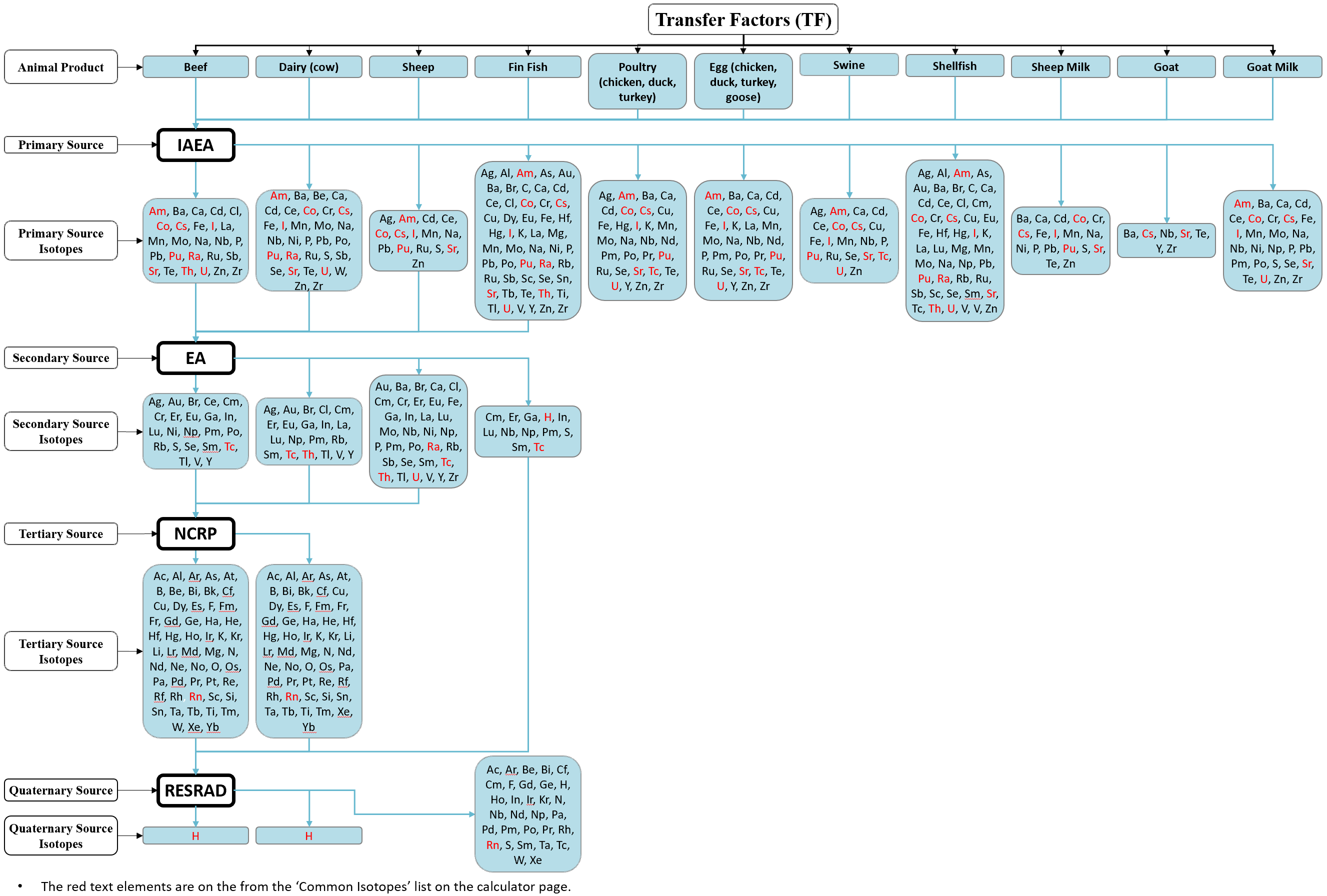
Please open the flow chart in a new tab to view a larger image.
2.5.3 Mass Loading Factor
A mass loading factor (MLF) is the amount, or mass, of soil that adheres to the plant surface. The following table lists the MLFs used in this tool according to plant type. For more information on how these were derived, please see the Technical Memorandum: Biota Modeling in EPA's Preliminary Remediation Goal and Dose Compliance Concentration Calculators for Use in EPA Superfund Risk Assessment: Explanation of Intake Rate Derivation, Transfer Factor Compilation, and Mass Loading Factor Sources.
Table 2.5.3-A Mass Loading Factor (MLF) Units Reference Fruit Apples 1.60E-04 g dry soil / g fresh plant EA (2009) Berries other than Strawberries 1.66E-04 g dry soil / g fresh plant EA (2009) Citrus 1.57E-04 g dry soil / g fresh plant EA (2009) Peaches 1.50E-04 g dry soil / g fresh plant EA (2009) Pears 1.60E-04 g dry soil / g fresh plant EA (2009) Strawberries 8.00E-05 g dry soil / g fresh plant EA (2009) Vegetables Asparagas 7.90E-05 g dry soil / g fresh plant EA (2009) Beets 1.38E-04 g dry soil / g fresh plant EA (2009) Broccoli 1.01E-03 g dry soil / g fresh plant Hinton (1992), SSG-Appendix G Cabbage 1.05E-04 g dry soil / g fresh plant EA (2009) Carrots 9.70E-05 g dry soil / g fresh plant EA (2009) Corn 1.45E-04 g dry soil / g fresh plant Pinder&McLeod (1989), SSG-Appendix G Cucumbers 4.00E-05 g dry soil / g fresh plant EA (2009) Lettuce 1.35E-02 g dry soil / g fresh plant Hinton (1992), SSG-Appendix G Lima Beans 3.83E-03 g dry soil / g fresh plant Hinton (1992), SSG-Appendix G Okra 8.00E-05 g dry soil / g fresh plant EA (2009) Onions 9.70E-05 g dry soil / g fresh plant EA (2009) Peas 1.78E-04 g dry soil / g fresh plant EA (2009) Peppers 2.22E-03 g dry soil / g fresh plant EA (2009) Pumpkins 5.80E-05 g dry soil / g fresh plant EA (2009) Snap Beans 5.00E-03 g dry soil / g fresh plant Hinton (1992), SSG-Appendix G Tomatoes 1.77E-03 g dry soil / g fresh plant Hinton (1992), SSG-Appendix G White Potatoes 2.10E-04 g dry soil / g fresh plant EA (2009) Grains Cereal Grains 2.50E-01 g dry soil / g dry plant Hinton (1992) Rice 2.50E-01 g dry soil / g dry plant Hinton (1992) Pasture 2.50E-01 g dry soil / g dry plant Hinton (1992) 2.5.4 Soil to Plant Transfer Factor Derivation for Carbon
The value of 5.5 given in Table D.3 of the RESRAD User's Manual for carbon root uptake was derived from data in Ng et al. 1968. Table 4 of Ng et al. 1968 presents a carbon composition in typical agricultural soil of 2.00E+04 ppm and a carbon composition in terrestrial plants of 1.10E+05 ppm in Table 10A. 1.10E+05 divided by 2.00E+004 gives the value of 5.5 reported in RESRAD. This value assumes that all the carbon in the plant is taken up by the roots; however, this is not the case. Photosynthesis is the primary source of carbon in plants. Carbon may be present in gas form in soils and volatilize into the plant canopy, where it may be taken up by the plant in some fraction, depending on atmospheric conditions. It is typically estimated that 2% of plant carbon comes from soil (either directly or by uptake from the sub-canopy atmosphere). The other 98% of plant carbon comes from the above-canopy atmosphere, which is assumed not to contain carbon from the contaminated site. Consider that a plant is about 90% water and of the 10% dry matter about 40% is carbon. That plant would comprise about 4% carbon on a fresh weight basis. A mineral soil is typically about 2% to 5% organic matter, which corresponds to 0.8% to 2% carbon on a dry mass basis. Thus, taking the ratio of carbon contents results in a transfer factor of 4%/(0.8% to 2%) = 5.0 to 2.0 g fresh plant/g dry soil. The next step is to apply the 2% fraction of plant carbon derived from soil. The resulting range of transfer factors is 0.1 to 0.04 (2%*(5.0 to 2.0)). The value of 0.1 is chosen for the calculation of DCCs and is used for all the BVwet values. BVdry values are derived for each plant type based on individual moisture content. For comparison purposes, the 5.5 value from RESRAD gives a transfer factor of 0.11 if the 2% assumption is made.
The above derivation assumes that all the carbon taken up by the plant is radioactive. In situations where radioactive carbon is mixing with stable carbon, a site-specific transfer factor can be derived using a model called "specific activity". Essentially, specific activity is the concentration ratio of the radioactive form to the stable form of carbon. Specific activity assumes that, within a compartment (i.e., soil), the radioactive contaminant mixes with the stable form both chemically and physically. Plants uptake the element in the same ratio as it exists in the soil compartment, resulting in the same ratio in the plant as in the soil compartment.
To determine a site-specific soil-to-plant transfer factor, actual site data must be available. Further, the flux rate of the element must be in a steady-state condition. The environmental compartments must be well defined and the fluxes between compartments well understood. For further information, refer to the following: AMEC/004041/007 section 5, ANL/EAD-4 Appendix L, and IAEA TECDOC 1616 page 550.
2.5.5 Caloric Values of Produce and Animal Products
This section presents the caloric values of the produce, and animal products discussed in Section 2.5.1&2. These caloric values (kcal/g) are then multiplied by the intake rates (g/day) from 2.5.1-A&B to give dailiy caloric intake values (kcal/day). With this information it will be possible to select the appropraite produce and animal products for site-specific analysis to ensure a sustainable caloric intake for the receptors chosen. Caloric values for additional produce and seafood not currently given in the calculator are also presented. The caloric values presented are based on fresh (raw) weight and the weight after cooking. All of the caloric data was taken from the USDA's FoodData Central search tool with preference to the "Foundation Foods" and the "Atwater General Factors" energy data for caloric information.
This spreadsheet contains all of the intake rates from Section 2.5.1&2 and the caloric values from the USDA used to calculate the caloric information presented in Tables 2.5.5-A - 2.5.5-J. This spreadsheet can be used to calculate unique caloric intakes on a site-specific basis.
Table 2.5.5-A presents the caloric intake of the adult and child farmer for the default produce types.
Table 2.5.5-A Calories for Farmer Child (kcal/day) (FW) Calories for Farmer Adult (kcal/day) (FW) Calories for Farmer Child (kcal/day) (CPW) Calories for Farmer Adult (kcal/day) (CPW) USDA kcal/g FW USDA Note FW USDA kcal/g CPW USDA Note CPW Fruit Apples 51.27 52.58 22.74 23.32 0.62 red delicious 0.53 boiled, skinless Berries other than Strawberries 15.49 22.53 na na 0.64 blueberries na Citrus 107.12 159.38 na na 0.52 navel orange na Peaches 45.17 47.43 na na 0.46 na Pears 50.15 37.67 na na 0.63 na Strawberries 9.90 14.62 na na 0.36 na Vegetables Asparagus 2.38 8.02 1.78 6.03 0.20 0.22 Beets 2.58 14.79 1.80 10.34 0.43 0.44 Broccoli 5.77 13.30 3.54 8.16 0.39 0.35 Cabbage 3.41 24.65 1.73 12.49 0.31 green 0.23 Carrots 6.29 11.71 3.12 5.81 0.48 0.35 Corn 27.18 70.61 20.74 53.86 0.86 yellow 0.96 yellow Cucumbers 2.61 8.78 na na 0.16 na Lettuce 0.58 6.24 na na 0.17 iceberg na Lima Beans 74.36 114.58 17.25 26.68 3.38 mature seeds 1.15 mature seeds Okra 3.10 10.03 1.41 4.58 0.33 0.22 Onions 2.85 10.37 2.24 8.18 0.38 yellow 0.44 Peas 16.52 25.60 5.84 9.07 0.81 green 0.42 Peppers 1.70 5.50 1.43 4.56 0.23 bell, green 0.28 sweet, green Pumpkins 5.51 16.51 2.90 8.68 0.26 0.20 Snap Beans 11.48 21.80 6.86 13.02 0.40 green 0.35 green Tomatoes 7.60 16.92 5.20 11.56 0.18 red 0.18 red White Potatoes 36.16 97.84 32.94 89.15 0.69 0.92 baked Total 489.18 811.45 131.5 295.48 Table 2.5.5-B presents the caloric intake of the adult and child resident for the default produce types.
Table 2.5.5-B Calories for Resident Child (kcal/day) (FW) Calories for Resident Adult (kcal/day) (FW) Calories for Resident Child (kcal/day) (CPW) Calories for Resident Adult (kcal/day) (CPW) USDA kcal/g FW USDA Note FW USDA kcal/g CPW USDA Note CPW Fruit Apples 44.64 45.82 19.77 20.30 0.62 red delicious 0.53 boiled, skinless Berries other than Strawberries 15.49 22.53 na na 0.64 blueberries na Citrus 107.12 159.38 na na 0.52 navel orange na Peaches 50.69 53.22 na na 0.46 na Pears 43.72 32.82 na na 0.63 na Strawberries 9.90 14.62 na na 0.36 na Vegetables Asparagus 2.38 8.02 1.78 6.03 0.20 0.22 Beets 2.58 14.79 1.80 10.34 0.43 0.44 Broccoli 5.15 11.90 3.15 7.28 0.39 0.35 Cabbage 3.66 26.38 1.84 13.36 0.31 green 0.23 Carrots 6.96 13.01 3.47 6.48 0.48 0.35 Corn 19.95 51.77 15.17 39.46 0.86 yellow 0.96 yellow Cucumbers 3.92 13.17 na na 0.16 na Lettuce 0.58 6.24 na na 0.17 iceberg na Lima Beans 74.36 114.58 17.25 26.68 3.38 mature seeds 1.15 mature seeds Okra 3.10 10.03 1.41 4.58 0.33 0.22 Onions 2.24 8.17 1.76 6.47 0.38 yellow 0.44 Peas 18.31 28.35 6.51 10.04 0.81 green 0.42 Peppers 1.36 4.39 1.15 3.64 0.23 bell, green 0.28 sweet, green Pumpkins 5.51 16.51 2.90 8.68 0.26 0.20 Snap Beans 11.32 21.52 6.76 12.88 0.40 green 0.35 green Tomatoes 6.48 14.42 4.43 9.85 0.18 red 0.18 red White Potatoes 32.64 88.18 29.72 80.32 0.69 0.92 baked Total 472.05 779.82 118.85 266.37 Table 2.5.5-C presents the caloric intake of the adult and child farmer and resident for the default grains.
Table 2.5.5-C Calories for Farmer Child (kcal/day) (DW) Calories for Farmer Adult (kcal/day) (DW) Calories for Resident Child (kcal/day) (DW) Calories for Resident Adult (kcal/day) (DW) USDA kcal/g DW USDA Note Rice 178.06 355.05 147.19 294.02 3.59 white, raw Cereal Grain 175.57 309.52 145.27 256.23 3.65 corn Total 353.63 644.57 292.46 550.25 Table 2.5.5-D provides the caloric content of more produce.
Table 2.5.5-D USDA kcal/g FW USDA Note FW USDA kcal/g CPW USDA Note CPW Fruit Apricot 0.48 na Avocado 1.6 raw na Banana 0.89 na Blackberries 0.43 na Cantaloupe 0.43 na Cranberries (fresh) 0.46 na Dates 2.77 medjool na Grapefruit 0.33 white na Grapes 0.80 green na Honeydew Melon 0.36 na Kiwifruit 0.64 na Lemon 0.29 peeled na Lime 0.3 na Mandarin Oranges 0.53 na Mango 0.6 na Nectarine 0.43 na Pineapple 0.60 na Plums 0.46 na Pomegranate 0.83 na Raspberries 0.52 na Sweet Cherries 0.71 na Tangerine 0.53 na Watermelon 0.3 na Vegetables Artichoke 0.73 Jerusalem 0.53 Brussels Sprouts 0.43 0.36 Cauliflower 0.25 0.23 Celery 0.17 0.18 Green Onion 0.27 tops na Leaf Lettuce 0.22 na Mushrooms 0.44 shiitake 0.56 shiitake Radishes 0.16 0.17 Spinach 0.28 mature 0.23 Sweet Potato 0.79 skinless 0.90 Turnips 0.28 0.22 Winter Squash 0.40 acorn 0.34 acorn Zucchini 0.21 0.15 Table 2.5.5-E provides the caloric content of more grains.
Table 2.5.5-E USDA kcal/g DW USDA Note Amaranth 3.71 Barley Grain 3.52 pearled Buckwheat 3.56 Bulgur 3.42 Flax Grain 3.50 flakes Khorasan 3.37 Millet 3.76 Oat Grain 2.46 bran Quinoa 3.68 Rye 3.38 Sorghum 3.29 Spelt 3.38 Wheat 3.31 soft red winter Table 2.5.5-F presents the caloric intake for the default animal products.
Table 2.5.5-F Calories for Farmer Child (kcal/day) (FW) Calories for Farmer Adult (kcal/day) (FW) Calories for Farmer Child (kcal/day) (CPW) Calories for Farmer Adult (kcal/day) (CPW) USDA kcal/g FW USDA note FW USDA kcal/g CPW USDA note CPW Dairy - Cow 681.00 877.18 na na 0.61 whole na Beef 156.98 656.34 78.47 328.41 2.43 80/20 raw 2.46 pan-broiled Swine 73.42 344.51 47.22 221.86 2.28 ground raw 2.97 cooked Poultry 64.90 233.42 45.55 163.86 1.33 ground, raw 1.89 ground, pan-browned Egg 35.89 139.14 na na 1.43 egg whole 1.55 hard-boiled Fish 51.98 224.50 40.66 175.90 1.44 bluefin, raw 1.84 bluefin, cooked Shellfish 18.11 177.57 11.57 114.01 0.85 crustaceans, shrimp, raw 0.99 crustaceans, shrimp, cooked Total 1082.28 2652.65 224.78 1016.86 Table 2.5.5-G presents the caloric content of sheep and goat products.
Table 2.5.5-G USDA kcal/g FW USDA note FW USDA kcal/g CPW USDA note CPW Sheep 2.82 lamb, ground, raw 2.83 lamb, ground, broiled Sheep Milk 1.08 milk, fluid na Goat 1.09 game meat, goat, raw 1.43 game meat, goat, roasted Goat Milk 0.69 milk, fluid na Table 2.5.5-H provides the caloric content of more seafood items.
Table 2.5.5-H Calories for Farmer Child (kcal/day) (FW) Calories for Farmer Adult (kcal/day) (FW) Calories for Farmer Child (kcal/day) (CPW) Calories for Farmer Adult (kcal/day) (CPW) USDA kcal/g FW USDA note FW USDA kcal/g CPW USDA note CPW Finfish Catfish 34.30 148.11 23.21 100.38 0.95 channel, wild 1.05 channel Cod 29.60 127.84 23.21 100.38 0.82 Atlantic, raw 1.05 Atlantic Flounder/Sole 25.27 109.13 19.01 82.22 0.70 flatfish, raw 0.86 flatfish Haddock 26.71 115.37 19.89 86.04 0.74 raw 0.90 Halibut 32.85 141.87 24.53 106.12 0.91 raw 1.11 Ocean Perch 28.52 123.16 21.22 91.78 0.79 raw 0.96 Orange Roughy 27.44 118.48 23.21 100.38 0.76 raw 1.05 Pollock 33.21 143.43 26.08 112.81 0.92 Atlantic, raw 1.18 Atlantic Rainbow Trout 42.96 185.52 33.15 143.40 1.19 wild, raw 1.50 wild Rockfish 35.02 151.22 27.40 118.54 0.97 raw, striped bass 1.24 striped bass Salmon, Red 55.23 238.53 76.25 329.82 1.53 sockeye, raw 3.45 sockeye, smoked Salmon, Pink 45.85 197.99 33.81 146.27 1.27 raw 1.53 Swordfish 51.98 224.50 38.01 164.43 1.44 raw 1.72 Tilapia 34.66 149.66 28.29 122.37 0.96 raw 1.28 Tuna 51.98 224.50 40.66 175.90 1.44 bluefin, raw 1.84 bluefin Shellfish Blue Crab 18.53 181.74 10.79 106.32 0.87 raw 0.83 moist heat Clams 18.32 179.65 19.24 189.59 0.86 raw 1.48 moist heat Lobster 16.40 160.85 11.57 114.01 0.77 northern, raw 0.89 northern, moist heat Oysters 10.86 106.54 13.26 130.66 0.51 eastern, raw 1.02 eastern, moist heat Scallops 14.70 144.14 14.43 142.19 0.69 mixed species, raw 1.11 bay and sea, steamed Shrimp 18.11 177.57 12.87 126.82 0.85 crustaceans, shrimp, raw 0.99 crustaceans, shrimp, cooked Combining the default intake rates in Tables 2.5.1-A&B with the caloric data presented in Tables 2.5.5-A-F, the total amount of calories consumed with the produce, grains, and animal products are determined for the default adult and child farmer.
Table 2.5.5-I presents the total calories per day for the default farmer.
Table 2.5.5-I Calories for Farmer Child (kcal/day) (FW) Calories for Farmer Adult (kcal/day) (FW) Calories for Farmer Child (kcal/day) (CPW) Calories for Farmer Adult (kcal/day) (CPW) Produce 489.18 811.45 131.5 295.48 Grains (DW) 353.63 664.57 353.63 664.57 Animal Products 1082.28 2652.65 224.78 1016.86 Total 1952.09 4128.67 709.91 1976.90 Combining the default intake rates in Tables 2.5.1-A&B with the caloric data presented in Tables 2.5.5-A-F, the total amount of calories consumed with the produce and grains are determined for the default adult and child resident.
Table 2.5.5-J presents the total grams and calories per day for the default resident.
Table 2.5.5-J Calories for Resident Child (kcal/day) (FW) Calories for Resident Adult (kcal/day) (FW) Calories for Resident Child (kcal/day) (CPW) Calories for Resident Adult (kcal/day) (CPW) Produce 472.05 779.82 118.85 266.37 Grains (DW) 292.46 550.25 292.46 550.25 Total 764.51 1330.07 411.31 816.62 2.6 DCCs in Context of Superfund Modeling Framework
This DCC calculator focuses on the application of generic and simple site-specific approaches that are part of a larger framework for calculating concentration levels to comply with dose-based ARARs. Generic DCCs for a 1 mrem standard are provided by viewing either the tables in the Download Area section of this tool or by running the calculator with "Defaults" selected for Site Info Type. Part 3 of the Soil Screening Guidance for Radionuclides: Technical Background Document provides more information about five more detailed soil-to-groundwater models that are part of the same framework.
Generic DCCs are calculated from the same equations presented in the site-specific portion of the calculator, but they are based on a number of default assumptions chosen to be protective of human health for most site conditions. Generic DCCs, which should be scaled to the same dose level as the standard being complied (e.g., multiplied by a factor of ten for a 10 mrem/year standard), can be used in place of site-specific DCC levels; however, in general, they are expected to be more protective than site-specific levels. The site manager should weigh the cost of collecting the data necessary to develop site-specific DCCs with the potential for deriving a higher DCC that provides an appropriate level of protection.
The framework presented in Part 3 of the Soil Screening Guidance for Radionuclides: Technical Background Document includes more detailed modeling approaches that take into account more complex site conditions than the generic or simple site-specific methodology used in the soil-to-groundwater scenario in this calculator. More detailed approaches may be appropriate when site conditions (e.g., very deep water table, very thick uncontaminated unsaturated zone, soils underlain by karst or fractured rock aquifers) are different than those assumed in the generic or simple site-specific methodology. Further information on using more detailed approaches may be found in "Simulating Radionuclide Fate and Transport in the Unsaturated Zone: Evaluation and Sensitivity Analyses of Select Computer Models". This report provides a detailed technical analysis of five unsaturated zone fate and transport models for radionuclides.
To avoid unnecessary inconsistency between radiological and chemical risk assessment and radiological dose assessment at the same site, users should generally use the same model for chemical and radionuclide risk assessment and radionuclide dose assessment. If there is a reason for using another model, then justification for doing so should be developed. The justification should include specific supporting data and information in the Administrative Record. The justification would normally include the model runs, using both the recommended EPA DCC model and the alternative model. Users are cautioned that they should have a thorough understanding of both the DCC recommended model and any alternative model when evaluating whether a different approach is appropriate. When alternative models are used, the user should adjust the default input parameters to be as close as possible to the DCC inputs, which may be difficult, since models tend to use different definitions for parameters. Numerous computerized mathematical models have been developed by EPA and other organizations to predict the fate and transport of radionuclides in the environment; these models include single-media unsaturated zone models (e.g., groundwater transport) as well as multi-media models. These models have been designed for a variety of goals, objectives, and applications; as such, no single model may be appropriate for all site-specific conditions. Generally, even when a different model is used to predict fate and transport of radionuclides through different media, EPA recommends using the DCC calculators for the remedial program to establish the dose-based concentrations to ensure consistency with CERCLA, the NCP, and EPA's Superfund guidance for remedial sites. Prior to using another model for dose assessment at a CERCLA remedial site, EPA regional staff should consult with the Superfund remedial program's National Radiation Expert (Stuart Walker, at (703) 603-8748 or walker.stuart@epa.gov). For more information on this issue, please see questions 10 and 16 on pages 12, 17, and 18 of Radiation Risk Assessment At CERCLA Sites: Q&A (EPA 540-R-012-13, May 2014).
2.7 Understanding Dose Output on the DCC Website
The DCC calculator provides an option to select dose output. Selecting dose output requires the calculator to be run in "Site Specific" mode. The "Soil to Groundwater" medium does not have dose output and will become disabled when dose output is selected. The dose values presented on this site are radionuclide-specific values for individual contaminants in air, water, soil, and biota that may warrant further investigation or site cleanup.
2.7.1 General Considerations for the Dose Output
The first step in the dose assessment process is hazard identification, where site data is screened against DCCs to identify radionuclides of potential concern (ROPCs). The "Dose Characterization" step, in the dose assessment process, incorporates the outcome of the exposure and toxicity assessment steps to calculate the annual dose identified in the data screening part of the hazard identification step. Dose is calculated for each land use determined appropriate for the site. The annual dose sum is presented for each exposure route for all ROPCs and for each ROPC across all exposure routes. The process used to calculate dose in this calculator follows the traditional method of first calculating a CDI (Chronic Daily Intake).
The basic equation for calculating total Dose is:
The secular equilibrium equation for calculating total Dose is:
2.7.2 General Considerations for Entering Site Data
There are four calculator output options available to the user.
- DCC Output Option #1: Assumes period of peak dose (with decay and progeny ingrowth) (Peak DCC)
- DCC Output Option #2: Assumes Secular Equilibrium Throughout the Chain (no decay - parent and progeny in constant equilibrium)
- DCC Output Option #3: Does Not Assume Secular Equilibrium, Provides Results for Progeny Throughout Chain (with decay where appropriate)
- DCC Output Option #4: Does Not Assume Secular Equilibrium, Selected Isotopes Only (with decay where appropriate)
The first two include progeny contributions in the dose calculations of the parent. The third and fourth options do not. However, if the third option is selected, the media concentrations for the progeny are automatically populated with the concentration entered for the parent. The progeny will have their dose calculated independent of each other. This autofill feature is not available when isotope chains overlap. The autofill feature is solely for convenience and does not assume secular equilibrium.
If the data is collected from a site where secular equilibrium is assumed to be present, the user need only enter the activity of the parent in the calculator, and a representative dose of the parent and all progeny will be presented in the calculator output. In the case of non-secular equilibrium, the current "state of the chain" may not be known or easily calculated. For relatively fast decaying isotopes, significant decay or ingrowth of progeny may have occurred since the sample date. Further, determining future activity of the contaminants may be useful in planning for future release of a property.
A Decay Chain Activity Projection Tool has been developed where the user can select an isotope, enter a length of time to allow decay and ingrowth, and enter the beginning activity of the parent. The results of this tool, pictured below, are the activities of the parent and progeny at the end of the decay and ingrowth of progeny time. These activities can be entered into the DCC calculator to calculate dose using the third and fourth DCC Output options.
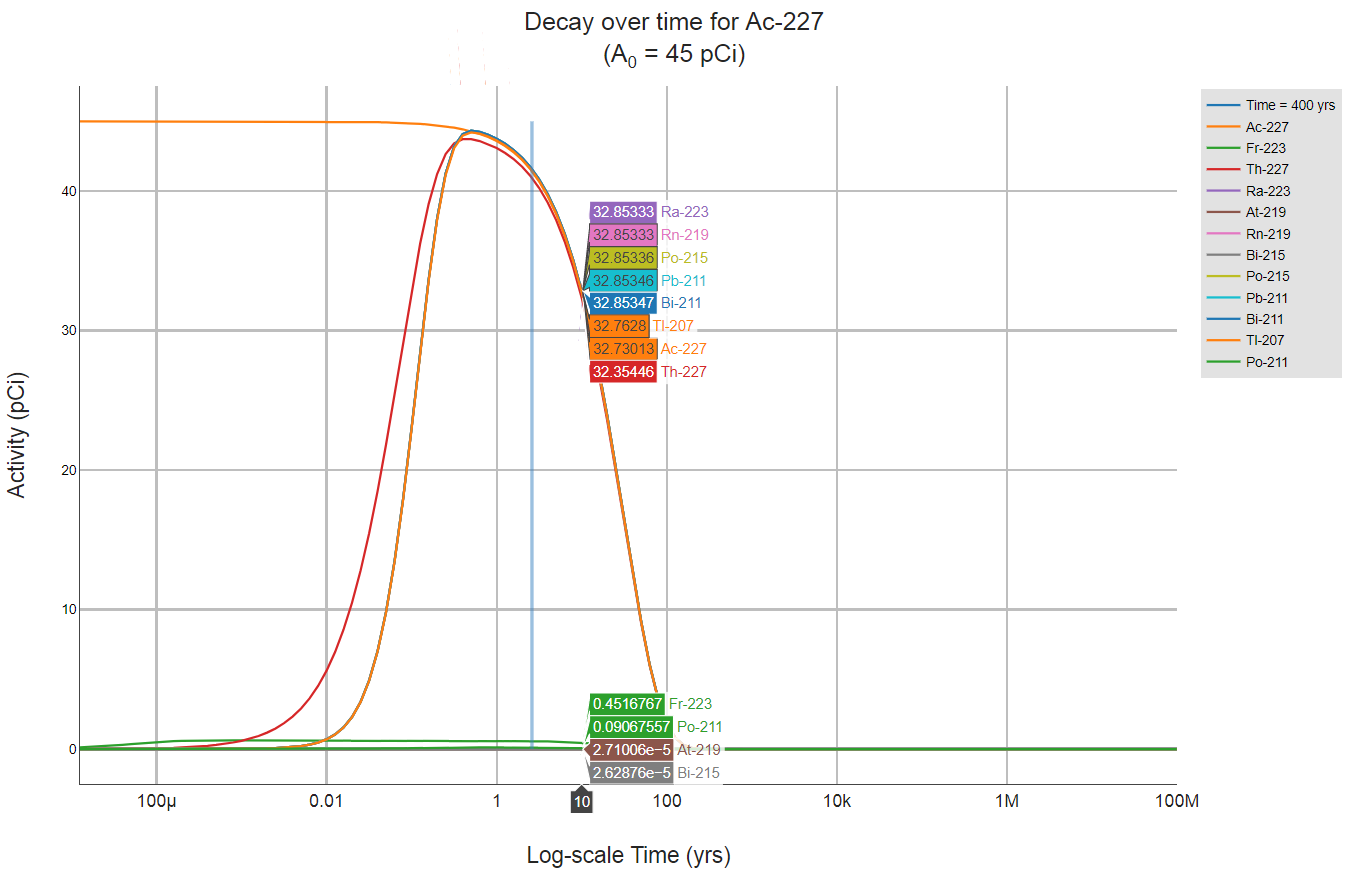
2.8 Sensitivity/Uncertainties Analysis
Uncertainties exist in any default DCC equation and they can often be resolved by changing an exposure parameter value.
A sensitivity/uncertainty analysis is the quantitative assessment of how changing a single value impacts the DCC calculation. Sensitivity analyses are generally conducted to determine what changed variable in a DCC equation has the greatest impact. An evaluation of the uncertainty associated with a DCC calculation can identify a need for site-specific parameters. If the level of uncertainty is acceptable, then the DCCs can be used accordingly. However, if the resulting uncertainty is not acceptable, the sensitivity analysis will help to identify those parameters that, if measured on a site-specific basis, would decrease uncertainty to the greatest extent.
Examples of site-specific variables that can greatly impact a DCC are:
- soil to water partition coefficients,
- biota transfer factors,
- water to air volatilization,
- gamma shielding factors, and
- area correction factors
Examples of site-specific exposure parameters that can greatly impact a DCC are:
- intake rates, and
- fraction ingested of contaminated biota
The quantitative assessment of uncertainties in the transport and exposure parameters provides considerable information about the variability and sensitivity of the calculated default DCCs. These results are important, because point estimates of these parameters are used to determine the extent of remediation necessary through the Superfund process. The point estimates that are provided as guidance by the U.S. Environmental Protection Agency (EPA) are often conservative and can result in an overestimate of the potential dose or risk. The intent of this section is to raise awareness of the potential cost savings of developing site-specific values for key parameters. The results can be used to quantify the degree to which the standard default values overestimate the predicted percentiles of exposure (typically 90-95th percentile values) that they are intended to estimate and to determine which parameters are responsible for the majority of the variation. Please see Guidance for Conducting Risk Assessments and Related Risk Activities for the DOE-ORO Environmental Management Program for additional information.
There are several methods for identifying the most important contributors to uncertainty. Monte Carlo simulation with either Simple Random Sampling (SRS) or Latin Hypercube Sampling (LHS) is often the most robust method for propagating uncertainty through either simple or complex models. Please see An Introductory Guide to Uncertainty Analysis in Environmental and Health Risk Assessment for additional information.
Many of the DCC equations are linear, and changing a parameter has a directly proportional impact on the DCC. For example, doubling the intake rate in a fin fish ingestion DCC will reduce the DCC by half.
2.9 Advanced Calculator Uses (Postprocessing and Replicating Discontinued DCC Options)
The DCC calculator results, when exported in a spreadsheet, can be used to create site-specific DCCs that cannot be developed solely within the calculator. This postprocessing of results can be useful when the calculator doesn't offer the precision necessary for remedial decision. Additionally, the calculator can be used to replicate the old +D DCCs.
2.9.1 Postprocessing Calculator Results to Incorporate Site-Specific MCNP Factors
Nearly all of the exposure parameters in the DCC equations can be changed by using the site-specific option in the calculator. Further, many of the isotope-specific values (i.e., slope factors, dose coefficients, partition coefficients, and transfer factors for plants and animals) can be changed by using the user-provided option in the calculator. While many options are given for users to select site size and clean soil cover, it may be necessary to derive a "factor" specific to a particular site using tools like Monte Carlo Nuclear Particle (MCNP). For example, a user may want to use MCNP or another tool to develop a site-specific Area Correction Factor (ACF) for an unusual situation (e.g., a site that consists of flat land that is next to a cliff face and both are contaminated). The following is a brief description of how to postprocess calculator results when including the results for a factor that was developed in another tool such as MCNP. All variables in the ingestion and inhalation equations can be changed in the calculator itself; the external exposure route is the most likely to require postprocessing.
The calculator offers the option to export results in a spreadsheet format. Using the spreadsheet, the "factor" supplied by the calculator can be substituted with a site-specific factor supplied by the user. The procedure is relatively straight forward, as all the factors are in the denominator of the screening level equations. Simply multiply the screening level by the ratio of the default factor to the site-specific factor.
This general process does work; but please consider the following, as further steps may be necessary:
- If adjusting a factor in the external exposure route, the total DCC needs to be recalculated using the inverse sum of reciprocals.
- If adjusting a factor in parentheses, such as a resident outdoor Gamma Shielding Factor (GSFo), then more postprocessing is required.
- When adjusting a DCC calculated by the secular equilibrium option, factors for all the progeny need to be calculated and totaled using the inverse sum of reciprocals.
- The Peak DCC results are impossible to post process, because the state of the chain (decay and ingrowth of all members) cannot be replicated in a spreadsheet. Section 2.2.5 discusses what DCC output options are closest to the Peak DCC. In many cases, the parent only with decay or the SE DCCs may be identical to the Peak DCC. Post processing one of these substitute DCC options can replicate what the Peak DCC would be.
Here is an example of the DCC calculator default results for external (2-D soil volume) exposure for an indoor worker exposed to soil. The default GSFi is 0.4 and represents the shielding provided by general subfloor materials from contaminated soil. In the case of a commercial building being constructed on a concrete slab, a site-specific shielding factor can be generated with MCNP and the site-specific DCC recalculated following the procedure discussed previously. Suppose a GSFi was determined to be 0.2 with MCNP for Ra-226 without consideration of progeny. Users should note that post processing for Ra-226 would require these steps for each of the progeny with an external slope factor.
The original results are below and show a GSFi of 0.4 (cell F5) and a DCC of 345 pCi/g (cell G5).
The postprocessed results are below with a GSFi of 0.2 (cell H5), showing the resulting site-specific DCC (cell J5) is twice as large as the default value above, as expected. The green shaded cells need to be added and programmed by the user. Below the green cells, the formula for the postprocessing procedure is given.
Please contact your EPA regional risk assessor before post processing DCC calculator results for Superfund sites.
2.9.2 Replicating the Old +D DCCs
Prior to 2017, "+D" designated dose coefficients and subsequently +D DCCs were available as the preferred DCC output option. This designation indicated that the dose coefficients included the contribution from ingrowth of progeny out to 100 years. Similarly, +E indicated ingrowth out to 1000 years. FGR 12 provided the original table of the +D radionuclide dose coefficients, and ORNL 2014c with appendix provides the +D dose coefficients previously used in this calculator. The intention of this designation was to make DCCs protective by including the contributions from their short-lived decay products that were, at times, difficult to measure. The +D designation indicated that the parent radionuclide DCC included the dose or risk contribution from its short-lived progeny. The DCCs presented in sections 2.2.1 and 2.2.2 independently model progeny during migration to groundwater and biota uptake, while the +D DCCs did not. The use of the +D DCCs was discontinued because of the following reasons that led to imprecision in the +D DCCs.
- The half-life of the parent isotope was used for all the short-lived progeny included in the +D to calculate decay.
- The Kd of the parent was used for all the short-lived progeny in the soil-to-water partitioning DCCs to calculate downgradient water concentrations.
- The biota transfer factors for the parent was used for all the short-lived progeny included in the +D to calculate nuclide uptake into plants and animals.
The steps to replicate the old +D DCCs are as follows.
- Select the DCC output option described in section 2.2.3 (Does Not Assume Secular Equilibrium, Provides Results for Progeny Throughout Chain).
- Select Site-Specific and then User-provided on the calculator main page.
- At this point, there are three ways to proceed to calculate +D DCCs.
- The easiest way is to just change the slope factors to the +D dose coefficients found in HEAST and adjust any exposure parameters. On the results page, the parent isotope DCC will be a +D DCC because +D dose coefficients were used.
- Alternatively, on the Site-Specific page, every isotope-specific parameter and every exposure parameter can be changed to match the old +D DCC inputs including: half-life, Kd, biota transfer factors, gamma shielding factors, and area correction factors. Make appropriate changes to all isotopes, but specifically do not change the dose coefficients to +D dose coefficients. The results of this endeavor will be a very close approximation to the old +D DCCs.
- Finally, if the desire is to determine what a modern version of a +D DCC would be, change nothing for any of the isotopes.
- For the second and third options above, on the results page, the individual isotope DCCs will be presented. The last step is to combine the appropriate parent and progeny DCCs to make a +D DCC. This is done by taking the inverse sum of the reciprocals of the individual DCCs. Replication of the +D DCCs for the biota route will be impossible, as the models have changed. Consult the table below to determine what progeny should be included in the summation method.
Below is a table of progeny and the terminal radionuclide used in +D and +E slope factors and dose coefficient development.
Progeny used for Derivation of +D and +E Slope Factors and Dose Coefficients
Principal
Radionuclide
(half-life in years)Associated decay chain Terminal
RadionuclideHalf-life
(years)Cs-137+D (30.2) Cs-137+E (30.2) Pu-239+D (2.41E+04) Pu-239+E (2.41E+04) Ra-226+D (1.60E+03) Ra-226+E (1.60E+03) Ra-228+D (5.75E+00) Ra-228+E (5.75E+00) Rn-222+D (1.05E-02) Rn-222+E (1.05E-02) Sr-90+D (28.8) Sr-90+E (28.8) Th-232+D (1.41E+10) Th-232+E (1.41E+10) U-235+D (7.04E+08) U-235+E (7.04E+08) U-238+D (4.47E+09) U-238+E (4.47E+09)
3. Understanding Your Superfund Site
The sections that follow describe how to use the generic download tables. The generic download tables are to be used in the absence of site-specific exposure data. When site-specific exposure data is available, these sections also provide information developing a conceptual site model, addressing background radiation, and potential limitations of the DCC models presented in this guidance.
3.1 Using the DCC Tables
The tables in the DCC Download Area provide generic concentrations in the absence of site-specific dose assessments. Screening concentrations can be used for:
- Prioritizing multiple sites within a facility or exposure units,
- Setting dose-based detection limits for contaminants of potential concern (COPCs),
- Focusing future dose assessment efforts, and
- When appropriate for the site, consider as dose-based cleanup levels.
3.2 Developing a Conceptual Site Model
When using DCCs at a Superfund site, the exposure pathways of concern and site conditions must match those taken into account by the screening levels. (Note, however, that future uses may not match current uses. Future uses of a site should be logical conditions that might occur at the site in the future.) Thus, it is necessary to develop a conceptual site model (CSM) to identify likely contaminant source areas, exposure pathways, and potential receptors. This information can be used to determine the applicability of screening levels at the site and the need for additional information. The final CSM diagram represents linkages among contaminant sources, release mechanisms, exposure pathways, and routes and receptors based on historical information. It summarizes the understanding of the contamination problem. A separate CSM for ecological receptors can be useful. Chapter 2 and Attachment A of the Soil Screening Guidance for Radionuclides: Users Guide (U.S. EPA 2000a) contain the steps for developing a CSM. A site-specific CSM may not include all of the land uses presented in this calculator.
The CSM below presents the land uses, media, and exposure routes quantified in this calculator along with hypothetical source and release mechanisms.
As a final check, the CSM should answer the following questions:
- Are there potential ecological concerns?
- Is there potential for land use other than those covered by the DCC levels (i.e., resident and worker)?
- Are there other likely human exposure pathways that were not considered in development of the DCC levels?
- Are there unusual site conditions (e.g., large areas of contamination, high fugitive dust levels, potential for indoor air contamination)?
- Are all current and potential future land uses presented?
- What media may become contaminated in the future?
- Is the selected DCC output option appropriate for the equilibrium of the site contaminants?
The DCCs may need to be adjusted to reflect the answers to these questions.
3.3 Background Radiation
Natural background radiation should be considered prior to applying DCCs as cleanup levels. Background and site-related levels of radiation will be addressed as they are for other contaminants at CERCLA sites; for further information, see EPA's guidance "Role of Background in the CERCLA Cleanup Program", April 2002 (OSWER 9285.6-07P). Note that certain ARARs specifically address how to factor background into cleanup levels. For example, some radiation ARAR levels are established as increments above background concentrations. In these circumstances, background should be addressed in the manner prescribed by the ARAR.
3.4 Potential Problems and Limitations
As with any dose-based tool, the potential exists for misapplication. In most cases, this results from not understanding the intended use of the DCCs. In order to prevent misuse of the DCCs, the following should be avoided:
- Applying DCC levels to a site without adequately developing a conceptual site model that identifies relevant exposure pathways and exposure scenarios.
- Use of DCC levels as cleanup levels without the consideration of other relevant criteria such as ARARs.
- Use of DCC levels as cleanup levels without verifying numbers with a health physicist/risk assessor.
- Use of outdated DCC levels tables that have been superseded by more recent publications.
- Not considering the effects from the presence of multiple isotopes.
- Not considering the individual model limitations as described in section 4 (e.g., inhalation of tap water only considers C-14 and H-3 as well as Rn-222, Rn-220, and Rn-219, including their short-lived progeny).
4. Land Use Descriptions, Equations, and Technical Documentation
The DCCs consider human exposure from contact with contaminated air, soil, water, and biota. The equations and technical discussion are aimed at developing compliance levels for dose-based ARARs. The DCCs, regardless of land use, are based on annual dose and differ from PRGs which are based on 26 years for resident, 25 years for workers (except construction worker), and 40 years for farmer. The following text presents the land use equations and their exposure routes. Table 1 (at the end of the User's Guide) presents the definitions of the variables and their default values. The default values and exposure models are consistent with the Regional Screening Levels for Chemical Contaminants at Superfund Sites (RSL) calculator when the same pathways are addressed (e.g., ingestion and inhalation) and are analogous when pathways are similar (e.g., dermal and external exposure). This calculator and the RSL both follow the recommendations in the OSWER Directive concerning use of exposure parameters from the 2011 Exposure Factors Handbook. Any alternative values or assumptions used in remedy evaluation or selection at a CERCLA site should be presented with supporting rationale in Administrative Records.
The DCC equations have evolved over time and are a combination of the following guidance documents:
- Risk Assessment Guidance for Superfund: Volume I, Human Health Evaluation Manual (Part B, Development of Risk-based Preliminary Remediation Goals) (RAGS Part B).
- U.S. EPA. 2005. Human Health Risk Assessment Protocol for Hazardous Waste Combustion Facilities. Washington, DC. OSWER No. 5305W. EPA530-R-05-006.
- U.S. EPA. 2000a. Soil Screening Guidance for Radionuclides: User's Guide. Office of Emergency and Remedial Response and Office of Radiation and Indoor Air. Washington, DC. OSWER No. 9355.4-16A, EPA/540-R-00-007.
- U.S. EPA. 2000b. Soil Screening Guidance for Radionuclides: Technical Background Document. Office of Emergency and Remedial Response and Office of Radiation and Indoor Air. Washington, DC. OSWER No. 9355.4-16.
- U.S. EPA 2002. Supplemental Guidance for Developing Soil Screening Levels for Superfund Sites. OSWER 9355.4-24. December 2002.
- U.S. EPA 1994b. Radiation Site Cleanup Regulations: Technical Support Documents for the Development of Radiation Cleanup Levels for Soil - Review Draft. Office of Radiation and Indoor Air, Washington, DC. EPA 402-R-96-011A. PDF document. View Appendix C here.
- U.S. EPA. 1994c. Revised Draft Guidance for Performing Screening Level Risk Analyses at Combustion Facilities Burning Hazardous Wastes. Attachment C. Office of Emergency and Remedial Response. Office of Solid Waste. December 14.
- U.S. EPA. 1996a. Soil Screening Guidance: User's Guide. Office of Emergency and Remedial Response. Washington, DC. OSWER No. 9355.4-23.
- U.S. EPA. 1996b. Soil Screening Guidance: Technical Background Document. Office of Emergency and Remedial Response. Washington, DC. OSWER No. 9355.4-17A.
- U.S. EPA. 1998. Human Health Risk Assessment Protocol for Hazardous Waste Combustion Facilities. Office of Solid Waste, Washington, DC. EPA530-D-98-001A. A secure PDF can be downloaded here.
- NCRP 1996. Screening Models for Releases of Radionuclides to Atmosphere, Surface Water, and Ground, Vols. 1 and 2. NCRP Report No. 123. National Council on Radiation Protection and Measurements.
Note that if a route of exposure (e.g., ingesting fin fish from the pond in the farmer soil exposure scenario) is considered to be unreasonable at a site, both currently and in the future, eliminate the route in the site-specific option by entering zero for the ingestion rate of that route (e.g., replacing default fin fish ingestion rates in farmer soil scenario of 156.6 and 32.8 g/day with 0.0). Also, in site-specific mode, users can choose which produce and animal products to include in the assessment as well as select an appropriate climate zone and soil type that is reasonable for the given region.
4.1 Resident
This receptor spends most, if not all, of the day at home except for the hours spent away at places like work. The activities for this receptor involve typical home chores (cooking, cleaning, and laundering) as well as gardening. The resident is assumed to be exposed to contaminants via the following pathways: incidental ingestion of soil, external radiation from contaminants in soil, and inhalation of fugitive dust and consumption of home grown produce (100% of fruit and vegetables). Both adults and children are considered for the resident land use. Because they have different intake rates, age-adjusted intake equations were developed to account for changes in intake as the receptor ages. In addition to the dose contribution from the media described in this section (soil, air, tap water, and biota), building materials could be contributing to the overall dose. The BDCC can be used to calculate dose from contamination inside buildings. The SDCC can be used to calculate dose from contamination on outside building surfaces.
4.1.1 Resident Soil
Adults and children exhibit different ingestion rates for soil. For example, the child resident is assumed to ingest 200 mg per day while the adult ingests 100 mg per day. To take into account the different intake rates for children and adults, age-adjusted intake equations were developed to account for changes in intake as the receptor ages.
Note that the soil ingestion rates are intended to also represent ingestion of indoor dust. According to U.S. EPA 2011, “The source of the soil in these recommendations could be outdoor soil, indoor containerized soil used to support growth of indoor plants, or a combination of both outdoor soil and containerized indoor soil. The inhalation and subsequent swallowing of soil particles is accounted for in these recommended values, therefore, this pathway does not need to be considered separately.” Further, according to U.S. EPA 1997, “Although the recommendations presented below are derived from studies which were mostly conducted in the summer, exposure during the winter months when the ground is frozen or snow covered should not be considered as zero. Exposure during these months, although lower than in the summer months, would not be zero because some portion of the house dust comes from outdoor soil.”
A number of studies have shown that inadvertent ingestion of soil is common among children 6 years old and younger (Calabrese et al. 1989, Davis et al. 1990, Van Wijnen et al. 1990). Therefore, the DCC and CDI equations use an age-adjusted soil ingestion factor that takes into account the difference in daily soil ingestion rates and exposure duration for children from 1 to 6 years old and adults. This health-protective approach is chosen to take into account the higher daily rates of soil ingestion in children as well as the longer duration of exposure that is anticipated for a long-term resident. For more on this method, see RAGS Part B.
Age-adjusted intake factors are also used for inhalation of particulates resuspended from soil and consumption of produce. These equations are also presented below. The external exposure route doesn't evaluate adult and child separately as it is unnecessary. In general, the upper 90th to 95th value is taken for the RME scenario. This is done by route and not by land use as a whole.
DCC Equations
The resident soil land use DCC equations, presented here, contain the following exposure routes:
incidental ingestion of soil
inhalation of particulates resuspended from soil
external exposure to ionizing radiation at infinite soil volume
consumption of fruits and vegetables - combined soil and biota (Chapter 13 of the 2011 Exposure Factors Handbook and the 2018 chapter 9 update of the Exposure Factors Handbook were used to derive the intakes for home-grown produce.)
where:
The consumption of produce exposure route typically drives the DCCs lower than all the other routes. It is recommended that produce-specific transfer factors (Bvwet) be used when available for a site. Further, the default transfer factors (Bvwet) from IAEA, used in these DCC calculations, are based on a composite of all soil groups. Transfer factors (Bvwet) for sand, loam, clay, organic, coral sand, and other soil types that may be more suited to a particular site are also provided. The site-specific option of the calculator can be used to focus on ingestion of individual produce types. When "Site-Specific" is selected, if the user changes the "Select Isotope Info Type" to "User-provided", then a specific transfer factor may be changed.
total
Definitions of the input variables are in Table 1.
CDI Equations
The resident soil land use CDI equations, presented here, contain the following exposure routes:
incidental ingestion of soil
inhalation of particulates resuspended from soil
external exposure to ionizing radiation at infinite soil volume
consumption of fruits and vegetables - combined soil and biota (Chapter 13 of the 2011 Exposure Factors Handbook and the 2018 chapter 9 update of the Exposure Factors Handbook were used to derive the intakes for home-grown produce.)
The consumption of produce exposure route typically drives the dose higher than all the other routes. It is recommended that produce-specific transfer factors (Bvwet) be used when available for a site. Further, the default transfer factors (Bvwet) from IAEA, used in these CDI calculations, are based on a composite of all soil groups. Transfer factors (Bvwet) for sand, loam, clay, organic, coral sand, and other soil types that may be more suited to a particular site are also provided. The site-specific option of the calculator can be used to focus on ingestion of individual produce types. When "Site-Specific" is selected, if the user changes the "Select Isotope Info Type" to "User-provided", then a specific transfer factor may be changed.
Definitions of the input variables are in Table 1.
4.1.2 Resident Soil 2-D External Exposure
This analysis is designed to look at external exposure from contamination of different area sizes. Areas considered are 1 to 1,000,000 square meters. Isotope-specific area correction factors (ACF) were developed for this analysis. In addition, depths range from 0 cm soil cover to 100 cm soil cover in 10 cm increments while using source thicknesses of ground plane, 1, 5, and 15 cm source volumes as well as infinite source volume. Isotope-specific gamma shielding factors (GSF) were developed for this analysis. The infinite soil volume equation is the same route used in the standard soil scenario.
DCC Equations
The resident soil 2-D land use DCC equations, presented here, contain the following exposure routes:
Direct External Exposure to contamination at infinite depth
The resulting units for this recommended DCC are in pCi/g. The units are based on mass, because the DCF used is the infinite soil volume for external exposure.
Direct External Exposure to contamination 1 cm thick
The resulting units for this recommended DCC are in pCi/g. The units are based on mass, because the DCF used is the 1cm soil volume for external exposure.
Direct External Exposure to contamination 5 cm thick
The resulting units for this recommended DCC are in pCi/g. The units are based on mass, because the DCF used is the 5cm soil volume for external exposure.
Direct External Exposure to contamination 15 cm thick
The resulting units for this recommended DCC are in pCi/g. The units are based on mass, because the DCF used is the 15cm soil volume for external exposure.
Direct External Exposure to surface contamination
The resulting units for this recommended DCC are in pCi/cm2. The units are based on area, because the DCF used is the ground plane for external exposure.
Definitions of the input variables are in Table 1.
CDI Equations
The resident soil 2-D land use CDI equations, presented here, contain the following exposure routes:
Direct External Exposure to contamination at infinite depth
The resulting units for this recommended DCC are in pCi/g. The units are based on mass, because the DCF used is the infinite soil volume for external exposure.
Direct External Exposure to contamination 1 cm thick
The resulting units for this recommended DCC are in pCi/g. The units are based on mass, because the DCF used is the 1cm soil volume for external exposure.
Direct External Exposure to contamination 5 cm thick
The resulting units for this recommended DCC are in pCi/g. The units are based on mass, because the DCF used is the 5cm soil volume for external exposure.
Direct External Exposure to contamination 15 cm thick
The resulting units for this recommended DCC are in pCi/g. The units are based on mass, because the DCF used is the 15cm soil volume for external exposure.
Direct External Exposure to surface contamination
The resulting units for this recommended DCC are in pCi/cm2. The units are based on area, because the DCF used is the ground plane for external exposure.
Definitions of the input variables are in Table 1.
4.1.3 Resident Air
Exposure to contaminants in air is presented for the inhalation and submersion exposure routes.
The calculator presents air DCCs and dose with and without decay. In situations where the contaminant in the air is not being replenished (e.g., an accidental one-time air release from a factory), decay should be used. In situations where the contaminant in the air has a continual source (e.g., indoor radon from radium in the soil or an operating factory or landfill cap), the equations without decay should be used. The decay function, found in section 4.10.7, can be multiplied by the ambient air equations above to acquire ambient air DCCs with decay.
DCC Equations
The resident ambient air land use DCC equations, presented here, contain the following exposure routes:
inhalation
external exposure to ionizing radiation at infinite soil volume
total
Definitions of the input variables are in Table 1.
CDI Equations
The resident ambient air land use CDI equations, presented here, contain the following exposure routes:
inhalation
external exposure to ionizing radiation at infinite soil volume
Definitions of the input variables are in Table 1.
4.1.4 Resident Tap Water
This receptor is exposed to radionuclides in water that are delivered into a residence. The source of the contamination, such as groundwater vs. surface water, is not relevant to the calculations. Ingestion of drinking water is an appropriate pathway for all radionuclides. Activities such as showering, laundering, and dish washing also contribute to the inhalation exposure route. The inhalation exposure route is only calculated for C-14, H-3, Rn-219, Rn-220, Rn-222, and the radon short-lived progeny that remain airborne for a time. If a user selects an isotope that decays into one of the three radons (i.e., Ac-227, Pu-240, U-238, etc.), the inhalation route will be calculated for the radon and its short-lived progeny. The resident default air exchange rate is set at 0.18 per hour. When the calculator is operated in site-specific mode, the user can adjust the air exchange rate, which alters the levels of radon progeny in the air available for inhalation. Section 4.10.8 presents the details of the radon progeny included in the tap water inhalation route. The concentration in indoor air is estimated using a volatilization factor applied to the water concentration known as Andelman's constant (K) (Andelman 1990). This model uses a factor applied to the water concentration to estimate the average indoor air concentration of the volatile pollutant. External exposure to immersion in tap water and exposure to produce irrigated with contaminated tap water are also considered.
DCC Equations
The tap water land use DCC equations, presented here, contain the following exposure routes:
ingestion of tap water
inhalation (The inhalation exposure route is only calculated for C-14 and H-3 as well as Rn-222, Rn-220, and Rn-219, including their short-lived progeny. Also, volatilization in the equation comes from household uses of water (e.g., showering, laundering, dish washing). To account for disequilibrium between radon and its progeny, an Activty Equlibrium Factor (Aeq) based on household air exchange rates is also applied. See section 4.10.8 of the users guide for additional information.)
submersion (The submersion exposure route is only calculated for C-14 and H-3 as well as Rn-222, Rn-220, and Rn-219, including their short-lived progeny. Also, volatilization in the equation comes from household uses of water (e.g., showering, laundering, dish washing). To account for disequilibrium between radon and its progeny, an Activty Equlibrium Factor (Aeq) based on household air exchange rates is also applied. See section 4.10.8 of the users guide for additional information.)
immersion (The immersion route represents a bath/shower event.)
consumption of fruits and vegetables - combined water and biota. (Chapter 13 of the 2011 Exposure Factors Handbook and the 2018 chapter 9 update of the Exposure Factors Handbook were used to derive the intakes for home-grown produce.
where:
The consumption of produce exposure route typically drives the DCCs lower than all the other routes. It is recommended that produce-specific transfer factors (Bvwet) be used when available for a site. The site-specific option of the calculator can be used to focus on ingestion of individual produce types. When "Site-Specific" is selected, if the user changes the "Select Isotope Info Type" to "User-provided", then a specific transfer factor may be changed.
total
Definitions of the input variables are in Table 1.
CDI Equations
The tap water land use CDI equations, presented here, contain the following exposure routes:
ingestion of tap water
inhalation (The inhalation exposure route is only calculated for C-14 and H-3 as well as Rn-222, Rn-220, and Rn-219, including their short-lived progeny. Also, volatilization in the equation comes from household uses of water (e.g., showering, laundering, dish washing). To account for disequilibrium between radon and its progeny, an Activty Equlibrium Factor (Aeq) based on household air exchange rates is also applied. See section 4.10.8 of the users guide for additional information.)
submersion (The submersion exposure route is only calculated for C-14 and H-3 as well as Rn-222, Rn-220, and Rn-219, including their short-lived progeny. Also, volatilization in the equation comes from household uses of water (e.g., showering, laundering, dish washing). To account for disequilibrium between radon and its progeny, an Activty Equlibrium Factor (Aeq) based on household air exchange rates is also applied. See section 4.10.8 of the users guide for additional information.)
immersion (The immersion route represents a bath/shower event.)
consumption of fruits and vegetables - combined water and biota (Chapter 13 of the 2011 Exposure Factors Handbook and the 2018 chapter 9 update of the Exposure Factors Handbook were used to derive the intakes for home-grown produce.)
The consumption of produce exposure route typically drives the dose higher than all the other routes. It is recommended that produce-specific transfer factors (Bvwet) be used when available for a site. The site-specific option of the calculator can be used to focus on ingestion of individual produce types. When "Site-Specific" is selected, if the user changes the "Select Isotope Info Type" to "User-provided", then a specific transfer factor may be changed.
Definitions of the input variables are in Table 1.
4.2 Composite Worker
This long-term receptor, exposed during the work day, is a full time employee working on-site who spends most of their day conducting maintenance activities outdoors. The composite worker is assumed to be exposed to contaminants via the following pathways: incidental ingestion of soil, external radiation from contaminants in soil, and inhalation of fugitive dust. The composite worker combines the most protective exposure assumptions of the outdoor and indoor workers. The only difference between the outdoor worker and the composite worker is that the composite worker uses the more protective exposure frequency of 250 days/year from the indoor worker scenario.
This land use is used to develop industrial default screening levels that are presented in the Download Area.
4.2.1 Composite Worker Soil
The activities for this receptor (e.g., moderate digging, landscaping) typically involve on-site exposures to surface soils. The composite worker is expected to have an elevated soil ingestion rate (100 mg per day).
DCC Equations
The composite worker soil land DCC use equations, presented here, contain the following exposure routes:
incidental ingestion of soil
inhalation of particulates resuspended from soil
external exposure to ionizing radiation at infinite soil volume
total
Definitions of the input variables are in Table 1.
CDI Equations
The composite worker soil land use CDI equations, presented here, contain the following exposure routes:
incidental ingestion of soil
inhalation of particulates resuspended from soil
external exposure to ionizing radiation at infinite soil volume
Definitions of the input variables are in Table 1.
4.2.2 Composite Worker Soil 2-D External Exposure
This analysis is designed to look at external exposure from contamination of different area sizes. Areas considered are 1 to 1,000,000 square meters. Isotope-specific area correction factor (ACF) were developed for this analysis. In addition, depths range from 0 cm soil cover to 100 cm soil cover in 10 cm increments while using source thicknesses of ground plane, 1, 5, and 15 cm source volumes as well as infinite source volume. Isotope-specific gamma shielding factors (GSF) were developed for this analysis. The infinite soil volume equation is the same route used in the standard soil scenario.
DCC Equations
The composite worker soil 2-D and use DCC equations, presented here, contain the following exposure routes:
Direct External Exposure to contamination at infinite depth
The resulting units for this recommended DCC are in pCi/g. The units are based on mass, because the DCF used is the infinite soil volume for external exposure.
Direct External Exposure to contamination 1 cm thick
The resulting units for this recommended DCC are in pCi/g. The units are based on mass, because the DCF used is the 1cm soil volume for external exposure.
Direct External Exposure to contamination 5 cm thick
The resulting units for this recommended DCC are in pCi/g. The units are based on mass, because the DCF used is the 5cm soil volume for external exposure.
Direct External Exposure to contamination 15 cm thick
The resulting units for this recommended DCC are in pCi/g. The units are based on mass, because the DCF used is the 15cm soil volume for external exposure.
Direct External Exposure to surface contamination
The resulting units for this recommended DCC are in pCi/cm2. The units are based on area, because the DCF used is the ground plane for external exposure.
Definitions of the input variables are in Table 1.
CDI Equations
The composite worker soil 2-D land use CDI equations, presented here, contain the following exposure routes:
Direct External Exposure to contamination at infinite depth
The resulting units for this recommended DCC are in pCi/g. The units are based on mass, because the DCF used is the infinite soil volume for external exposure.
Direct External Exposure to contamination 1 cm thick
The resulting units for this recommended DCC are in pCi/g. The units are based on mass, because the DCF used is the 1cm soil volume for external exposure.
Direct External Exposure to contamination 5 cm thick
The resulting units for this recommended DCC are in pCi/g. The units are based on mass, because the DCF used is the 5cm soil volume for external exposure.
Direct External Exposure to contamination 15 cm thick
The resulting units for this recommended DCC are in pCi/g. The units are based on mass, because the DCF used is the 15cm soil volume for external exposure.
Direct External Exposure to surface contamination
The resulting units for this recommended DCC are in pCi/cm2. The units are based on area, because the DCF used is the ground plane for external exposure.
Definitions of the input variables are in Table 1.
4.2.3 Composite Worker Air
Exposure to contaminants in air is presented for the inhalation and submersion exposure routes.
The calculator presents air DCCs and dose with and without decay. In situations where the contaminant in the air is not being replenished (e.g., an accidental one-time air release from a factory), decay should be used. In situations where the contaminant in the air has a continual source (e.g., indoor radon from radium in the soil or an operating factory or landfill cap), the equations without decay should be used. The decay function, found in section 4.10.7, can be multiplied by the ambient air equations above to acquire ambient air DCCs with decay.
DCC Equations
The composite worker ambient air DCC land use equations, presented here, contain the following exposure routes:
- inhalation
- external exposure to ionizing radiation
- total
Definitions of the input variables are in Table 1.
CDI Equations
The composite worker ambient air land use CDI equations, presented here, contain the following exposure routes:
- inhalation
- external exposure to ionizing radiation
Definitions of the input variables are in Table 1.
4.3 Outdoor Worker
This long-term receptor, exposed during the work day, is a full time employee working on-site who spends most of their time conducting maintenance activities outdoors. The EF for outdoor worker is capped at 225 days to account for days of work that cannot be performed due to inclement weather. The outdoor worker is assumed to be exposed to contaminants via the following pathways: incidental ingestion of soil, external radiation from contaminants in soil, and inhalation of fugitive dust. The outdoor worker receives more exposure than the indoor worker under commercial/industrial conditions.
The outdoor worker soil land use is not provided in the Download Area, but DCCs can be created by using the Calculator.
4.3.1 Outdoor Worker Soil
The activities for this receptor (e.g., moderate digging, landscaping) typically involve on-site exposures to surface soils. The outdoor worker is expected to have an elevated soil ingestion rate (100 mg per day).
DCC Equations
The outdoor worker soil land use DCC equations, presented here, contain the following exposure routes:
incidental ingestion of soil
inhalation of particulates resuspended from soil
external exposure to ionizing radiation at infinite soil volume
total
Definitions of the input variables are in Table 1.
CDI Equations
The outdoor worker soil land use CDI equations, presented here, contain the following exposure routes:
incidental ingestion of soil
inhalation of particulates resuspended from soil
external exposure to ionizing radiation at infinite soil volume
Definitions of the input variables are in Table 1.
4.3.2 Outdoor Worker Soil 2-D External Exposure
This analysis is designed to look at external exposure from contamination of different area sizes. Areas considered are 1 to 1,000,000 square meters. Isotope-specific area correction factor (ACF) were developed for this analysis. In addition, depths range from 0 cm soil cover to 100 cm soil cover in 10 cm increments while using source thicknesses of ground plane, 1, 5, and 15 cm source volumes as well as infinite source volume. Isotope-specific gamma shielding factors (GSF) were developed for this analysis. The infinite soil volume equation is the same route used in the standard soil scenario.
DCC Equations
The outdoor worker soil 2-D land use DCC equations, presented here, contain the following exposure routes:
Direct External Exposure to contamination at infinite depth
The resulting units for this recommended DCC are in pCi/g. The units are based on mass, because the DCF used is the infinite soil volume for external exposure.
Direct External Exposure to contamination 1 cm thick
The resulting units for this recommended DCC are in pCi/g. The units are based on mass, because the DCF used is the 1cm soil volume for external exposure.
Direct External Exposure to contamination 5 cm thick
The resulting units for this recommended DCC are in pCi/g. The units are based on mass, because the DCF used is the 5cm soil volume for external exposure.
Direct External Exposure to contamination 15 cm thick
The resulting units for this recommended DCC are in pCi/g. The units are based on mass, because the DCF used is the 15cm soil volume for external exposure.
Direct External Exposure to surface contamination
The resulting units for this recommended DCC are in pCi/cm2. The units are based on area, because the DCF used is the ground plane for external exposure.
Definitions of the input variables are in Table 1.
CDI Equations
The outdoor worker soil 2-D land use CDI equations, presented here, contain the following exposure routes:
Direct External Exposure to contamination at infinite depth
The resulting units for this recommended DCC are in pCi/g. The units are based on mass, because the DCF used is the infinite soil volume for external exposure.
Direct External Exposure to contamination 1 cm thick
The resulting units for this recommended DCC are in pCi/g. The units are based on mass, because the DCF used is the 1cm soil volume for external exposure.
Direct External Exposure to contamination 5 cm thick
The resulting units for this recommended DCC are in pCi/g. The units are based on mass, because the DCF used is the 5cm soil volume for external exposure.
Direct External Exposure to contamination 15 cm thick
The resulting units for this recommended DCC are in pCi/g. The units are based on mass, because the DCF used is the 15cm soil volume for external exposure.
Direct External Exposure to surface contamination
The resulting units for this recommended DCC are in pCi/cm2. The units are based on area, because the DCF used is the ground plane for external exposure.
Definitions of the input variables are in Table 1.
4.3.3 Outdoor Worker Air
Exposure to contaminants in air is presented for the inhalation and submersion exposure routes.
The calculator presents air DCCs and dose with and without decay. In situations where the contaminant in the air is not being replenished (e.g., an accidental one-time air release from a factory), decay should be used. In situations where the contaminant in the air has a continual source (e.g., indoor radon from radium in the soil or an operating factory or landfill cap), the equations without decay should be used. The decay function, found in section 4.10.7, can be multiplied by the ambient air equations above to acquire ambient air DCCs with decay.
DCC Equations
The outdoor worker ambient air land use DCC equations, presented here, contain the following exposure routes:
inhalation
external exposure to ionizing radiation at infinite soil volume
total
Definitions of the input variables are in Table 1.
CDI Equations
The outdoor worker ambient air land use CDI equations, presented here, contain the following exposure routes:
inhalation
external exposure to ionizing radiation at infinite soil volume
Definitions of the input variables are in Table 1.
4.4 Indoor Worker
This receptor spends all of the workday indoors. This worker may, however, be exposed to contaminants through ingestion of contaminated soils that have been incorporated into indoor dust, external radiation from contaminants in soil, and the inhalation of contaminants present in indoor air. PRGs and CDIs calculated for this receptor are expected to be protective of both workers engaged in low intensity activities such as office work and those engaged in more strenuous activity (e.g., factory or warehouse workers).
4.4.1 Indoor Worker Soil
The indoor worker is expected to have a soil ingestion rate less than the outdor worker (50 mg per day) becuse they have no direct contact with outdoor soil.
The indoor worker soil land use is not provided in the Download Area, but PRGs can be created by using the Calculator.
DCC Equations
The indoor worker soil land use DCC equations, presented here, contain the following exposure routes:
incidental ingestion of soil
inhalation of particulates resuspended from soil
external exposure to ionizing radiation at infinite soil volume
total
Definitions of the input variables are in Table 1.
CDI Equations
The indoor worker soil land use CDI equations, presented here, contain the following exposure routes:
incidental ingestion of soil
inhalation of particulates resuspended from soil
external exposure to ionizing radiation at infinite soil volume
Definitions of the input variables are in Table 1.
4.4.2 Indoor Worker Soil 2-D External Exposure
This analysis is designed to look at external exposure from contamination of different area sizes. Areas considered are 1 to 1,000,000 square meters. Isotope-specific area correction factor (ACF) were developed for this analysis. In addition, depths range from 0 cm soil cover to 100 cm soil cover in 10 cm increments while using source thicknesses of ground plane, 1, 5, and 15 cm source volumes as well as infinite source volume. Isotope-specific gamma shielding factors (GSF) were developed for this analysis. The infinite soil volume equation is the same route used in the standard soil scenario.
DCC Equations
The indoor worker soil 2-D land use DCC equations, presented here, contain the following exposure routes:
Direct External Exposure to contamination at infinite depth
The resulting units for this recommended DCC are in pCi/g. The units are based on mass, because the DCF used is the infinite soil volume for external exposure.
Direct External Exposure to contamination 1 cm thick
The resulting units for this recommended DCC are in pCi/g. The units are based on mass, because the DCF used is the 1cm soil volume for external exposure.
Direct External Exposure to contamination 5 cm thick
The resulting units for this recommended DCC are in pCi/g. The units are based on mass, because the DCF used is the 5cm soil volume for external exposure.
Direct External Exposure to contamination 15 cm thick
The resulting units for this recommended DCC are in pCi/g. The units are based on mass, because the DCF used is the 15cm soil volume for external exposure.
Direct External Exposure to surface contamination
The resulting units for this recommended DCC are in pCi/cm2. The units are based on area, because the DCF used is the ground plane for external exposure.
Definitions of the input variables are in Table 1.
CDI Equations
The indoor worker soil 2-D land use CDI equations, presented here, contain the following exposure routes:
Direct External Exposure to contamination at infinite depth
The resulting units for this recommended DCC are in pCi/g. The units are based on mass, because the DCF used is the infinite soil volume for external exposure.
Direct External Exposure to contamination 1 cm thick
The resulting units for this recommended DCC are in pCi/g. The units are based on mass, because the DCF used is the 1cm soil volume for external exposure.
Direct External Exposure to contamination 5 cm thick
The resulting units for this recommended DCC are in pCi/g. The units are based on mass, because the DCF used is the 5cm soil volume for external exposure.
Direct External Exposure to contamination 15 cm thick
The resulting units for this recommended DCC are in pCi/g. The units are based on mass, because the DCF used is the 15cm soil volume for external exposure.
Direct External Exposure to surface contamination
The resulting units for this recommended DCC are in pCi/cm2. The units are based on area, because the DCF used is the ground plane for external exposure.
Definitions of the input variables are in Table 1.
4.4.3 Indoor Worker Air
Exposure to contaminants in air is presented for the inhalation and submersion exposure routes.
The calculator presents air DCCs and dose with and without decay. In situations where the contaminant in the air is not being replenished (e.g., an accidental one-time air release from a factory), decay should be used. In situations where the contaminant in the air has a continual source (e.g., indoor radon from radium in the soil or an operating factory or landfill cap), the equations without decay should be used. The decay function, found in section 4.10.7, can be multiplied by the ambient air equations above to acquire ambient air DCCs with decay.
DCC Equations
The indoor worker ambient air land use DCC equations, presented here, contain the following exposure routes:
inhalation
external exposure to ionizing radiation
total
Definitions of the input variables are in Table 1.
CDI Equations
The indoor worker ambient air land use CDI equations, presented here, contain the following exposure routes:
inhalation
external exposure to ionizing radiation
Definitions of the input variables are in Table 1.
4.5 Construction Worker
An assessment for the construction worker scenario is described in more detail in the supplemental soil screening guidance (SSSG; U.S. EPA, 2002b). Examples given in the SSSG show that the time of traffic (Tt) is equivalent to EF and time of construction (Tc) is the length of project. The particulate emission factor (PEF) equations used are unique to this scenario. See Section 4.10 for further information on subchronic PEFs. The PEFs calculated in these scenarios may predict much higher air concentrations than the standard wind-driven PEFs. Two types of mechanical soil disturbance are addressed: standard vehicle traffic (unpaved) and other construction activities (wind, grading, dozing, tilling, and excavating). In general, the intake and contact rates are all greater than the outdoor worker. Exhibit 5-1 in the supplemental soil screening guidance presents the exposure parameters.
4.5.1 Construction Worker Soil Exposure to Unpaved Road Traffic
This short-term receptor is exposed during the work day to vehicles suspending dust in the air. The activities for this receptor (e.g., trenching, excavating) typically involve on-site exposures to surface soils. The construction worker is expected to have an elevated soil ingestion rate (330 mg per day) and is assumed to be exposed to contaminants via the following pathways: incidental ingestion of soil, external radiation from contaminants in soil, and inhalation of fugitive dust. The only difference between this construction worker and the one described in section 4.5.4 is that this construction worker uses a different PEF.
The construction worker soil land use is not provided in the Download Area, but DCCs can be created by using the Calculator. The construction land use is described in the supplemental soil screening guidance. This land use is limited to an exposure duration of 1 year and is, thus, subchronic. Other unique aspects of this scenario are that the PEF is based on mechanical disturbance of the soil. Two types of mechanical soil disturbance are addressed: standard vehicle traffic and other than standard vehicle traffic (e.g. wind, grading, dozing, tilling, and excavating). In general, the intakes and contact rates are all greater than the outdoor worker. Exhibit 5-1 in the supplemental soil screening guidance presents the exposure parameters.
DCC Equations
The construction worker soil land use DCC equations, presented here, contain the following exposure routes:
incidental ingestion of soil
inhalation of particulates resuspended from soil
external exposure to ionizing radiation at infinite soil volume
total
Definitions of the input variables are in Table 1.
CDI Equations
The construction worker soil land use CDI equations, presented here, contain the following exposure routes:
incidental ingestion of soil
inhalation of particulates resuspended from soil
external exposure to ionizing radiation at infinite soil volume
Definitions of the input variables are in Table 1.
4.5.2 Construction Worker Soil Exposure to Unpaved Road Traffic 2-D External Exposure
This analysis is designed to look at external exposure from contamination of different area sizes. Areas considered are 1 to 1,000,000 square meters. Isotope-specific area correction factor (ACF) were developed for this analysis.
DCC Equations
The construction worker soil 2-D land use DCC equations, presented here, contain the following exposure routes:
Direct External Exposure to contamination at infinite depth
The resulting units for this recommended DCC are in pCi/g. The units are based on mass, because the DCF used is the infinite soil volume for external exposure.
Direct External Exposure to contamination 1 cm thick
The resulting units for this recommended DCC are in pCi/g. The units are based on mass, because the DCF used is the 1cm soil volume for external exposure.
Direct External Exposure to contamination 5 cm thick
The resulting units for this recommended DCC are in pCi/g. The units are based on mass, because the DCF used is the 5cm soil volume for external exposure.
Direct External Exposure to contamination 15 cm thick
The resulting units for this recommended DCC are in pCi/g. The units are based on mass, because the DCF used is the 15cm soil volume for external exposure.
Direct External Exposure to surface contamination
The resulting units for this recommended DCC are in pCi/cm2. The units are based on area, because the DCF used is the ground plane for external exposure.
Definitions of the input variables are in Table 1.
CDI Equations
The construction worker soil 2-D land use CDI equations, presented here, contain the following exposure routes:
Direct External Exposure to contamination at infinite depth
The resulting units for this recommended DCC are in pCi/g. The units are based on mass, because the DCF used is the infinite soil volume for external exposure.
Direct External Exposure to contamination 1 cm thick
The resulting units for this recommended DCC are in pCi/g. The units are based on mass, because the DCF used is the 1cm soil volume for external exposure.
Direct External Exposure to contamination 5 cm thick
The resulting units for this recommended DCC are in pCi/g. The units are based on mass, because the DCF used is the 5cm soil volume for external exposure.
Direct External Exposure to contamination 15 cm thick
The resulting units for this recommended DCC are in pCi/g. The units are based on mass, because the DCF used is the 15cm soil volume for external exposure.
Direct External Exposure to surface contamination
The resulting units for this recommended DCC are in pCi/cm2. The units are based on area, because the DCF used is the ground plane for external exposure.
Definitions of the input variables are in Table 1.
4.5.3 Construction Worker Air
This short-term receptor is exposed during the work day to heavy vehicles suspending dust in the air. The activities for this receptor (e.g., trenching, excavating, wind, grading, dozing, and tilling) typically involve on-site exposures to surface soils. The construction worker is assumed to be exposed to contaminants via the following pathways: inhalation of ambient air and external radiation from contaminants in ambient air.
The calculator presents air DCCs and dose with and without decay. In situations where the contaminant in the air is not being replenished (e.g., an accidental one-time air release from a factory), decay should be used. In situations where the contaminant in the air has a continual source (e.g., indoor radon from radium in the soil or an operating factory or landfill cap), the equations without decay should be used. The decay function, found in section 4.10.7, can be multiplied by the ambient air equations above to acquire ambient air DCCs with decay.
DCC Equations
The composite worker ambient air land use DCC equations, presented here, contain the following exposure routes without half-life decay:
inhalation
external exposure to ionizing radiation
total
Definitions of the input variables are in Table 1.
CDI Equations
The composite worker ambient air land use CDI equations, presented here, contain the following exposure routes without half-life decay:
inhalation
external exposure to ionizing radiation
Definitions of the input variables are in Table 1.
4.5.4 Construction Worker Soil Exposure to Other Construction Activities
This short-term receptor is exposed during the work day to heavy vehicles suspending dust in the air. The activities for this receptor (e.g., dozing, grading, tilling, dumping, and excavating) typically involve on-site exposures to surface soils. The construction worker is expected to have an elevated soil ingestion rate (330 mg per day) and is assumed to be exposed to contaminants via the following pathways: incidental ingestion of soil, external radiation from contaminants in soil, and inhalation of fugitive dust. The only difference between this construction worker and the one described in section 4.5.1 is that this construction worker uses a different PEF.
The construction worker soil land use is not provided in the Download Area, but DCCs can be created by using the Calculator. The construction land use is described in the supplemental soil screening guidance. This land use is limited to an exposure duration of 1 year and is, thus, subchronic. Other unique aspects of this scenario are that the PEF is based on mechanical disturbance of the soil. Two types of mechanical soil disturbance are addressed: standard vehicle traffic and other than standard vehicle traffic (e.g. wind, grading, dozing, tilling, and excavating). In general, the intakes and contact rates are all greater than the outdoor worker. Exhibit 5-1 in the supplemental soil screening guidance presents the exposure parameters.
DCC Equations
The construction worker soil land use DCC equations, presented here, contain the following exposure routes:
incidental ingestion of soil
inhalation of particulates resuspended from soil
external exposure to ionizing radiation at infinite soil volume
total
Definitions of the input variables are in Table 1.
CDI Equations
The construction worker soil land use CDI equations, presented here, contain the following exposure routes:
incidental ingestion of soil
inhalation of particulates resuspended from soil
external exposure to ionizing radiation at infinite soil volume
Definitions of the input variables are in Table 1.
4.5.5 Construction Worker Soil Exposure to Other Construction Activities 2-D External Exposure
This assessment is the same as Unpaved Roads.
4.5.6 Construction Worker Air from Exposure to Other Construction Activities
This assessment is the same as Unpaved Roads.
4.6 Recreator
This receptor spends time outside involved in recreational activities including hunting fowl and land game. The recreator is assumed to be exposed to contaminants via the following pathways: incidental ingestion of soil, dermal contact with contaminants in soil, and inhalation of volatiles and fugitive dust. There are no default DCCs for this scenario, only site-specific from the Calculator.
4.6.1 Recreator Soil
Adults and children exhibit different ingestion rates for soil. For example, the child recreator is assumed to ingest 200 mg per day while the adult ingests 100 mg per day. To take into account the different intake rates for children and adults, age-adjusted intake equations were developed to account for changes in intake as the receptor ages.
A number of studies have shown that inadvertent ingestion of soil is common among children 6 years old and younger (Calabrese et al. 1989, Davis et al. 1990, Van Wijnen et al. 1990). Therefore, the DCC and CDI equations use an age-adjusted soil ingestion factor that takes into account the difference in daily soil ingestion rates and exposure duration for children from 1 to 6 years old and adults. This health-protective approach is chosen to take into account the higher daily rates of soil ingestion in children as well as the longer duration of exposure that is anticipated for a long-term recreator. For more on this method, see RAGS Part B.
Age-adjusted intake factors are also used for inhalation of particulates resuspended from soil. These equations are also presented below.
DCC Equations
The recreator soil land use DCC equations, presented here, contain the following exposure routes:
incidental ingestion of soil
inhalation of particulates resuspended from soil
external exposure to ionizing radiation at infinite soil volume
consumption of land game - combined soil and biota
The transfer factor for game is the same transfer factor used for beef.
consumption of fowl - combined soil and biota
The transfer factor for fowl is the same transfer factor used for poultry.
total
Definitions of the input variables are in Table 1.
CDI Equations
The recreator soil land use CDI equations, presented here, contain the following exposure routes:
incidental ingestion of soil
inhalation of particulates resuspended from soil
external exposure to ionizing radiation at infinite soil volume
consumption of land game - combined soil and biota
The transfer factor for game is the same transfer factor used for beef.
consumption of fowl - combined soil and biota
The transfer factor for fowl is the same transfer factor used for poultry.
Definitions of the input variables are in Table 1.
4.6.2 Recreator Soil 2-D External Exposure
This analysis is designed to look at external exposure from contamination of different area sizes. Areas considered are 1 to 1,000,000 square meters. Isotope-specific area correction factor (ACF) were developed for this analysis. In addition, depths range from 0 cm soil cover to 100 cm soil cover in 10 cm increments while using source thicknesses of ground plane, 1, 5, and 15 cm source volumes as well as infinite source volume. Isotope-specific gamma shielding factors (GSF) were developed for this analysis. The infinite soil volume equation is the same route used in the standard soil scenario.
DCC Equations
The recreator soil 2-D land use DCC equations, presented here, contain the following exposure routes:
Direct External Exposure to contamination at infinite depth
The resulting units for this recommended DCC are in pCi/g. The units are based on mass because the SF used is the soil volume for external exposure.
Direct External Exposure to contamination 1 cm thick
The resulting units for this recommended DCC are in pCi/g. The units are based on mass because the SF used is the 1cm soil volume for external exposure.
Direct External Exposure to contamination 5 cm thick
The resulting units for this recommended DCC are in pCi/g. The units are based on mass because the SF used is the 5cm soil volume for external exposure.
Direct External Exposure to contamination 15 cm thick
The resulting units for this recommended DCC are in pCi/g. The units are based on mass because the SF used is the 15cm soil volume for external exposure.
Direct External Exposure to surface contamination
The resulting units for this recommended DCC are in pCi/cm2. The units are based on area because the SF used is the ground plane for external exposure.
Definitions of the input variables are in Table 1.
CDI Equations
The recreator soil 2-D land use CDI equations, presented here, contain the following exposure routes:
Direct External Exposure to contamination at infinite depth
The resulting units for this recommended DCC are in pCi/g. The units are based on mass because the SF used is the soil volume for external exposure.
Direct External Exposure to contamination 1 cm thick
The resulting units for this recommended DCC are in pCi/g. The units are based on mass because the SF used is the 1cm soil volume for external exposure.
Direct External Exposure to contamination 5 cm thick
The resulting units for this recommended DCC are in pCi/g. The units are based on mass because the SF used is the 5cm soil volume for external exposure.
Direct External Exposure to contamination 15 cm thick
The resulting units for this recommended DCC are in pCi/g. The units are based on mass because the SF used is the 15cm soil volume for external exposure.
Direct External Exposure to surface contamination
The resulting units for this recommended DCC are in pCi/cm2. The units are based on area because the SF used is the ground plane for external exposure.
Definitions of the input variables are in Table 1.
4.6.3 Recreator Air
Exposure to contaminants in air is presented for the inhalation and submersion exposure routes.
The calculator presents air DCCs and dose with and without decay. In situations where the contaminant in the air is not being replenished (e.g., an accidental one-time air release from a factory), decay should be used. In situations where the contaminant in the air has a continual source (e.g., indoor radon from radium in the soil or an operating factory or landfill cap), the equations without decay should be used. The decay function, found in section 4.10.7, can be multiplied by the ambient air equations above to acquire ambient air DCCs with decay.
DCC Equations
The recreator ambient air land use DCC equations, presented here, contain the following exposure routes without half-life decay:
inhalation (without half-life decay)
external exposure to ionizing radiation (without half-life decay)
total
Definitions of the input variables are in Table 1.
CDI Equations
The recreator ambient air land use CDI equations, presented here, contain the following exposure routes without half-life decay:
inhalation (without half-life decay)
external exposure to ionizing radiation (without half-life decay)
Definitions of the input variables are in Table 1.
4.6.4 Recreator Consumption of Fowl and Land Game
These equations represent DCCs and CDIs for direct consumption of fowl and land game. There are no default DCCs for this scenario, only site-specific.
DCC Equations
The consumption of fowl and game DCC equations, presented here, contain the following exposure routes:
consumption of fowl - direct
consumption of land game - direct
Definitions of the input variables are in Table 1.
CDI Equations
The consumption of fowl and game CDI equations, presented here, contain the following exposure routes:
consumption of fowl - direct
consumption of land game - direct
Definitions of the input variables are in Table 1.
4.6.5 Recreator Surface Water
This receptor is exposed to radionuclides that are present in surface water. Ingestion of water and immersion in water are appropriate pathways for all radionuclides. Inhalation is not considered due to mixing with outdoor air. There are no default DCCs for this scenario, only site-specific.
DCC Equations
The recreator surface water DCC equations, presented here, contain the following exposure routes:
ingestion of surface water
immersion (The immersion route represents a swimming/wading event.)
consumption of land game - combined water and biota .
The transfer factor for game is the same transfer factor used for beef.
consumption of fowl - combined water and biota
The transfer factor for fowl is the same transfer factor used for poultry.
total
Definitions of the input variables are in Table 1.
CDI Equations
The recreator surface water CDI equations, presented here, contain the following exposure routes:
ingestion of surface water
immersion (The immersion route represents a swimming/wading event.)
consumption of game - combined water and biota
The transfer factor for game is the same transfer factor used for beef.
consumption of fowl - combined water and biota
The transfer factor for fowl is the same transfer factor used for poultry.
Definitions of the input variables are in Table 1.
4.7 Consumption of Fish
The fish DCC represents the concentration in the fish that can be consumed. This is unlike the farmer scenario, where the DCC is calculated for soil or water levels protective of fish consumption. Instead, this DCC is fin fish tissue. Further, the intake rate is not age-adjusted like the farmer scenario.
DCC Equation
The consumption of fish DCC equation, presented here, contains the following exposure route:
consumption of fish
Note: the consumption rate for fish is not age-adjusted for this land use. Also, the DCC is calculated for fish tissue rather than for soil, as used by farmer land uses.
Definitions of the input variables are in Table 1.
CDI Equation
The consumption of fish CDI equation, presented here, contains the following exposure route:
consumption of fish
Note: the consumption rate for fish is not age-adjusted for this land use. Also, the DCC is calculated for fish tissue rather than for soil, as used by the farmer land uses.
Definitions of the input variables are in Table 1.
4.8 Farmer
The farmer land use should be considered an extension of the resident land use for the treatment of most media. The major difference is that the farmer land use evaluates consumption of farm products based on subsistence conditions. Like the resident, the farmer land use assumes the receptors will be exposed via the consumption of home grown produce (100% of fruit and vegetables are from the farm). In addition to produce, 100% of consumption of the following are also considered to be from the farm: beef, dairy, fin fish, shellfish, swine, egg, and poultry. All feed (100%) for farm products is considered to have been grown on contaminated portions of the site. For these farm products, dose-based DCCs are provided for the farm product itself (produce, beef, dairy, etc.). Also like the resident, age-adjusted intake equations were developed for all of the consumption equations to account for changes in intake as the receptor ages.
Section 2.5 discusses the biota modeling in general while section 4.10.9 details additional modeling parameters for animals and animal products.
4.8.1 Farmer Direct Consumption of Agricultural Products
The biota DCCs represent the concentration in the plant or animal tissue that can be consumed.
DCC Equations
The farmer soil land use DCC equations, presented here, contain the following exposure routes:
consumption of fruits and vegetables (Chapter 13 of the 2011 Exposure Factors Handbook and the 2018 chapter 9 update of the Exposure Factors Handbook were used to derive the intakes for home-grown produce.)
consumption of poultry (Chapter 13 of the 2011 Exposure Factors Handbook and the 2018 chapter 11 update of the Exposure Factors Handbook were used to derive the intakes for home-produced poultry.)
consumption of eggs (Chapter 13 of the 2011 Exposure Factors Handbook and the 2018 chapter 11 update of the Exposure Factors Handbook were used to derive the intakes for home-produced eggs.)
consumption of beef (Chapter 13 of the 2011 Exposure Factors Handbook and the 2018 chapter 11 update of the Exposure Factors Handbook were used to derive the intakes for home-produced beef.)
consumption of dairy (Chapter 13 of the 2011 Exposure Factors Handbook and the 2018 chapter 11 update of the Exposure Factors Handbook were used to derive the intakes for home-produced dairy.)
consumption of swine (Chapter 13 of the 2011 Exposure Factors Handbook and the 2018 chapter 11 update of the Exposure Factors Handbook were used to derive the intakes for home-produced swine.)
consumption of fin fish (Chapters 10 and 13 of the 2011 Exposure Factors Handbook were used to derive the intakes for home-caught fin fish.)
consumption of shellfish (Table 10-9 of the 2011 Exposure Factors Handbook was used to derive the intakes for home-caught shellfish.)
consumption of goat
consumption of goat milk
consumption of sheep (There are no widely accepted human intakes for home-produced sheep.)
consumption of sheep milk
Definitions of the input variables are in Table 1.
CDI Equations
The farmer soil land use CDI equations, presented here, contain the following exposure routes:
consumption of fruits and vegetables (Chapter 13 of the 2011 Exposure Factors Handbook and the 2018 chapter 9 update of the Exposure Factors Handbook were used to derive the intakes for home-grown produce.)
consumption of poultry. (Chapter 13 of the 2011 Exposure Factors Handbook and the 2018 chapter 11 update of the Exposure Factors Handbook were used to derive the intakes for home-produced poultry.)
consumption of eggs (Chapter 13 of the 2011 Exposure Factors Handbook and the 2018 chapter 11 update of the Exposure Factors Handbook were used to derive the intakes for home-produced eggs.)
consumption of beef (Chapter 13 of the 2011 Exposure Factors Handbook and the 2018 chapter 11 update of the Exposure Factors Handbook were used to derive the intakes for home-produced beef.)
consumption of dairy Chapter 13 of the 2011 Exposure Factors Handbook and the 2018 chapter 11 update of the Exposure Factors Handbook were used to derive the intakes for home-produced dairy.)
consumption of swine (Chapter 13 of the 2011 Exposure Factors Handbook and the 2018 chapter 11 update of the Exposure Factors Handbook were used to derive the intakes for home-produced swine.)
consumption of fin fish Chapters 10 and 13 of the 2011 Exposure Factors Handbook were used to derive the intakes for home-caught fin fish.)
consumption of shellfish (Table 10-9 of the 2011 Exposure Factors Handbook was used to derive the intakes for home-caught shellfish.)
consumption of goat
consumption of goat milk
consumption of sheep
consumption of sheep milk
Definitions of the input variables are in Table 1.
4.8.2 Farmer Direct Exposure and Consumption of Agricultural Products - Combined Soil and Biota
Adults and children exhibit different ingestion rates for soil. For example, the child farmer is assumed to ingest 200 mg per day while the adult ingests 100 mg per day. To take into account the different intake rates for children and adults, age-adjusted intake equations were developed to account for changes in intake as the receptor ages.
Note that the soil ingestion rates are intended to also represent ingestion of indoor dust. According to U.S. EPA 2011, “The source of the soil in these recommendations could be outdoor soil, indoor containerized soil used to support growth of indoor plants, or a combination of both outdoor soil and containerized indoor soil. The inhalation and subsequent swallowing of soil particles is accounted for in these recommended values, therefore, this pathway does not need to be considered separately.” Further, according to U.S. EPA 1997, “Although the recommendations presented below are derived from studies which were mostly conducted in the summer, exposure during the winter months when the ground is frozen or snow covered should not be considered as zero. Exposure during these months, although lower than in the summer months, would not be zero because some portion of the house dust comes from outdoor soil.”
A number of studies have shown that inadvertent ingestion of soil is common among children 6 years old and younger (Calabrese et al. 1989, Davis et al. 1990, Van Wijnen et al. 1990). Therefore, the DCC and CDI equations use an age-adjusted soil ingestion factor that takes into account the difference in daily soil ingestion rates and exposure duration for children from 1 to 6 years old and adults. This health-protective approach is chosen to take into account the higher daily rates of soil ingestion in children as well as the longer duration of exposure that is anticipated for a long-term resident. For more on this method, see RAGS Part B.
Age-adjusted intake factors are also used for inhalation of particulates resuspended from soil and consumption of produce. These equations are also presented below.
DCC Equations
The farmer combined soil and biota land use DCC equations, presented here, contain the following exposure routes:
incidental ingestion of soil
inhalation of particulates resuspended from soil
external exposure to ionizing radiation at infinite soil volume
consumption of fruits and vegetables (Chapter 13 of the 2011 Exposure Factors Handbook and the 2018 chapter 9 update of the Exposure Factors Handbook were used to derive the intakes for home-grown produce.)
where:
The consumption of produce exposure route typically drives the DCCs lower than all the other routes. It is recommended that produce-specific transfer factors (Bvwet) be used when available for a site. Further, the default transfer factors (Bvwet) from IAEA used in these DCC calculations are based on a composite of all soil groups. Transfer factors (Bvwet) for sand, loam, clay, organic, coral sand, and other soil types that may be more suited to a particular site are also provided. The site-specific option of the calculator can be used to focus on ingestion of individual produce types. When "Site-specific" is selected, if the user changes the "Select Isotope Info Type" to "User-provided", then a specific transfer factor may be changed.
consumption of poultry (Chapter 13 of the 2011 Exposure Factors Handbook and the 2018 chapter 11 update of the Exposure Factors Handbook were used to derive the intakes for home-produced poultry.)
consumption of eggs (Chapter 13 of the 2011 Exposure Factors Handbook and the 2018 chapter 11 update of the Exposure Factors Handbook were used to derive the intakes for home-produced eggs.)
consumption of beef (Chapter 13 of the 2011 Exposure Factors Handbook and the 2018 chapter 11 update of the Exposure Factors Handbook were used to derive the intakes for home-produced beef.)
consumption of dairy (Chapter 13 of the 2011 Exposure Factors Handbook and the 2018 chapter 11 update of the Exposure Factors Handbook were used to derive the intakes for home-produced dairy.)
consumption of swine (Chapter 13 of the 2011 Exposure Factors Handbook and the 2018 chapter 11 update of the Exposure Factors Handbook were used to derive the intakes for home-produced swine.)
consumption of fin fish (Chapters 10 and 13 of the 2011 Exposure Factors Handbook were used to derive the intakes for home-caught fin fish.)
consumption of shellfish (Table 10-9 of the 2011 Exposure Factors Handbook was used to derive the intakes for home-caught shellfish.)
total
The following consumption routes are provided in site-specific mode only and require the user to enter their own data, as the tool only provides a transfer factor.
consumption of goat
consumption of goat milk
consumption of sheep
consumption of sheep milk
Definitions of the input variables are in Table 1.
CDI Equations
The farmer combined soil and biota land use CDI equations, presented here, contain the following exposure routes:
incidental ingestion of soil
inhalation of particulates resuspended from soil
external exposure to ionizing radiation at infinite soil volume
consumption of fruits and vegetables (Chapter 13 of the 2011 Exposure Factors Handbook and the 2018 chapter 9 update of the Exposure Factors Handbook were used to derive the intakes for home-grown produce.)
where:
The consumption of produce exposure route typically drives the dose higher than all the other routes. It is recommended that produce-specific transfer factors (Bvwet) be used when available for a site. Further, the default transfer factors (Bvwet) from IAEA used in these DCC calculations are based on a composite of all soil groups. Transfer factors (Bvwet) for sand, loam, clay, organic, coral sand, and other soil types that may be more suited to a particular site are also provided. The site-specific option of the calculator can be used to focus on ingestion of individual produce types. When "Site-specific" is selected, if the user changes the "Select Isotope Info Type" to "User-provided", then a specific transfer factor may be changed.
consumption of poultry (Chapter 13 of the 2011 Exposure Factors Handbook and the 2018 chapter 11 update of the Exposure Factors Handbook were used to derive the intakes for home-produced poultry.)
consumption of eggs (Chapter 13 of the 2011 Exposure Factors Handbook and the 2018 chapter 11 update of the Exposure Factors Handbook were used to derive the intakes for home-produced eggs.)
consumption of beef (Chapter 13 of the 2011 Exposure Factors Handbook and the 2018 chapter 11 update of the Exposure Factors Handbook were used to derive the intakes for home-produced beef.)
consumption of dairy (Chapter 13 of the 2011 Exposure Factors Handbook and the 2018 chapter 11 update of the Exposure Factors Handbook were used to derive the intakes for home-produced dairy.)
consumption of swine (Chapter 13 of the 2011 Exposure Factors Handbook and the 2018 chapter 11 update of the Exposure Factors Handbook were used to derive the intakes for home-produced swine.)
consumption of fin fish (Chapters 10 and 13 of the 2011 Exposure Factors Handbook were used to derive the intakes for home-caught fin fish.)
consumption of shellfish (Table 10-9 of the 2011 Exposure Factors Handbook was used to derive the intakes for home-caught shellfish.)
The following consumption routes are provided in site-specific mode only and require the user to enter their own data, as the tool only provides a transfer factor.
consumption of goat
consumption of goat milk
consumption of sheep
consumption of sheep milk
Definitions of the input variables are in Table 1.
4.8.3 Farmer Direct Exposure and Consumption of Agricultural Products - Combined Water and Biota
This receptor is exposed to radionuclides in water that are delivered into a farm. The source of the contamination, such as groundwater vs. surface water, is not relevant to the calculations. Ingestion of drinking water is an appropriate pathway for all radionuclides. Activities such as showering, laundering, and dish washing also contribute to the inhalation exposure route. The inhalation exposure route is only calculated for C-14, H-3, Rn-219, Rn-220, Rn-222, and the radon short-lived progeny that remain airborne for a time. If a user selects an isotope that decays into one of the three radons (i.e., Ac-227, Pu-240, U-238, etc.), the inhalation route will be calculated for the radon and its short-lived progeny. The resident farmer default air exchange rate is set at 0.18 per hour. When the calculator is operated in site-specific mode, the user can adjust the air exchange rate, which alters the levels of radon progeny in the air available for inhalation. Section 4.10.8 presents the details of the radon progeny included in the tap water inhalation route. External exposure to immersion in tap water and exposure to produce irrigated with contaminated tap water are also considered.
DCC Equations
The farmer combined water and biota land use DCC equations, presented here, contain the following exposure routes:
ingestion of tap water
immersion (The immersion route represents a bath/shower event.)
inhalation (The inhalation exposure route is only calculated for C-14 and H-3 as well as Rn-222, Rn-220, and Rn-219, including their short-lived progeny. Also, volatilization in the equation comes from household uses of water (e.g., showering, laundering, dish washing). To account for disequilibrium between radon and its progeny, an Activty Equlibrium Factor (Aeq) based on household air exchange rates is also applied. See section 4.10.8 of the users guide for additional information.)
submersion (The submersion exposure route is only calculated for C-14 and H-3 as well as Rn-222, Rn-220, and Rn-219, including their short-lived progeny. Also, volatilization in the equation comes from household uses of water (e.g., showering, laundering, dish washing). To account for disequilibrium between radon and its progeny, an Activty Equlibrium Factor (Aeq) based on household air exchange rates is also applied. See section 4.10.8 of the users guide for additional information.)
consumption of fruits and vegetables (Chapter 13 of the 2011 Exposure Factors Handbook and the 2018 chapter 9 update of the Exposure Factors Handbook were used to derive the intakes for home-grown produce.)
where:
The consumption of produce exposure route drives the DCCs lower than all the other routes. It is recommended that produce-specific transfer factors (Bvwet) be used when available for a site. Further, the default transfer factors (Bvwet) from IAEA, used in these DCC calculations, are based on a composite of all soil groups. Transfer factors (Bvwet) for sand, loam, clay, organic, coral sand, and other soil types that may be more suited to a particular site are also provided. The site-specific option of the calculator can be used to focus on ingestion of individual produce types. When "Site-Specific" is selected, if the user changes the "Select Isotope Info Type" to "User-provided", then a specific transfer factor may be changed.
consumption of poultry (Chapter 13 of the 2011 Exposure Factors Handbook and the 2018 chapter 11 update of the Exposure Factors Handbook were used to derive the intakes for home-produced poultry.)
consumption of eggs (Chapter 13 of the 2011 Exposure Factors Handbook and the 2018 chapter 11 update of the Exposure Factors Handbook were used to derive the intakes for home-produced eggs.)
consumption of beef (Chapter 13 of the 2011 Exposure Factors Handbook and the 2018 chapter 11 update of the Exposure Factors Handbook were used to derive the intakes for home-produced beef.)
consumption of dairy (Chapter 13 of the 2011 Exposure Factors Handbook and the 2018 chapter 11 update of the Exposure Factors Handbook were used to derive the intakes for home-produced dairy.)
consumption of swine (Chapter 13 of the 2011 Exposure Factors Handbook and the 2018 chapter 11 update of the Exposure Factors Handbook were used to derive the intakes for home-produced swine.)
consumption of fin fish (Chapters 10 and 13 of the 2011 Exposure Factors Handbook were used to derive the intakes for home-caught fin fish.)
consumption of shellfish (Table 10-9 of the 2011 Exposure Factors Handbook was used to derive the intakes for home-caught shellfish.)
total
The following consumption routes are provided in site-specific mode only and require the user to enter their own data, as the tool only provides a transfer factor.
consumption of goat
consumption of goat milk
consumption of sheep
consumption of sheep milk
Definitions of the input variables are in Table 1.
CDI Equations
The farmer combined water and biota land use CDI equations, presented here, contain the following exposure routes:
ingestion of tap water
immersion (The immersion route represents a bath/shower event.)
inhalation (The inhalation exposure route is only calculated for C-14 and H-3 as well as Rn-222, Rn-220, and Rn-219, including their short-lived progeny. Also, volatilization in the equation comes from household uses of water (e.g., showering, laundering, dish washing). To account for disequilibrium between radon and its progeny, an Activty Equlibrium Factor (Aeq) based on household air exchange rates is also applied. See section 4.10.8 of the users guide for additional information.)
submersion (The submersion exposure route is only calculated for C-14 and H-3 as well as Rn-222, Rn-220, and Rn-219, including their short-lived progeny. Also, volatilization in the equation comes from household uses of water (e.g., showering, laundering, dish washing). To account for disequilibrium between radon and its progeny, an Activty Equlibrium Factor (Aeq) based on household air exchange rates is also applied. See section 4.10.8 of the users guide for additional information.)
consumption of fruits and vegetables (Chapter 13 of the 2011 Exposure Factors Handbook and the 2018 chapter 9 update of the Exposure Factors Handbook were used to derive the intakes for home-grown produce.)
where:
The consumption of produce exposure route drives the DCCs lower than all the other routes. It is recommended that produce-specific transfer factors (Bvwet) be used when available for a site. Further, the default transfer factors (Bvwet) from IAEA, used in these DCC calculations, are based on a composite of all soil groups. Transfer factors (Bvwet) for sand, loam, clay, organic, coral sand, and other soil types that may be more suited to a particular site are also provided. The site-specific option of the calculator can be used to focus on ingestion of individual produce types. When "Site-Specific" is selected, if the user changes the "Select Isotope Info Type" to "User-provided", then a specific transfer factor may be changed.
consumption of poultry (Chapter 13 of the 2011 Exposure Factors Handbook and the 2018 chapter 11 update of the Exposure Factors Handbook were used to derive the intakes for home-produced poultry.)
consumption of eggs (Chapter 13 of the 2011 Exposure Factors Handbook and the 2018 chapter 11 update of the Exposure Factors Handbook were used to derive the intakes for home-produced eggs.)
consumption of beef (Chapter 13 of the 2011 Exposure Factors Handbook and the 2018 chapter 11 update of the Exposure Factors Handbook were used to derive the intakes for home-produced beef.)
consumption of dairy (Chapter 13 of the 2011 Exposure Factors Handbook and the 2018 chapter 11 update of the Exposure Factors Handbook were used to derive the intakes for home-produced dairy.)
consumption of swine (Chapter 13 of the 2011 Exposure Factors Handbook and the 2018 chapter 11 update of the Exposure Factors Handbook were used to derive the intakes for home-produced swine.)
consumption of fin fish (Chapters 10 and 13 of the 2011 Exposure Factors Handbook were used to derive the intakes for home-caught fin fish.)
consumption of shellfish (Table 10-9 of the 2011 Exposure Factors Handbook was used to derive the intakes for home-caught shellfish.)
The following consumption routes are provided in site-specific mode only and require the user to enter their own data, as the tool only provides a transfer factor.
consumption of goat
consumption of goat milk
consumption of sheep
consumption of sheep milk
Definitions of the input variables are in Table 1.
4.8.4 Farmer Consumption of Agricultural Products - Combined Soil, Water, and Biota
For these farm products, dose-based DCCs are provided for both soil and water that may contribute contaminants to the products. The results are presented in an interactive graphic that shows the contribution from both sources. See section 4.10.6 for details. Also like the resident, age-adjusted intake equations were developed for all of the ingestion/consumption equations to account for changes in intake as the receptor ages.
DCC Equations
Results of combined soil, water, and biota exposure are presented in an interactive graph. See Section 4.10.6 for details.
The combined soil and tap water land use DCC equations, presented here, contains the following exposure routes:
consumption of fruits and vegetables (Chapter 13 of the 2011 Exposure Factors Handbook and the 2018 chapter 9 update of the Exposure Factors Handbook were used to derive the intakes for home-grown produce.)
where:
consumption of poultry (Chapter 13 of the 2011 Exposure Factors Handbook and the 2018 chapter 11 update of the Exposure Factors Handbook were used to derive the intakes for home-produced poultry.)
consumption of eggs (Chapter 13 of the 2011 Exposure Factors Handbook and the 2018 chapter 11 update of the Exposure Factors Handbook were used to derive the intakes for home-produced eggs.)
consumption of beef (Chapter 13 of the 2011 Exposure Factors Handbook and the 2018 chapter 11 update of the Exposure Factors Handbook were used to derive the intakes for home-produced beef.)
consumption of dairy (Chapter 13 of the 2011 Exposure Factors Handbook and the 2018 chapter 11 update of the Exposure Factors Handbook were used to derive the intakes for home-produced dairy.)
consumption of swine (Chapter 13 of the 2011 Exposure Factors Handbook and the 2018 chapter 11 update of the Exposure Factors Handbook were used to derive the intakes for home-produced swine.)
consumption of fin fish (Chapters 10 and 13 of the 2011 Exposure Factors Handbook were used to derive the intakes for home-caught fin fish.)
consumption of shellfish (Table 10-9 of the 2011 Exposure Factors Handbook was used to derive the intakes for home-caught shellfish.)
The following consumption routes are provided in site-specific mode only and require the user to enter their own data, as the tool only provides a transfer factor.
consumption of goat
consumption of goat milk
consumption of sheep
consumption of sheep milk
Definitions of the input variables are in Table 1.
4.8.5 Farmer Air
Exposure to contaminants in air is presented for the inhalation and submersion exposure routes.
The calculator presents air DCCs and dose with and without decay. In situations where the contaminant in the air is not being replenished (e.g., an accidental one-time air release from a factory), decay should be used. In situations where the contaminant in the air has a continual source (e.g., indoor radon from radium in the soil or an operating factory or landfill cap), the equations without decay should be used. The decay function, found in section 4.10.7, can be multiplied by the ambient air equations above to acquire ambient air DCCs with decay.
DCC Equations
The resident ambient air land use DCC equations, presented here, contain the following exposure routes without half-life decay:
inhalation
external exposure to ionizing radiation
total
Definitions of the input variables are in Table 1.
CDI Equations
The resident ambient air land use CDI equations, presented here, contain the following exposure routes without half-life decay:
inhalation
external exposure to ionizing radiation
Definitions of the input variables are in Table 1.
4.9 Soil to Groundwater
The soil-to-groundwater scenario was developed to identify concentrations in soil that have the potential to contaminate groundwater above dose-based DCCs or MCLs. Migration of contaminants from soil to groundwater can be envisioned as a two-stage process: (1) release of contaminant from soil to soil leachate and (2) transport of the contaminant through the underlying soil and aquifer to a receptor well. The soil-to-groundwater scenario considers both of these fate and transport mechanisms. First, the acceptable groundwater concentration is multiplied by a dilution factor to obtain a target leachate concentration. For example, if the dilution factor is 10 and the MCL is 0.05 mg/L, the target soil leachate concentration would be 0.5 mg/L. The partition equation (presented in the Soil Screening Guidance for Radionuclides documents) is then used to calculate the total soil concentration corresponding to this soil leachate concentration.
These equations are used to calculate screening levels in soil (SSLs) that are protective of groundwater. SSLs are either back-calculated from protective dose-based ground water concentrations or based on MCLs. The SSLs were designed for use during the early stages of a site evaluation, when information about subsurface conditions may be limited. Because of this constraint, the equations used are based on conservative, simplifying assumptions about the release and transport of contaminants in the subsurface.
Equations
The user has the option to choose from two calculation methods. The first method employs the default partitioning equation for migration to groundwater. The dilution factor defaults to 20 for a 0.5-acre source. If all the parameters needed to calculate a dilution factor are available, then use Method 2 (mass-limit equation for migration to groundwater).
Method 1. Partitioning Equation for Migration to Groundwater
Method 2. Mass-Limit Equation for Migration to Groundwater
Then calculate the dilution factor using this equation.
Definitions of the input variables are in Table 1.
4.9.1 Conservative and Simplifying Assumptions for the Soil to Ground Water Scenario
The SSL scenario was designed for use during the early stages of a site evaluation when information about subsurface conditions may be limited. Because of this constraint, methods 1 and 2 are based on conservative, simplifying assumptions about the release and transport of contaminants in the subsurface. These assumptions include:
- The source is infinite (i.e., steady-state concentrations will be maintained in ground water over the exposure period of interest).
- Contaminants are uniformly distributed throughout the zone of contamination.
- Soil contamination extends from the surface to the water table (i.e., adsorption sites are filled in the unsaturated zone beneath the area of contamination).
- There is no contaminant loss due to biological degradation or volatilization in the unsaturated zone.
- Equilibrium soil/water partitioning is instantaneous and linear in the contaminated soil.
- The receptor well is at the edge of the source (i.e., there is no dilution from recharge downgradient of the site) and is screened within the plume.
- The aquifer is unconsolidated and unconfined (surficial).
- Aquifer properties are homogeneous and isotropic.
- Chelating or complexing agents are not present.
- There is no facilitated transport (e.g., colloidal transport) of inorganic contaminants in the aquifer.
SSLs developed using this methodology can be viewed as evolving dose-based levels that can be refined as more site information becomes available. The early use of the methodology at a site will help focus further subsurface investigations on areas of true concern with respect to ground water quality and will provide information on soil characteristics, aquifer characteristics, and radionuclide properties that can be built upon as a site evaluation progresses.
4.10 Supporting Equations and Parameter Discussion
There are five parts of the above land use equations that require further explanation. The first is the explanation of the inhalation variable: the particulate emission factor (PEF). The second is the use of the radionuclide decay constant (λ). The third is the explanation of the area correction factor (ACF). The fourth is the explanation of the outdoor soil gamma shielding factor (GCFo). The fifth is explanation of the groundwater transport portion of the equations involving the soil-to-water partition coefficient (Kd).
4.10.1 Particulate Emission Factor (PEF) and Volatilization Factor (VF)
Inhalation of isotopes adsorbed to respirable particles (PM10) was assessed using a default PEF equal to 1.36 x 109 m3/kg. This equation relates the contaminant concentration in soil with the concentration of respirable particles in the air due to fugitive dust emissions from contaminated soils. The generic PEF was derived using default values that correspond to a receptor point concentration of approximately 0.76 ug/m3. The relationship is derived by Cowherd (1985) for a rapid assessment procedure applicable to a typical hazardous waste site, where the surface contamination provides a relatively continuous and constant potential for emission over an extended period of time (e.g., years). This represents an annual average emission rate based on wind erosion that should be compared with chronic health criteria; it is not appropriate for evaluating the potential for more acute exposures. Definitions of the input variables are in Table 1.
With the exception of a few radionuclides, the PEF does not appear to significantly affect most DCCs. The equation forms the basis for deriving a generic PEF for the inhalation pathway. For more details regarding specific parameters used in the PEF model, refer to Soil Screening Guidance for Radionuclides: Technical Background Document. The use of alternate values on a specific site should be justified and presented in an Administrative Record, if considered in CERCLA remedy selection.
Note: the generic PEF evaluates wind-borne emissions and does not consider dust emissions from traffic or other forms of mechanical disturbance that could lead to greater emissions than assumed here.
EPA derived a default volatilization factor (VF) value of 17 m3/kg for tritium. The VF replaces the PEF in the DCC equations when tritium is being addressed. This VF value is based on a steady-state model that assumes, on average, tritium in soil pore water and tritium in air (as tritiated water vapor) will be distributed in the environment in proportion to the average water content in soil and air. EPA assumes a mean atmospheric humidity of 6 grams of water per cubic meter of air (g/m3) nationwide (Etnier 1980) and an average soil moisture content of 10% (i.e., 100 grams of water per kilogram of soil). Given these assumptions, EPA calculates the VF term for tritium as:
VFH-3 = 100 g H2O/kg soil / 6 g H2O/m3 air
= 17 m3 air/kg soil
= 17 m3/kg
EPA believes that this value is appropriate for the average case, both outdoors and indoors; however, site managers can derive a site-specific VF term for tritium that may be more appropriate for a specific site, considering local atmospheric humidity and soil moisture content.
4.10.2 Standard Unpaved Road Vehicle Traffic Particulate Emission Factor (PEFsc)
The equation to calculate the subchronic particulate emission factor (PEFsc) is significantly different from the resident and non-resident PEF equations. The PEFsc focuses exclusively on emissions from truck traffic on unpaved roads, which typically contribute the majority of dust emissions during construction. This equation requires parameter estimates such as the number of days with at least 0.01 inches of rainfall, the mean vehicle weight, and the sum of fleet vehicle distance traveled during construction.
The number of days with at least 0.01 inches of rainfall can be estimated using Exhibit 5-2 in the supplemental soil screening guidance. Mean vehicle weight (W) can be estimated by assuming the numbers and weights of different types of vehicles. For example, assuming that the daily unpaved road traffic consists of 20 two-ton cars and 10 twenty-ton trucks, the mean vehicle weight would be:
W = [(20 cars x 2 tons/car) + (10 trucks x 20 tons/truck)]/30 vehicles = 8 tons
The sum of the fleet vehicle kilometers traveled during construction (∑ VKT) can be estimated based on the size of the area of surface soil contamination, assuming the configuration of the unpaved road and the amount of vehicle traffic on the road. For example, if the area of surface soil contamination is 0.5 acres (or 2,024 m2) and one assumes that this area is configured as a square with the unpaved road segment dividing the square evenly, the road length would be equal to the square root of 2,024 m2 (45 m or 0.045 km). Assuming that each vehicle travels the length of the road once per day, 5 days per wee, for a total of 6 months, the total fleet vehicle kilometers traveled would be:
∑ VKT = 30 vehicles x 0.045 km/day x (52 weeks/year / 2) x 5 days/week = 175.5 km
4.10.3 Other Construction Activities Particulate Emission Factor (PEF'sc)
Other than emissions from unpaved road traffic, the construction worker may also be exposed to particulate matter emissions (PEF'sc) from wind erosion; excavation soil dumping, dozing, grading, and tilling; or similar operations. These operations may occur separately or concurrently, and the duration of each operation may be different. For these reasons, the total unit mass emitted from each operation is calculated separately, and the sum is normalized over the entire area of contamination and over the entire time during which construction activities take place. Equation E-26 in the supplemental soil screening guidance was used.
4.10.4 Area Correction Factor
The RAGS/HHEM Part B model assumes that an individual is exposed to a source geometry that is effectively an infinite slab. The concept of an infinite slab means that the thickness of the contaminated zone and its aerial extent are so large that it behaves as if it were infinite in its physical dimensions. In practice, soil contaminated to a depth greater than about 15 cm and with an aerial extent greater than about 1,000 m2 will create a radiation field comparable to that of an infinite slab (U.S. EPA. 2000a).
To accommodate the fact that in most residential settings the assumption of an infinite slab source will result in overly protective DCCs, an adjustment for source area is considered to be an important modification to the RAGS/HHEM Part B model. Thus, an area correction factor (ACF) has been added to the calculation of recommended DCCs. For the 2-D exposure models addressing finite areas, the ACF is made variable by isotope and area for site-specific analysis. In addition, ACFs are now available for all alternate soil analysis source depths (ground plane, 1 cm, 5 cm, and 15 cm source volumes as well as infinite source volume). This calculator allows the user to select from 19 different soil area sizes. If the default mode is selected, the ACF from the most protective area size is selected. If site-specific mode is selected, the user must select the source area. For further information on the derivation of the isotope-specific/area-specific ACF values for 2-D areas, see the Center for Radiation Protection Knowledge ACF report and appendix containing +D and +E values. For the calculation of area correction factors, a standard soil density of 1.6 g/cm3 has been used. For a description of other EPA default ACF values that predate this guidance, follow the link here.
4.10.5 Gamma Shielding Factor
DCCs in this guidance are calculated without any shielding between the receptor and the source (soil). In this case, a default soil gamma shielding factor for outdoor exposure to ionizing radiation (GSFo) is established at 1.0 (0% shielding). It is common to have some shielding (soil cover) over contaminated soil. For site-specific mode, the user must select a soil cover depth. Due to shielding, covering the contaminated area with soil will produce lower dose and risk coefficients than are stated in the Federal Guidance Report (FGR) 12 and 13. Therefore, gamma shielding factors are needed to apply the published EPA dose values to the buried contamination scenarios. Outdoor gamma shielding factors (GSFo) are derived by modeling various thicknesses of clean soil covering ground soil contamination. The gamma shielding factor is defined as the ratio of the contamination dose compared to the unshielded surface source in soil. The MCNP output was used to derive kerma values one meter above the soil surface for various scenarios ranging from 0 cm soil cover to 100 cm soil cover in 10 cm increments while using source thicknesses of ground plane, 1, 5, and 15 cm source volumes as well as infinite source volume. Radioisotopes published in ICRP 107 were considered, along with decay chains of several radioisotopes. The Center for Radiation Protection Knowledge has provided GSFo values here and an appendix containing +D and +E values. Additional source depth-specific gamma soil shielding factors (GSF) are now given for cover depths of 2 to 10 meters. The values are presented in this appendix.
- A default gamma shielding factor for indoor exposure to ionizing radiation (GSFi) is established at 0.4 (60% shielding).
- GSFo depends on soil cover depth and is shown in equation images as GSFo-ext-sv, GSFo-ext-1cm, GSFo-ext-5cm, GSFo-ext-15cm,&GSFo-ext-gp.
- In the resident, farmer, and indoor worker soil external exposure equations, GSFi-total is applied to account for the gamma sheilding provided by clean soil cover and the building subfloor. GSFi-total = GSFi × GSFb; this is the product of the gamma shielding provided by the soil cover under the building (GSFb) and the subfloor of the building (GSFi). This accounts for all the gamma shielding during the exposure time of a resident while indoors.
- A default gamma shielding factor for exposure to ionizing radiation in air (GSFa) is established at 1 (0% shielding).
- For the calculation of gamma shielding factors, a standard soil density of 1.6 g/cm3 has been used.
4.10.6 Using the Combined Biota, Soil, and Water Interactive Graph
When multiple media are contributing to the overall site dose, it may be more practical to remediate one medium versus another. In the case of the agriculture scenario, water and soil may both contribute to the dose from ingesting produce, dairy, beef, swine, poultry, eggs, fin fish, and shellfish. Sheep, sheep milk, goat, and goat milk will be available for selection in site-specific mode, provided the user is able to supply intake rate data for children and adults. The graph shows the DCCs for soil and water to achieve the target dose or target hazard index for the exposure route of concern.
The biota from both soil and water DCC results are listed last on the results page. The interactive graph is available for ingestion of produce, ingestion of dairy, and ingestion of beef DCCs and may be accessed by clicking on any highlighted blue DCC value (see the image below).
Clicking on a blue highlighted biota cell for either soil or water DCC will take the user to the Farmer DCC Graphical Results page, where the interactive graph is displayed.
The x-intercept (coordinate x,0) shows where the water DCC = DL and soil concentration must equal 0. The y-intercept (coordinate 0,y) shows where the soil DCC = DL and the water concentration must equal 0. Any point between (x,0) and (0,y) shows a separate DCC for water and soil that will meet the DL. Hovering the mouse over the graph will display moving lines that follow the mouse based on the x-coordinate (water DCC). Click anywhere on the graph to stop the lines from moving and to display the soil and water DCCs associated with that specific x-coordinate.
The scale of the graph has been programmed with upper bounds of 1.0E+6 pCi/g and 1.0E+6 pCi/L and lower bounds of 1.0E-10 pCi/g and 1.0E-10 pCi/L solely for presentation purposes to avoid scaling issues.
4.10.7 Radionuclide Decay Constant (λ)&Half-Life Decay Function
4.10.7.1 Radionuclide Decay Constant (λ)
The decay constant term (λ), which is based on the half-life of the isotope, is used for some media in nearly all land uses. λ = 0.693/half-life in years (where 0.693=ln(2)). The term (1 - e-λt) takes into account the number of half-lives that will occur within the exposure duration to calculate an appropriate value. For the secular equilibrium DCC output option, decay is not used. In most cases, site-specific analytical data should be used to establish the actual degree of equilibrium between each parent radionuclide and its decay products in each media sampled. In the absence of empirical data, however, the secular equilibrium DCCs will provide a protective screening value. Definitions of the input variables are in Table 1.
4.10.7.2 Half-Life Decay Function
In situations where the contaminant in the soil or air is not being replenished, the equations with decay should be used. An air situation that would require decay includes an accidental one-time air release from a factory. A soil situation that would require decay is a one-time dump at a landfill. In situations where the contaminant in the soil or air has a continual source (e.g., indoor radon from radium in the soil an operating factory or landfill cap, or uranium mining), the equations without decay should be used.
- The following decay function should be multiplied by CDI equations when applicable:
- The following decay function should be multiplied by DCC equations when applicable:
4.10.8 Air Exchange Rates and Activity Equilibrium Factor (Aeq)
When the DCC Calculator is run in site-specifc mode, the air exchange rate for tap water inhalation can be changed from the default setting. Changing the air exchange rate impacts the activity equilibrium factor (Aeq). The Aeq is defined as the ratio of progeny to parent activity concentrations at a given air exchange rate. For a straight decay chain, at zero air exchanges, the Aeq is equal to one and decreases as the air exchange rate increases.The Aeq is utilized in the tap water inhalation and submersion DCC and CDI equations to calculate dose for peak and secular equilibrium output options. The initial DCCs, before Aeq is applied, assume that the radon decay chain members are in equilibrium with each other without any air exchanges present. Therefore, the Aeq modifies the initial doses for inhalation by accounting for the disequilibrium between radon and its progeny due to decay and air exchanges that are present. A default value of 0.18 air exchanges per hour was selected for the resident land use from the "Update for Chapter 19 of the Exposure Factors Handbook" (U.S. EPA, 2018) for resident (Table 19-25) using the tenth percentile values. This means that 90% of structures would have a higher air exchange rate and thus a lower level of progeny, which would result in a lower dose. A more detailed explanation of the Aeq derivation is presented in ORNL 2020.
The image below shows how the tap water inhalation route is calculated using the Aeq in place of the isotope's fractional contribution (FC).
4.10.9 Modeling Parameters for Animals and Animal Products
Pasture Mass Loading Factor (MLFpasture)
The plant mass loading factor is defined as the ratio of the mass of soil on vegetation per mass of dry vegetation (Hinton, 1992). The mass loading factor is strictly the amount of soil that is resuspended and then remains on the plant which differs from incidental ingestion of soil by an animal.
Transfer Factor (TF)
The ratio of contaminant concentration in animal tissue (mg contaminant/kg tissue, wet weight) to daily intake (mg contaminant/day) is defined as the biotransfer factor (TF). It is a measure of how much of what the animal ingests is actually transferred to tissue. The TF (day/kg) is multiplied by a species-specific fodder ingestion rate (kg/day) and by the contaminant concentration in food (Rupp + Res) to obtain an estimate of the concentration in meat (mg contaminant/kg tissue). TFs are radionuclide- and species-specific.
Fodder Intake Rate (Qp)
Animal fodder intake rates are sometimes reported as wet weight and sometimes as dry weight. Since the soil to plant transfer factors (BV) for plants are reported on a dry weight basis, daily food intake rates should also be in dry weight.
Soil Intake Rate (Qs)
Soil ingestion by animals can be a significant exposure route. Animals may ingestion soil incidentally during grazing, grooming activities, or deliberately in search of minerals.
Water Intake Rate (Qw)
Animal water ingestion rates vary by species, dry matter intake, body size, productivity, and environmental condition.
Fraction of Time Animal is On-Site (fp)
This parameter accounts for the period of time which an animal is likely to be exposed to contaminants on the site. For livestock, this is the time on pasture. In some geographic regions, animals are only on pasture for a portion of the year. Site-specific values are desirable as grazing practices vary considerably with geographic region.
Fraction of Animal's Food from Site when On-Site (fs)
Supplemental feeding of livestock on pasture is a common management practice, therefore, a parameter to account for the fraction of an animal's daily food ingestion that comes from a site has been included in the exposure model.
Fraction of Animal's Water from Site when On-Site (fw)
The fraction of an animal's daily water intake that is obtained from water at a site. Generally, animals are assumed to obtain 100% of their water from the site unless site conditions or management practices are known to influence access to site-related water.
5. Recommended Default Exposure Parameters
Table 1 presents definitions of equation variables and their default values. The DCC default values and exposure models are consistent with the Preliminary Remediation Goals at Superfund Sites (PRG) calculator. Both the DCC and PRG calculator default values are consistent with the Regional Screening Levels for Chemical Contaminants at Superfund Sites (RSL) calculator when the same pathways are addressed (e.g., ingestion and inhalation) and are analogous when pathways are similar (e.g., dermal and external exposure). This calculator, the PRG, and the RSL all follow the recommendations in the OSWER Directive concerning use of exposure parameters from the 2011 Exposure Factors Handbook. Any alternative values or assumptions used in remedy evaluation or selection on a CERCLA site should be presented with supporting rationale in Administrative Records.
Table 1. Recommended Default Exposure Parameters
| Dose Coefficients | |||
| Symbol | Definition (units) | Default | Reference |
| DCFo | Oral Dose Conversion Factor - population (mrem/pCi) | Isotope-specific | ORNL 2014c |
| DCFoa | Oral Dose Conversion Factor - adult only (mrem/pCi) | Isotope-specific | ORNL 2014c |
| DCFi | Dose Conversion Factor - inhalation (mrem/pCi) | Isotope-specific | ORNL 2014c |
| DCFsub | Dose Conversion Factor - submersion (mrem/yr per pCi/m3). | Isotope-specific | ORNL 2014c |
| DCFimm | Dose Conversion Factor - immersion (mrem/yr per pCi/L) | Isotope-specific | ORNL 2014c |
| DCFext-sv | Dose Conversion Factor - external exposure (mrem/year per pCi/g) - Infinite Soil Volume Depth | Isotope-specific | ORNL 2014c |
| DCFext-1cm | Dose Conversion Factor - external exposure (mrem/year per pCi/g) - 1cm Soil Volume Depth | Isotope-specific | ORNL 2014c |
| DCFext-5cm | Dose Conversion Factor - external exposure (mrem/year per pCi/g) - 5cm Soil Volume Depth | Isotope-specific | ORNL 2014c |
| DCFext-15cm | Dose Conversion Factor - external exposure (mrem/year per pCi/g) - 15cm Soil Volume Depth | Isotope-specific | ORNL 2014c |
| DCFext-gp | Dose Conversion Factor - external exposure (mrem/year per pCi/cm2) - Ground Plane Soil Volume Depth | Isotope-specific | ORNL 2014c |
| Dose and Decay Constant Variables | |||
| Symbol | Definition (units) | Default | Reference |
| DL | Dose Limit (mrem/year) | 1 | 1 mrem/year is not a standard. A unit value was chosen for the default value so the DCCs can be multiplied by the ARAR determining the dose limit at that site. |
| tcom | Time - composite worker (year) | 1 | based on annual dose |
| tind | Time - indoor worker (year) | 1 | based on annual dose |
| tout | Time - outdoor worker (year) | 1 | based on annual dose |
| tcon | Time - construction worker (year) | 1 | based on annual dose |
| tres | Time - resident (year) | 1 | based on annual dose |
| tfar | Time - farmer (year) | 1 | based on annual dose |
| trec | Time - recreator (year) | 1 | based on annual dose |
| λ | decay constant = 0.693/half-life (year-1) where 0.693 = ln(2) |
Isotope-specific | Developed for EPA's "Preliminary Remediation Goals for Radionuclide Contaminants at Superfund Sites" (NCRP 1996) |
| Miscellaneous Variables | |||
| Symbol | Definition (units) | Default | Reference |
| AAFres-c | Resident Age Adjustment Factor - child (unitless) | 0.23 | Developed for this calculator |
| AAFres-a | Resident Age Adjustment Factor - adult (unitless) | 0.77 | Developed for this calculator |
| AAFrec-c | Recreator Age Adjustment Factor - child (unitless) | site-specific | Developed for this calculator |
| AAFrec-a | Recreator Age Adjustment Factor - adult (unitless) | site-specific | Developed for this calculator |
| AAFfar-c | Farmer Age Adjustment Factor - child (unitless) | 0.15 | Developed for this calculator |
| AAFfar-a | Farmer Age Adjustment Factor - adult (unitless) | 0.85 | Developed for this calculator |
| ACFext-sv | Area Correction Factor - soil volume (unitless) | Isotope-specific | ORNL 2014a |
| ACFext-1cm | Area Correction Factor - 1cm (unitless) | Isotope-specific | ORNL 2014a |
| ACFext-5cm | Area Correction Factor - 5cm (unitless) | Isotope-specific | ORNL 2014a |
| ACFext-15cm | Area Correction Factor - 15cm (unitless) | Isotope-specific | ORNL 2014a |
| ACFext-gp | Area Correction Factor - ground plane (unitless) | Isotope-specific | ORNL 2014a |
| GSFi | Gamma Shielding Factor - Indoor (unitless) | 0.4 | U.S. EPA 2000a. (pg. 2-22). U.S. EPA 2000b. (pg. 2-18) |
| GSFext-sv | Gamma Shielding Factor - soil volume (unitless) | Isotope-specific | ORNL 2014b |
| GSFext-1cm | Gamma Shielding Factor - 1cm (unitless) | Isotope-specific | ORNL 2014b |
| GSFext-5cm | Gamma Shielding Factor - 5cm (unitless) | Isotope-specific | ORNL 2014b |
| GSFext-15cm | Gamma Shielding Factor - 15cm (unitless) | Isotope-specific | ORNL 2014b |
| GSFext-gp | Gamma Shielding Factor - ground plane (unitless) | Isotope-specific | ORNL 2014b |
| GSFa | Gamma Shielding Factor - Air (unitless) | 1 | Developed for Radionuclide Soil Screening calculator |
| CFres-produce | Produce Contaminated Fraction - resident (unitless) | 1 | U.S. EPA 2011, U.S. EPA 2005 |
| CFfar-produce | Produce Contaminated Fraction - farmer (unitless) | 1 | U.S. EPA 2011, U.S. EPA 2005 |
| CFfar-poultry | Poultry Contaminated Fraction - farmer (unitless) | 1 | Developed for Radionuclide Soil Screening calculator |
| CFfar-egg | Egg Contaminated Fraction - farmer (unitless) | 1 | Developed for Radionuclide Soil Screening calculator |
| CFfar-beef | Beef Contaminated Fraction - farmer (unitless) | 1 | Developed for Radionuclide Soil Screening calculator |
| CFfar-dairy | Dairy Contaminated Fraction - farmer (unitless) | 1 | Developed for Radionuclide Soil Screening calculator |
| CFfar-swine | Swine Contaminated Fraction - farmer (unitless) | 1 | Developed for Radionuclide Soil Screening calculator |
| CFfar-fin-fish | Fish Contaminated Fraction - farmer (unitless) | 1 | Developed for Radionuclide Soil Screening calculator |
| CFfar-shellfish | Fish Contaminated Fraction - farmer (unitless) | 1 | Developed for Radionuclide Soil Screening calculator |
| CFfar-sheep | Sheep Contaminated Fraction - Farmer (unitless) | 1 | Developed for Radionuclide Soil Screening calculator |
| CFfar-goat | Goat Contaminated Fraction - Farmer (unitless) | 1 | Developed for Radionuclide Soil Screening calculator |
| CFfar-sheep-milk | Sheep Milk Contaminated Fraction - Farmer (unitless) | 1 | Developed for Radionuclide Soil Screening calculator |
| CFfar-goat-milk | Goat Milk Contaminated Fraction - Farmer (unitless) | 1 | Developed for Radionuclide Soil Screening calculator |
| ρm | Density of milk (kg/L) | 1.03 | EFH 2011 Chapter 15 |
| K | Andelman Volatilization Factor (L/m3) | 0.5 | U.S. EPA 1991b (pg. 20) |
| Tissue Transfer Factors and Animal Ingestion Rates of Fodder, Water, and Soil | |||
| Symbol | Definition (units) | Default | Reference |
| Bvwet | Soil to Plant Transfer Factor - wet (pCi/g-fresh plant per pCi/g-dry soil) | radionuclide-specific | hierarchy selection in Section 2.4.2 climate and soil selection in 2.5.1.2 |
| Bvdry | Soil to Plant Transfer Factor - dry (pCi/g-dry plant per pCi/g-dry soil) | radionuclide-specific | hierarchy selection in Section 2.4.2 |
| Rupv | wet root uptake for produce multiplier (pCi/g-fresh plant per pCi/g-dry soil) | radionuclide-specific (=Bvwet) | hierarchy selection in Section 2.4.2 |
| Rupp | dry root uptake for pasture multiplier (pCi/g-dry plant per pCi/g-dry soil) | radionuclide-specific (=Bvdry) | hierarchy selection in Section 2.4.2 |
| Res | soil resuspension multiplier (g dry soil per g fresh plant) | =MLF (pasture or produce) | Hinton 1992 |
| BCF | Fish Transfer Factor (L/kg) | radionuclide-specific | hierarchy selection in Section 2.4.2 |
| TFbeef | Beef Transfer Factor (day/kg) | radionuclide-specific | hierarchy selection in Section 2.4.2 |
| TFdairy | Dairy Transfer Factor (day/L) | radionuclide-specific | hierarchy selection in Section 2.4.2 |
| TFswine | Swine Transfer Factor (day/kg) | radionuclide-specific | hierarchy selection in Section 2.4.2 |
| TFpoultry | Poultry Transfer Factor (day/kg) | radionuclide-specific | hierarchy selection in Section 2.4.2 |
| TFegg | Egg Transfer Factor (day/kg) | radionuclide-specific | hierarchy selection in Section 2.4.2 |
| TFsheep | Sheep Transfer Factor (day/kg) | radionuclide-specific | hierarchy selection in Section 2.4.2 |
| TFgoat | Goat Transfer Factor (day/kg) | radionuclide-specific | hierarchy selection in Section 2.4.2 |
| TFsheep-milk | Sheep Milk Transfer Factor (day/L) | radionuclide-specific | hierarchy selection in Section 2.4.2 |
| TFgoat-milk | Goat Milk Transfer Factor (day/L) | radionuclide-specific | hierarchy selection in Section 2.4.2 |
| F | Irrigation Period (unitless) | 0.25 | See Section 2.5.1.3 of this guide for details. |
| If | Interception Fraction (unitless) | 0.42 | Miller, C. W. 1980 |
| Ir | Irrigation Rate (L/m2 - day) | 3.62 | See Section 2.5.1.3 of this guide for details. |
| λHL | Soil Leaching Rate (1/day) | 0.000027 | NCRP 1989 |
| λi | decay (1/day) | 0.693/HL (days) | NCRP 1989 |
| λE | Effective Rate for Removal from Produce (1/day) | λi + (0.693/tw) | NCRP 1989 |
| λB | Effective Rate of Removal (1/day) | λHL + λi | NCRP 1989 |
| T | Translocation Factor (unitless) | 1 | NCRP 1984 |
| tb | Long Term Deposition and Buildup (day) | 10950 | NCRP 1985 |
| tv | Above Ground Exposure Time (day) | 60 | NCRP 1985 |
| tw | Weathering Half-life (day) | 14 | NCRP 1989 |
| Yv | Plant Yield - wet (kg/m2) | 2 | NCRP 1985 |
| P | Area Density for Root Zone (kg/m2) | 240 | Hoffman, F. O., R. H. Gardner, and K. F. Eckerman. 1982; Peterson, H. T., Jr. 1983; McKone, T. E. 1994 |
| MLFproduce | Produce Plant Mass Loading Factor (g dry soil per g fresh plant) | plant-specific | See section 2.5.3 of this guide for details |
| MLFpasture | Pasture Plant Mass Loading Factor (g dry soil per g dry plant) | 0.25 | Hinton, T. G. 1992 |
| Qp-beef | Beef Fodder Intake Rate (kg/day) | 11.77 | U.S. EPA 2005 (pg. B-138) |
| Qp-dairy | Dairy Fodder Intake Rate (kg/day) | 20.3 | U.S. EPA 2005 (pg. B-145) |
| Qp-swine | Swine Fodder Intake Rate (kg/day) | 4.7 | U.S. EPA 2005 (pg. B-152) |
| Qp-poultry | Chicken Fodder Intake Rate (kg/day) Duck Fodder Intake Rate (kg/day) Turkey Fodder Intake Rate (kg/day) Goose Fodder Intake Rate (kg/day) |
0.2 0.24 0.68 0.33 |
U.S. EPA 2005 (pg. B-158/164) NRC 1994 NRC 1994 NRC 1994 |
| Qp-sheep | Sheep Fodder Intake Rate (kg/day) | 1.75 | Lyons et. al. 1999 and OMAFRA |
| Qp-goat | Goat Fodder Intake Rate (kg/day) | 1.27 | Lyons et. al. 1999 |
| Qp-sheep-milk | Sheep Milk Fodder Intake Rate (kg/day) | 3.15 | Lyons et. al. 1999 and OMAFRA |
| Qp-goat-milk | Goat Milk Fodder Intake Rate (kg/day) | 1.59 | Lyons et. al. 1999 and Tarr |
| Qs-beef | Beef Soil Intake Rate (kg/day) | 0.5 | U.S. EPA 2005 (pg. B-139) |
| Qs-dairy | Dairy Soil Intake Rate (kg/day) | 0.4 | U.S. EPA 2005 (pg. B-146) |
| Qs-swine | Swine Soil Intake Rate (kg/day) | 0.37 | U.S. EPA 2005 (pg. B-153) |
| Qs-poultry | Chicken Soil Intake Rate (kg/day) Duck Soil Intake Rate (kg/day) Turkey Soil Intake Rate (kg/day) Goose Soil Intake Rate (kg/day) |
0.022 0.024 0.068 0.033 |
U.S. EPA 2005 (pg. B-159/165) NRC 1994 (Qs is 10% of Qp) NRC 1994 (Qs is 10% of Qp) NRC 1994 (Qs is 10% of Qp) |
| Qs-sheep | Sheep Soil Intake Rate (kg/day) | 0.32 | Handbook of Ecotoxicology (Qs is 18% of Qp) |
| Qs-goat | Goat Soil Intake Rate (kg/day) | 0.23 | Handbook of Ecotoxicology (Qs is 18% of Qp: sheep surrogate used) |
| Qs-sheep-milk | Sheep Milk Soil Intake Rate (kg/day) | 0.57 | Handbook of Ecotoxicology (Qs is 18% of Qp) |
| Qs-goat-milk | Goat Milk Soil Intake Rate (kg/day) | 0.29 | Handbook of Ecotoxicology (Qs is 18% of Qp: sheep surrogate used) |
| Qw-beef | Beef Water Intake Rate (L/day) | 53 | U.S. EPA 1999a (pg 10-23). U.S. EPA 1997b. |
| Qw-dairy | Dairy Water Intake Rate (L/day) | 92 | U.S. EPA 1999a (pg 10-23). U.S. EPA 1997b. |
| Qw-swine | Swine Water Intake Rate (L/day) | 11.4 | NEC, Swine Nutrition Guide (pg. 19). U.S. EPA 1998 (pg B-180) |
| Qw-poultry | Chicken Water Intake Rate (L/day) Duck Water Intake Rate (L/day) Turkey Water Intake Rate (L/day) Goose Water Intake Rate (L/day) |
0.4 0.48 1.36 0.66 |
U.S. EPA 2005 (pg. B-159/165), NRC 1994 pg.15 (Qw=2×Qp) NRC 1994 pg. 15 (Qw = 2 × Qp) NRC 1994 pg. 15 (Qw = 2 × Qp) NRC 1994 pg. 15 (Qw = 2 × Qp) |
| Qw-sheep | Sheep Water Intake Rate (L/day) | 5.25 | OMAFRA |
| Qw-goat | Goat Water Intake Rate (L/day) | 3.81 | Tarr |
| Qw-sheep-milk | Sheep Milk Water Intake Rate (L/day) | 10.4 | OMAFRA |
| Qw-goat-milk | Goat Milk Water Intake Rate (L/day) | 8.75 | Tarr |
| fp-beef | Fraction of Time Animal is On-Site - beef (unitless) | 1 | Developed for this calculator |
| fp-dairy | Fraction of Time Animal is On-Site - dairy (unitless) | 1 | Developed for this calculator |
| fp-swine | Fraction of Time Animal is On-Site - swine (unitless) | 1 | Developed for this calculator |
| fp-poultry | Fraction of Time Animal is On-Site - poultry (unitless) | 1 | Developed for this calculator |
| fp-sheep | Fraction of Time Animal is On-Site - sheep (unitless) | 1 | Developed for this calculator |
| fp-goat | Fraction of Time Animal is On-Site - goat (unitless) | 1 | Developed for this calculator |
| fp-sheep-milk | Fraction of Time Animal is On-Site - sheep milk (unitless) | 1 | Developed for this calculator |
| fp-goat-milk | Fraction of Time Animal is On-Site - goat milk (unitless) | 1 | Developed for this calculator |
| fp-fowl | Fraction of Time Animal is On-Site - fowl (unitless) | 1 | Developed for this calculator |
| fp-game | Fraction of Time Animal is On-Site - game (unitless) | 1 | Developed for this calculator |
| fs-beef | Fraction of Animal's Food from Site when On-Site - beef (unitless) | 1 | Developed for this calculator |
| fs-dairy | Fraction of Animal's Food from Site when On-Site - dairy (unitless) | 1 | Developed for this calculator |
| fs-swine | Fraction of Animal's Food from Site when On-Site - swine (unitless) | 1 | Developed for this calculator |
| fs-poultry | Fraction of Animal's Food from Site when On-Site - poultry (unitless) | 1 | Developed for this calculator |
| fs-sheep | Fraction of Animal's Food from Site when On-Site - sheep (unitless) | 1 | Developed for this calculator |
| fs-goat | Fraction of Animal's Food from Site when On-Site - goat (unitless) | 1 | Developed for this calculator |
| fs-sheep-milk | Fraction of Animal's Food from Site when On-Site - sheep milk (unitless) | 1 | Developed for this calculator |
| fs-goat-milk | Fraction of Animal's Food from Site when On-Site - goat milk (unitless) | 1 | Developed for this calculator |
| fs-fowl | Fraction of Animal's Food from Site when On-Site - fowl (unitless) | 1 | Developed for this calculator |
| fs-game | Fraction of Animal's Food from Site when On-Site - game (unitless) | 1 | Developed for this calculator |
| fw-beef | Fraction of Animal's Water from Site when On-Site - beef (unitless) | 1 | Developed for this calculator |
| fw-dairy | Fraction of Animal's Water from Site when On-Site - dairy (unitless) | 1 | Developed for this calculator |
| fw-swine | Fraction of Animal's Water from Site when On-Site - swine (unitless) | 1 | Developed for this calculator |
| fw-poultry | Fraction of Animal's Water from Site when On-Site - poultry (unitless) | 1 | Developed for this calculator |
| fw-sheep | Fraction of Animal's Water from Site when On-Site - sheep (unitless) | 1 | Developed for this calculator |
| fw-goat | Fraction of Animal's Water from Site when On-Site - goat (unitless) | 1 | Developed for this calculator |
| fw-sheep-milk | Fraction of Animal's Water from Site when On-Site - sheep milk (unitless) | 1 | Developed for this calculator |
| fw-goat-milk | Fraction of Animal's Water from Site when On-Site - goat milk (unitless) | 1 | Developed for this calculator |
| fw-fowl | Fraction of Animal's Water from Site when On-Site - fowl (unitless) | 1 | Developed for this calculator |
| fw-game | Fraction of Animal's Water from Site when On-Site - game (unitless) | 1 | Developed for this calculator |
| Irrrup | root uptake from irrigation multiplier (L/kg) | isotope-specific | Calculated |
| Irrres | resuspension from irrigation multiplier (L/kg) | isotope-specific | Calculated |
| Irrdep | aerial deposition from irrigation multiplier (L/kg) | isotope-specific | Calculated |
| Inhalation and Ingestion | |||
| Symbol | Definition (units) | Default | Reference |
| IFWres-adj | Resident Tap Water Ingestion Fraction - age-adjusted (L/year) | 737 | Calculated using the age-adjusted intake factors equation. |
| IFWrec-adj | Recreator Surface Water Ingestion Fraction - age-adjusted (L/year) | Site-Specific | Calculated using the age-adjusted intake factors equation. |
| IRWres-a | Resident Tap Water Ingestion Rate - adult (L/day) | 2.5 | U.S. EPA 2011a, Tables 3-15 and 3-33; weighted average of 90th percentile consumer-only ingestion of drinking water (birth to < 6 years) |
| IRWres-c | Resident Tap Water Ingestion Rate - child (L/day) | 0.78 | U.S. EPA 2011a, Tables 3-15 and 3-33; weighted average of 90th percentile consumer-only ingestion of drinking water (birth to < 6 years) |
| IRWrec-a | Recreator Surface Water Ingestion Rate - adult (L/hour) | 0.11 | Time weighted average was calculated based on the upper percentile from Table 3.7 of EFH 2019. |
| IRWrec-c | Recreator Surface Water Ingestion Rate - child (L/hour) | 0.12 | Child upper percentile from Table 3.5 of EFH 2011 |
| IFAres-adj | Resident Inhalation Fraction - age-adjusted (m3/year) | 6195 | Calculated using the age-adjusted intake factors equation. |
| IFAfar-adj | Farmer Inhalation Fraction - age-adjusted (m3/year) | 6475 | Calculated using the age-adjusted intake factors equation. |
| IFArec-adj | Recreator Inhalation Fraction - age-adjusted (m3/year) | Site-Specific | Calculated using the age-adjusted intake factors equation. |
| IRAres-a | Resident Soil Inhalation Rate - adult (m3/day) | 20 | U.S. EPA 1991a (pg. 15) |
| IRAres-c | Resident Soil Inhalation Rate - child (m3/day) | 10 | U.S. EPA 1997a (pg. 5-11) |
| DFArec-adj | Recreator Surface Water Immersion Factor - age-adjusted (hour) | Site-Specific | U.S. EPA 1991a (pg. 15) |
| DFAres-adj | Resident Tap Water Immersion Factor - age-adjusted (hour) | 235 | U.S. EPA 1991a (pg. 15) |
| DFAfar-adj | Farmer Tap Water Immersion Factor - age-adjusted (hour) | 240 | U.S. EPA 1991a (pg. 15) |
| IRArec-a | Recreator Soil Inhalation Rate - adult (m3/day) | 20 | U.S. EPA 1991a (pg. 15) |
| IRArec-c | Recreator Inhalation Rate - child (m3/day) | 10 | U.S. EPA 1997a (pg. 5-11) |
| IRAfar-a | Farmer Inhalation Rate - adult (m3/day) | 20 | U.S. EPA 1991a (pg. 15) |
| IRAfar-c | Farmer Inhalation Rate - child (m3/day) | 10 | U.S. EPA 1997a (pg. 5-11) |
| IRAind | Indoor Worker Soil Inhalation Rate (m3/day; based on a rate of 2.5m3/hr for 24hr) | 60 | U.S. EPA 1997a (pg. 5-11) |
| IRAout | Outdoor Worker Soil Inhalation Rate (m3/day; based on a rate of 2.5m3/hr for 24hr) | 60 | U.S. EPA 1997a (pg. 5-11) |
| IRAcon | Construction Worker Soil Inhalation Rate (m3/day; based on a rate of 2.5m3/hr for 24hr) | 60 | U.S. EPA 1997a (pg. 5-11) |
| IRAcom | Composite Worker Soil Inhalation Rate (m3/day; based on a rate of 2.5m3/hr for 24hr) | 60 | U.S. EPA 1997a (pg. 5-11) |
| IFSres-adj | Resident Soil Ingestion Fraction - age-adjusted (mg/year) | 43,050 | Calculated using the age-adjusted intake factors equation. |
| IFSrec-adj | Recreator Soil Ingestion Fraction - age-adjusted (mg/year) | Site-Specific | Calculated using the age-adjusted intake factors equation. |
| IRSfar-adj | Farmer Soil Ingestion Rate - age-adjusted (mg/day) | 115 | Calculated using the age-adjusted intake factors equation. |
| IRSres-a | Resident Soil Ingestion Rate - adult (mg/day) | 100 | U.S. EPA 1991a (pg. 15) |
| IRSres-c | Resident Soil Ingestion Rate - child (mg/day) | 200 | U.S. EPA 1991a (pg. 15) |
| IRSrec-a | Recreator Soil Ingestion Rate - adult (mg/day) | 100 | U.S. EPA 1991a (pg. 15) |
| IRSrec-c | Recreator Soil Ingestion Rate - child (mg/day) | 200 | U.S. EPA 1991a (pg. 15) |
| IRSfar-a | Farmer Soil Ingestion Rate - adult (mg/day) | 100 | U.S. EPA 1991a (pg. 15) |
| IRSfar-c | Farmer Soil Ingestion Rate - child (mg/day) | 200 | U.S. EPA 1991a (pg. 15) |
| IRSind | Indoor Worker Soil Ingestion Rate (mg/day) | 50 | U.S. EPA 2001 (pg. 4-3) |
| IRSout | Outdoor Worker Soil Ingestion Rate (mg/day) | 100 | U.S. EPA 1991a (pg. 15) |
| IRScom | Composite Worker Soil Ingestion Rate (mg/day) | 100 | U.S. EPA 1991a (pg. 15) |
| IRScon | Construction Worker Soil Ingestion Rate (mg/day) | 330 | U.S. EPA 1991a (pg. 15) |
| Resident Biota Consumption | |||
| Symbol | Definition (units) | Default | Reference |
| IRFIres | Resident Fish Ingestion Rate (mg/day) | 54,000 | U.S. EPA 1991a (page 15) |
| IFAPres-adj | Resident Apple Ingestion Fraction - age-adjusted (g) | 25,712 | Calculated using the age-adjusted intake factors equation |
| IRAPres-a | Resident Apple Consumption Rate - adult (g/day) | 73.9 | U.S. EPA 2011 (Table 13-31 - Table 13-57); U.S. EPA 2018 (Table 9-5) |
| IRAPres-c | Resident Apple Consumption Rate - child (g/day) | 72 | U.S. EPA 2011 (Table 13-31 - Table 13-57); U.S. EPA 2018 (Table 9-5) |
| IFCIres-adj | Resident Citrus Ingestion Fraction - age-adjusted (g) | 99,184 | Calculated using the age-adjusted intake factors equation |
| IRCIres-a | Resident Citrus Consumption Rate - adult (g/day) | 306.5 | U.S. EPA 2011 (Table 13-31 - Table 13-57); U.S. EPA 2018 (Table 9-5) |
| IRCIres-c | Resident Citrus Consumption Rate - child (g/day) | 206 | U.S. EPA 2011 (Table 13-31 - Table 13-57); U.S. EPA 2018 (Table 9-5) |
| IFBEres-adj | Resident Berry Ingestion Fraction - age-adjusted (g) | 11,434 | Calculated using the age-adjusted intake factors equation |
| IRBEres-a | Resident Berry Consumption Rate - adult (g/day) | 35.2 | U.S. EPA 2011 (Table 13-31 - Table 13-57); U.S. EPA 2018 (Table 9-5) |
| IRBEres-c | Resident Berry Consumption Rate - child (g/day) | 24.2 | U.S. EPA 2011 (Table 13-31 - Table 13-57); U.S. EPA 2018 (Table 9-5) |
| IFPCres-adj | Resident Peach Ingestion Fraction - age-adjusted (g) | 40,052 | Calculated using the age-adjusted intake factors equation |
| IRPCres-a | Resident Peach Consumption Rate - adult (g/day) | 115.7 | U.S. EPA 2011 (Table 13-31 - Table 13-57); U.S. EPA 2018 (Table 9-5) |
| IRPCres-c | Resident Peach Consumption Rate - child (g/day) | 110.2 | U.S. EPA 2011 (Table 13-31 - Table 13-57); U.S. EPA 2018 (Table 9-5) |
| IFPRres-adj | Resident Pear Ingestion Fraction - age-adjusted (g) | 19,627 | Calculated using the age-adjusted intake factors equation |
| IRPRres-a | Resident Pear Consumption Rate - adult (g/day) | 52.1 | U.S. EPA 2011 (Table 13-31 - Table 13-57); U.S. EPA 2018 (Table 9-5) |
| IRPRres-c | Resident Pear Consumption Rate - child (g/day) | 69.4 | U.S. EPA 2011 (Table 13-31 - Table 13-57); U.S. EPA 2018 (Table 9-5) |
| IFSTres-adj | Resident Strawberry Ingestion Fraction - age-adjusted (g) | 13,155 | Calculated using the age-adjusted intake factors equation |
| IRSTres-a | Resident Strawberry Consumption Rate - adult (g/day) | 40.6 | U.S. EPA 2011 (Table 13-31 - Table 13-57); U.S. EPA 2018 (Table 9-5) |
| IRSTres-c | Resident Strawberry Consumption Rate - child (g/day) | 27.5 | U.S. EPA 2011 (Table 13-31 - Table 13-57); U.S. EPA 2018 (Table 9-5) |
| IFASres-adj | Resident Asparagus Ingestion Fraction - age-adjusted (g) | 11,764 | Calculated using the age-adjusted intake factors equation |
| IRASres-a | Resident Asparagus Consumption Rate - adult (g/day) | 40.1 | U.S. EPA 2011 (Table 13-31 - Table 13-57); U.S. EPA 2018 (Table 9-5) |
| IRASres-c | Resident Asparagus Consumption Rate - child (g/day) | 11.9 | U.S. EPA 2011 (Table 13-31 - Table 13-57); U.S. EPA 2018 (Table 9-5) |
| IFBTres-adj | Resident Beet Ingestion Fraction - age-adjusted (g) | 9,753 | Calculated using the age-adjusted intake factors equation |
| IRBTres-a | Resident Beet Consumption Rate - adult (g/day) | 34.4 | U.S. EPA 2011 (Table 13-31 - Table 13-57); U.S. EPA 2018 (Table 9-5) |
| IRBTres-c | Resident Beet Consumption Rate - child (g/day) | 6 | U.S. EPA 2011 (Table 13-31 - Table 13-57); U.S. EPA 2018 (Table 9-5) |
| IFBRres-adj | Resident Broccoli Ingestion Fraction - age-adjusted (g) | 9,282 | Calculated using the age-adjusted intake factors equation |
| IRBRres-a | Resident Broccoli Consumption Rate - adult (g/day) | 30.5 | U.S. EPA 2011 (Table 13-31 - Table 13-57); U.S. EPA 2018 (Table 9-5) |
| IRBRres-c | Resident Broccoli Consumption Rate - child (g/day) | 13.2 | U.S. EPA 2011 (Table 13-31 - Table 13-57); U.S. EPA 2018 (Table 9-5) |
| IFCBres-adj | Resident Cabbage Ingestion Fraction - age-adjusted (g) | 23,884 | Calculated using the age-adjusted intake factors equation |
| IRCBres-a | Resident Cabbage Consumption Rate - adult (g/day) | 85.1 | U.S. EPA 2011 (Table 13-31 - Table 13-57); U.S. EPA 2018 (Table 9-5) |
| IRCBres-c | Resident Cabbage Consumption Rate - child (g/day) | 11.8 | U.S. EPA 2011 (Table 13-31 - Table 13-57); U.S. EPA 2018 (Table 9-5) |
| IFCRres-adj | Resident Carrot Ingestion Fraction - age-adjusted (g) | 8,470 | Calculated using the age-adjusted intake factors equation |
| IRCRres-a | Resident Carrot Consumption Rate - adult (g/day) | 27.1 | U.S. EPA 2011 (Table 13-31 - Table 13-57); U.S. EPA 2018 (Table 9-5) |
| IRCRres-c | Resident Carrot Consumption Rate - child (g/day) | 14.5 | U.S. EPA 2011 (Table 13-31 - Table 13-57); U.S. EPA 2018 (Table 9-5) |
| IFCOres-adj | Resident Corn Ingestion Fraction - age-adjusted (g) | 18,091 | Calculated using the age-adjusted intake factors equation |
| IRCOres-a | Resident Corn Consumption Rate - adult (g/day) | 60.2 | U.S. EPA 2011 (Table 13-31 - Table 13-57); U.S. EPA 2018 (Table 9-5) |
| IRCOres-c | Resident Corn Consumption Rate - child (g/day) | 23.2 | U.S. EPA 2011 (Table 13-31 - Table 13-57); U.S. EPA 2018 (Table 9-5) |
| IFCUres-adj | Resident Cucumber Ingestion Fraction - age-adjusted (g) | 24,152 | Calculated using the age-adjusted intake factors equation |
| IRCUres-a | Resident Cucumber Consumption Rate - adult (g/day) | 82.3 | U.S. EPA 2011 (Table 13-31 - Table 13-57); U.S. EPA 2018 (Table 9-5) |
| IRCUres-c | Resident Cucumber Consumption Rate - child (g/day) | 24.5 | U.S. EPA 2011 (Table 13-31 - Table 13-57); U.S. EPA 2018 (Table 9-5) |
| IFLEres-adj | Resident Lettuce Ingestion Fraction - age-adjusted (g) | 10,164 | Calculated using the age-adjusted intake factors equation |
| IRLEres-a | Resident Lettuce Consumption Rate - adult (g/day) | 36.7 | U.S. EPA 2011 (Table 13-31 - Table 13-57); U.S. EPA 2018 (Table 9-5) |
| IRLEres-c | Resident Lettuce Consumption Rate - child (g/day) | 3.4 | U.S. EPA 2011 (Table 13-31 - Table 13-57); U.S. EPA 2018 (Table 9-5) |
| IFLIres-adj | Resident Lima Bean Ingestion Fraction - age-adjusted (g) | 10,907 | Calculated using the age-adjusted intake factors equation |
| IRLIres-a | Resident Lima Bean Consumption Rate - adult (g/day) | 33.9 | U.S. EPA 2011 (Table 13-31 - Table 13-57); U.S. EPA 2018 (Table 9-5) |
| IRLIres-c | Resident Lima Bean Consumption Rate - child (g/day) | 22 | U.S. EPA 2011 (Table 13-31 - Table 13-57); U.S. EPA 2018 (Table 9-5) |
| IFOKres-adj | Resident Okra Ingestion Fraction - age-adjusted (g) | 8,949 | Calculated using the age-adjusted intake factors equation |
| IROKres-a | Resident Okra Consumption Rate - adult (g/day) | 30.4 | U.S. EPA 2011 (Table 13-31 - Table 13-57); U.S. EPA 2018 (Table 9-5) |
| IROKres-c | Resident Okra Consumption Rate - child (g/day) | 9.4 | U.S. EPA 2011 (Table 13-31 - Table 13-57); U.S. EPA 2018 (Table 9-5) |
| IFONres-adj | Resident Onion Ingestion Fraction - age-adjusted (g) | 6,269 | Calculated using the age-adjusted intake factors equation |
| IRONres-a | Resident Onion Consumption Rate - adult (g/day) | 21.5 | U.S. EPA 2011 (Table 13-31 - Table 13-57); U.S. EPA 2018 (Table 9-5) |
| IRONres-c | Resident Onion Consumption Rate - child (g/day) | 5.9 | U.S. EPA 2011 (Table 13-31 - Table 13-57); U.S. EPA 2018 (Table 9-5) |
| IFPEres-adj | Resident Pea Ingestion Fraction - age-adjusted (g) | 11,251 | Calculated using the age-adjusted intake factors equation |
| IRPEres-a | Resident Pea Consumption Rate - adult (g/day) | 35 | U.S. EPA 2011 (Table 13-31 - Table 13-57); U.S. EPA 2018 (Table 9-5) |
| IRPEres-c | Resident Pea Consumption Rate - child (g/day) | 22.6 | U.S. EPA 2011 (Table 13-31 - Table 13-57); U.S. EPA 2018 (Table 9-5) |
| IFPPres-adj | Resident Pepper Ingestion Fraction - age-adjusted (g) | 5,622 | Calculated using the age-adjusted intake factors equation |
| IRPPres-a | Resident Pepper Consumption Rate - adult (g/day) | 19.1 | U.S. EPA 2011 (Table 13-31 - Table 13-57); U.S. EPA 2018 (Table 9-5) |
| IRPPres-c | Resident Pepper Consumption Rate - child (g/day) | 5.9 | U.S. EPA 2011 (Table 13-31 - Table 13-57); U.S. EPA 2018 (Table 9-5) |
| IFPUres-adj | Resident Pumpkin Ingestion Fraction - age-adjusted (g) | 18,819 | Calculated using the age-adjusted intake factors equation |
| IRPUres-a | Resident Pumpkin Consumption Rate - adult (g/day) | 63.5 | U.S. EPA 2011 (Table 13-31 - Table 13-57); U.S. EPA 2018 (Table 9-5) |
| IRPUres-c | Resident Pumpkin Consumption Rate - child (g/day) | 21.2 | U.S. EPA 2011 (Table 13-31 - Table 13-57); U.S. EPA 2018 (Table 9-5) |
| IFSNres-adj | Resident Snap Bean Ingestion Fraction - age-adjusted (g) | 16,777 | Calculated using the age-adjusted intake factors equation |
| IRSNres-a | Resident Snap Bean Consumption Rate - adult (g/day) | 53.8 | U.S. EPA 2011 (Table 13-31 - Table 13-57); U.S. EPA 2018 (Table 9-5) |
| IRSNres-c | Resident Snap Bean Consumption Rate - child (g/day) | 28.3 | U.S. EPA 2011 (Table 13-31 - Table 13-57); U.S. EPA 2018 (Table 9-5) |
| IFTOres-adj | Resident Tomato Ingestion Fraction - age-adjusted (g) | 24,484 | Calculated using the age-adjusted intake factors equation |
| IRTOres-a | Resident Tomato Consumption Rate - adult (g/day) | 80.1 | U.S. EPA 2011 (Table 13-31 - Table 13-57); U.S. EPA 2018 (Table 9-5) |
| IRTOres-c | Resident Tomato Consumption Rate - child (g/day) | 36 | U.S. EPA 2011 (Table 13-31 - Table 13-57); U.S. EPA 2018 (Table 9-5) |
| IFPTres-adj | Resident Potato Ingestion Fraction - age-adjusted (g) | 38,249 | Calculated using the age-adjusted intake factors equation |
| IRPTres-a | Resident Potato Consumption Rate - adult (g/day) | 127.8 | U.S. EPA 2011 (Table 13-31 - Table 13-57); U.S. EPA 2018 (Table 9-5) |
| IRPTres-c | Resident Potato Consumption Rate - child (g/day) | 47.3 | U.S. EPA 2011 (Table 13-31 - Table 13-57); U.S. EPA 2018 (Table 9-5) |
| IFRIres-adj | Resident Rice Ingestion Fraction - age-adjusted (g) | 25,372 | Calculated using the age-adjusted intake factors equation |
| IRRIres-a | Resident Rice Consumption Rate - adult (g/day) | 81.9 | U.S. EPA 2011 (Table 13-31 - Table 13-57); U.S. EPA 2018 (Table 9-5) |
| IRRIres-c | Resident Rice Consumption Rate - child (g/day) | 41 | U.S. EPA 2011 (Table 13-31 - Table 13-57); U.S. EPA 2018 (Table 9-5) |
| IFCGres-adj | Resident Cereal Grain Ingestion Fraction - age-adjusted (g) | 22,122 | Calculated using the age-adjusted intake factors equation |
| IRCGres-a | Resident Cereal Grain Consumption Rate - adult (g/day) | 70.2 | U.S. EPA 2011 (Table 13-31 - Table 13-57); U.S. EPA 2018 (Table 9-5) |
| IRCGres-c | Resident Cereal Grain Consumption Rate - child (g/day) | 39.8 | U.S. EPA 2011 (Table 13-31 - Table 13-57); U.S. EPA 2018 (Table 9-5) |
| Farmer Biota Consumption | |||
| Symbol | Definition (units) | Default | Reference |
| IFAPfar-adj | Farmer Apple Ingestion Fraction - age-adjusted (g) | 29,570 | Calculated using the age-adjusted intake factors equation |
| IRAPfar-a | Farmer Apple Consumption Rate - adult (g/day) | 84.8 | U.S. EPA 2011 (Table 13-31 - Table 13-57); U.S. EPA 2018 (Table 9-5) |
| IRAPfar-c | Farmer Apple Consumption Rate - child (g/day) | 82.7 | U.S. EPA 2011 (Table 13-31 - Table 13-57); U.S. EPA 2018 (Table 9-5) |
| IFCIfar-adj | Farmer Citrus Ingestion Fraction - age-adjusted (g) | 101,999 | Calculated using the age-adjusted intake factors equation |
| IRCIfar-a | Farmer Citrus Consumption Rate - adult (g/day) | 306.5 | U.S. EPA 2011 (Table 13-31 - Table 13-57); U.S. EPA 2018 (Table 9-5) |
| IRCIfar-c | Farmer Citrus Consumption Rate - child (g/day) | 206 | U.S. EPA 2011 (Table 13-31 - Table 13-57); U.S. EPA 2018 (Table 9-5) |
| IFBEfar-adj | Farmer Berry Ingestion Fraction - age-adjusted (g) | 11,743 | Calculated using the age-adjusted intake factors equation |
| IRBEfar-a | Farmer Berry Consumption Rate - adult (g/day) | 35.2 | U.S. EPA 2011 (Table 13-31 - Table 13-57); U.S. EPA 2018 (Table 9-5) |
| IRBEfar-c | Farmer Berry Consumption Rate - child (g/day) | 24.2 | U.S. EPA 2011 (Table 13-31 - Table 13-57); U.S. EPA 2018 (Table 9-5) |
| IFPCfar-adj | Farmer Peach Ingestion Fraction - age-adjusted (g) | 35,828 | Calculated using the age-adjusted intake factors equation |
| IRPCfar-a | Farmer Peach Consumption Rate - adult (g/day) | 103.1 | U.S. EPA 2011 (Table 13-31 - Table 13-57); U.S. EPA 2018 (Table 9-5) |
| IRPCfar-c | Farmer Peach Consumption Rate - child (g/day) | 98.2 | U.S. EPA 2011 (Table 13-31 - Table 13-57); U.S. EPA 2018 (Table 9-5) |
| IFPRfar-adj | Farmer Pear Ingestion Fraction - age-adjusted (g) | 21,970 | Calculated using the age-adjusted intake factors equation |
| IRPRfar-a | Farmer Pear Consumption Rate - adult (g/day) | 59.8 | U.S. EPA 2011 (Table 13-31 - Table 13-57); U.S. EPA 2018 (Table 9-5) |
| IRPRfar-c | Farmer Pear Consumption Rate - child (g/day) | 79.6 | U.S. EPA 2011 (Table 13-31 - Table 13-57); U.S. EPA 2018 (Table 9-5) |
| IFSTfar-adj | Farmer Strawberry Ingestion Fraction - age-adjusted (g) | 13,522 | Calculated using the age-adjusted intake factors equation |
| IRSTfar-a | Farmer Strawberry Consumption Rate - adult (g/day) | 40.6 | U.S. EPA 2011 (Table 13-31 - Table 13-57); U.S. EPA 2018 (Table 9-5) |
| IRSTfar-c | Farmer Strawberry Consumption Rate - child (g/day) | 27.5 | U.S. EPA 2011 (Table 13-31 - Table 13-57); U.S. EPA 2018 (Table 9-5) |
| IFASfar-adj | Farmer Asparagus Ingestion Fraction - age-adjusted (g) | 12,554 | Calculated using the age-adjusted intake factors equation |
| IRASfar-a | Farmer Asparagus Consumption Rate - adult (g/day) | 40.1 | U.S. EPA 2011 (Table 13-31 - Table 13-57); U.S. EPA 2018 (Table 9-5) |
| IRASfar-c | Farmer Asparagus Consumption Rate - child (g/day) | 11.9 | U.S. EPA 2011 (Table 13-31 - Table 13-57); U.S. EPA 2018 (Table 9-5) |
| IFBTfar-adj | Farmer Beet Ingestion Fraction - age-adjusted (g) | 10,549 | Calculated using the age-adjusted intake factors equation |
| IRBTfar-a | Farmer Beet Consumption Rate - adult (g/day) | 34.4 | U.S. EPA 2011 (Table 13-31 - Table 13-57); U.S. EPA 2018 (Table 9-5) |
| IRBTfar-c | Farmer Beet Consumption Rate - child (g/day) | 6 | U.S. EPA 2011 (Table 13-31 - Table 13-57); U.S. EPA 2018 (Table 9-5) |
| IFBRfar-adj | Farmer Broccoli Ingestion Fraction - age-adjusted (g) | 10,922 | Calculated using the age-adjusted intake factors equation |
| IRBRfar-a | Farmer Broccoli Consumption Rate - adult (g/day) | 34.1 | U.S. EPA 2011 (Table 13-31 - Table 13-57); U.S. EPA 2018 (Table 9-5) |
| IRBRfar-c | Farmer Broccoli Consumption Rate - child (g/day) | 14.8 | U.S. EPA 2011 (Table 13-31 - Table 13-57); U.S. EPA 2018 (Table 9-5) |
| IFCBfar-adj | Farmer Cabbage Ingestion Fraction - age-adjusted (g) | 24,229 | Calculated using the age-adjusted intake factors equation |
| IRCBfar-a | Farmer Cabbage Consumption Rate - adult (g/day) | 79.5 | U.S. EPA 2011 (Table 13-31 - Table 13-57); U.S. EPA 2018 (Table 9-5) |
| IRCBfar-c | Farmer Cabbage Consumption Rate - child (g/day) | 11 | U.S. EPA 2011 (Table 13-31 - Table 13-57); U.S. EPA 2018 (Table 9-5) |
| IFCRfar-adj | Farmer Carrot Ingestion Fraction - age-adjusted (g) | 7,947 | Calculated using the age-adjusted intake factors equation |
| IRCRfar-a | Farmer Carrot Consumption Rate - adult (g/day) | 24.4 | U.S. EPA 2011 (Table 13-31 - Table 13-57); U.S. EPA 2018 (Table 9-5) |
| IRCRfar-c | Farmer Carrot Consumption Rate - child (g/day) | 13.1 | U.S. EPA 2011 (Table 13-31 - Table 13-57); U.S. EPA 2018 (Table 9-5) |
| IFCOfar-adj | Farmer Corn Ingestion Fraction - age-adjusted (g) | 26,084 | Calculated using the age-adjusted intake factors equation |
| IRCOfar-a | Farmer Corn Consumption Rate - adult (g/day) | 82.1 | U.S. EPA 2011 (Table 13-31 - Table 13-57); U.S. EPA 2018 (Table 9-5) |
| IRCOfar-c | Farmer Corn Consumption Rate - child (g/day) | 31.6 | U.S. EPA 2011 (Table 13-31 - Table 13-57); U.S. EPA 2018 (Table 9-5) |
| IFCUfar-adj | Farmer Cucumber Ingestion Fraction - age-adjusted (g) | 17,189 | Calculated using the age-adjusted intake factors equation |
| IRCUfar-a | Farmer Cucumber Consumption Rate - adult (g/day) | 54.9 | U.S. EPA 2011 (Table 13-31 - Table 13-57); U.S. EPA 2018 (Table 9-5) |
| IRCUfar-c | Farmer Cucumber Consumption Rate - child (g/day) | 16.3 | U.S. EPA 2011 (Table 13-31 - Table 13-57); U.S. EPA 2018 (Table 9-5) |
| IFLEfar-adj | Farmer Lettuce Ingestion Fraction - age-adjusted (g) | 11,097 | Calculated using the age-adjusted intake factors equation |
| IRLEfar-a | Farmer Lettuce Consumption Rate - adult (g/day) | 36.7 | U.S. EPA 2011 (Table 13-31 - Table 13-57); U.S. EPA 2018 (Table 9-5) |
| IRLEfar-c | Farmer Lettuce Consumption Rate - child (g/day) | 3.4 | U.S. EPA 2011 (Table 13-31 - Table 13-57); U.S. EPA 2018 (Table 9-5) |
| IFLIfar-adj | Farmer Lima Bean Ingestion Fraction - age-adjusted (g) | 11,240 | Calculated using the age-adjusted intake factors equation |
| IRLIfar-a | Farmer Lima Bean Consumption Rate - adult (g/day) | 33.9 | U.S. EPA 2011 (Table 13-31 - Table 13-57); U.S. EPA 2018 (Table 9-5) |
| IRLIfar-c | Farmer Lima Bean Consumption Rate - child (g/day) | 22 | U.S. EPA 2011 (Table 13-31 - Table 13-57); U.S. EPA 2018 (Table 9-5) |
| IFOKfar-adj | Farmer Okra Ingestion Fraction - age-adjusted (g) | 9,538 | Calculated using the age-adjusted intake factors equation |
| IROKfar-a | Farmer Okra Consumption Rate - adult (g/day) | 30.4 | U.S. EPA 2011 (Table 13-31 - Table 13-57); U.S. EPA 2018 (Table 9-5) |
| IROKfar-c | Farmer Okra Consumption Rate - child (g/day) | 9.4 | U.S. EPA 2011 (Table 13-31 - Table 13-57); U.S. EPA 2018 (Table 9-5) |
| IFONfar-adj | Farmer Onion Ingestion Fraction - age-adjusted (g) | 8,516 | Calculated using the age-adjusted intake factors equation |
| IRONfar-a | Farmer Onion Consumption Rate - adult (g/day) | 27.3 | U.S. EPA 2011 (Table 13-31 - Table 13-57); U.S. EPA 2018 (Table 9-5) |
| IRONfar-c | Farmer Onion Consumption Rate - child (g/day) | 7.5 | U.S. EPA 2011 (Table 13-31 - Table 13-57); U.S. EPA 2018 (Table 9-5) |
| IFPEfar-adj | Farmer Pea Ingestion Fraction - age-adjusted (g) | 10,427 | Calculated using the age-adjusted intake factors equation |
| IRPEfar-a | Farmer Pea Consumption Rate - adult (g/day) | 31.6 | U.S. EPA 2011 (Table 13-31 - Table 13-57); U.S. EPA 2018 (Table 9-5) |
| IRPEfar-c | Farmer Pea Consumption Rate - child (g/day) | 20.4 | U.S. EPA 2011 (Table 13-31 - Table 13-57); U.S. EPA 2018 (Table 9-5) |
| IFPPfar-adj | Farmer Pepper Ingestion Fraction - age-adjusted (g) | 7,499 | Calculated using the age-adjusted intake factors equation |
| IRPPfar-a | Farmer Pepper Consumption Rate - adult (g/day) | 23.9 | U.S. EPA 2011 (Table 13-31 - Table 13-57); U.S. EPA 2018 (Table 9-5) |
| IRPPfar-c | Farmer Pepper Consumption Rate - child (g/day) | 7.4 | U.S. EPA 2011 (Table 13-31 - Table 13-57); U.S. EPA 2018 (Table 9-5) |
| IFPUfar-adj | Farmer Pumpkin Ingestion Fraction - age-adjusted (g) | 20,004 | Calculated using the age-adjusted intake factors equation |
| IRPUfar-a | Farmer Pumpkin Consumption Rate - adult (g/day) | 63.5 | U.S. EPA 2011 (Table 13-31 - Table 13-57); U.S. EPA 2018 (Table 9-5) |
| IRPUfar-c | Farmer Pumpkin Consumption Rate - child (g/day) | 21.2 | U.S. EPA 2011 (Table 13-31 - Table 13-57); U.S. EPA 2018 (Table 9-5) |
| IFSNfar-adj | Farmer Snap Bean Ingestion Fraction - age-adjusted (g) | 17,721 | Calculated using the age-adjusted intake factors equation |
| IRSNfar-a | Farmer Snap Bean Consumption Rate - adult (g/day) | 54.5 | U.S. EPA 2011 (Table 13-31 - Table 13-57); U.S. EPA 2018 (Table 9-5) |
| IRSNfar-c | Farmer Snap Bean Consumption Rate - child (g/day) | 28.7 | U.S. EPA 2011 (Table 13-31 - Table 13-57); U.S. EPA 2018 (Table 9-5) |
| IFTOfar-adj | Farmer Tomato Ingestion Fraction - age-adjusted (g) | 30,181 | Calculated using the age-adjusted intake factors equation |
| IRTOfar-a | Farmer Tomato Consumption Rate - adult (g/day) | 94 | U.S. EPA 2011 (Table 13-31 - Table 13-57); U.S. EPA 2018 (Table 9-5) |
| IRTOfar-c | Farmer Tomato Consumption Rate - child (g/day) | 42.2 | U.S. EPA 2011 (Table 13-31 - Table 13-57); U.S. EPA 2018 (Table 9-5) |
| IFPTfar-adj | Farmer Potato Ingestion Fraction - age-adjusted (g) | 44,937 | Calculated using the age-adjusted intake factors equation |
| IRPTfar-a | Farmer Potato Consumption Rate - adult (g/day) | 141.8 | U.S. EPA 2011 (Table 13-31 - Table 13-57); U.S. EPA 2018 (Table 9-5) |
| IRPTfar-c | Farmer Potato Consumption Rate - child (g/day) | 52.4 | U.S. EPA 2011 (Table 13-31 - Table 13-57); U.S. EPA 2018 (Table 9-5) |
| IFRIfar-adj | Farmer Rice Ingestion Fraction - age-adjusted (g) | 32,027 | Calculated using the age-adjusted intake factors equation |
| IRRIfar-a | Farmer Rice Consumption Rate - adult (g/day) | 98.9 | U.S. EPA 2011 (Table 13-31 - Table 13-57); U.S. EPA 2018 (Table 9-5) |
| IRRIfar-c | Farmer Rice Consumption Rate - child (g/day) | 49.6 | U.S. EPA 2011 (Table 13-31 - Table 13-57); U.S. EPA 2018 (Table 9-5) |
| IFCGfar-adj | Farmer Cereal Grain Ingestion Fraction - age-adjusted (g) | 27,753 | Calculated using the a ge-adjusted intake factors equation |
| IRCGfar-a | Farmer Cereal Grain Consumption Rate - adult (g/day) | 84.8 | U.S. EPA 2011 (Table 13-31 - Table 13-57); U.S. EPA 2018 (Table 9-5) |
| IRCGfar-c | Farmer Cereal Grain Consumption Rate - child (g/day) | 48.1 | U.S. EPA 2011 (Table 13-31 - Table 13-57); U.S. EPA 2018 (Table 9-5) |
| IFFIfar-adj | Farmer Fish Ingestion Fraction - age-adjusted (g/year) | 48,276 | Calculated using the age-adjusted intake factors equation |
| IFSFfar-adj | Farmer Shellfish Ingestion Fraction - age-adjusted (g) | 63,266 | Calculated using the age-adjusted intake factors equation |
| IRFIfar-a | Farmer Fin Fish Ingestion Rate - adult (g/day) | 155.9 | U.S. EPA 2011 (Tables 10-7 and 13-20) |
| IRFIfar-c | Farmer Fin Fish Ingestion Rate - child (g/day) | 36.1 | U.S. EPA 2011 (Tables 10-7 and 13-20) |
| IRSFfar-a | Farmer Shellfish Ingestion Rate - adult (g/day) | 208.9 | U.S. EPA 2011 (Table 10-9) |
| IRSFfar-c | Farmer Shellfish Ingestion Rate - child (g/day) | 21.3 | U.S. EPA 2011 (Table 10-9) |
| IFDfar-adj | Farmer Dairy Ingestion Fraction - age-adjusted (g/year) | 486,416 | Calculated using the age-adjusted intake factors equation |
| IRDfar-a | Farmer Dairy Ingestion Rate - adult (g/day) | 1,438.0 | U.S. EPA 2011 (Table 13-25)U.S. EPA 2018 (Table 11-3) |
| IRDfar-c | Farmer Dairy Ingestion Rate - child (g/day) | 1,116.4 | U.S. EPA 2011 (Table 13-25)U.S. EPA 2018 (Table 11-3) |
| IFBfar-adj | Farmer Beef Ingestion Fraction - age-adjusted (g/year) | 83,746 | Calculated using the age-adjusted intake factors equation |
| IRBfar-a | Farmer Beef Ingestion Rate - adult (g/day) | 270.1 | U.S. EPA 2011 (Table 13-33)U.S. EPA 2018 (Table 11-5) |
| IRBfar-c | Farmer Beef Ingestion Rate - child (g/day) | 64.6 | U.S. EPA 2011 (Table 13-33)U.S. EPA 2018 (Table 11-5) |
| IFSWfar-adj | Farmer Swine Ingestion Fraction - age-adjusted (g/year) | 46,643 | Calculated using the age-adjusted intake factors equation |
| IRSWfar-a | Farmer Swine Ingestion Rate - adult (g/day) | 151.1 | U.S. EPA 2011 (Table 13-51)U.S. EPA 2018 (Table 11-5) |
| IRSWfar-c | Farmer Swine Ingestion Rate - child (g/day) | 32.2 | U.S. EPA 2011 (Table 13-51)U.S. EPA 2018 (Table 11-5) |
| IFEfar-adj | Farmer Egg Ingestion Fraction - age-adjusted (g/year) | 30,265 | Calculated using the age-adjusted intake factors equation |
| IREfar-a | Farmer Egg Ingestion Rate - adult (g/day) | 97.3 | U.S. EPA 2011 (Table 13-40)U.S. EPA 2018 (Table 11-7) |
| IREfar-c | Farmer Egg Ingestion Rate - child (g/day) | 25.1 | U.S. EPA 2011 (Table 13-40)U.S. EPA 2018 (Table 11-7) |
| IFPfar-adj | Farmer Poultry Ingestion Fraction - age-adjusted (g/year) | 54,773 | Calculated using the age-adjusted intake factors equation |
| IRPfar-a | Farmer Poultry Ingestion Rate - adult (g/day) | 175.5 | U.S. EPA 2011 (Table 13-52)U.S. EPA 2018 (Table 11-5) |
| IRPfar-c | Farmer Poultry Ingestion Rate - child (g/day) | 48.8 | U.S. EPA 2011 (Table 13-52)U.S. EPA 2018 (Table 11-5) |
| IFGOfar-adj | Farmer Goat Ingestion Fraction - age-adjusted (g/year) | site-specifc | Calculated using the age-adjusted intake factors equation |
| IRGOfar-a | Farmer Goat Ingestion Rate - adult (g/day) | site-specifc | site-specifc |
| IRGOfar-c | Farmer Goat Ingestion Rate - child (g/day) | site-specifc | site-specifc |
| IFSHfar-adj | Farmer Sheep Ingestion Fraction - age-adjusted (g/year) | site-specifc | Calculated using the age-adjusted intake factors equation |
| IRSHfar-a | Farmer Sheep Ingestion Rate - adult (g/day) | site-specifc | site-specifc |
| IRSHfar-c | Farmer Sheep Ingestion Rate - child (g/day) | site-specifc | site-specifc |
| IFGMfar-adj | Farmer Goat Milk Ingestion Fraction - age-adjusted (g/year) | site-specifc | Calculated using the age-adjusted intake factors equation |
| IRGMfar-a | Farmer Goat Milk Ingestion Rate - adult (g/day) | site-specifc | site-specifc |
| IRGMfar-c | Farmer Goat Milk Ingestion Rate - child (g/day) | site-specifc | site-specifc |
| IFSMfar-adj | Farmer Sheep Milk Ingestion Fraction - age-adjusted (g/year) | site-specifc | Calculated using the age-adjusted intake factors equation |
| IRSMfar-a | Farmer Sheep Milk Ingestion Rate - adult (g/day) | site-specifc | site-specifc |
| IRSMfar-c | Farmer Sheep Milk Ingestion Rate - child (g/day) | site-specifc | site-specifc |
| Exposure Frequency, Exposure Duration, and Exposure Time Variables | |||
| Symbol | Definition (units) | Default | Reference |
| EFres | Resident Exposure Frequency (days/year) | 350 | U.S. EPA 1991a (pg. 15) |
| EFres-c | Resident Exposure Frequency - child (days/year) | 350 | U.S. EPA 1991a (pg. 15) |
| EFres-a | Resident Exposure Frequency - adult (days/year) | 350 | U.S. EPA 1991a (pg. 15) |
| EFrec | Recreator Exposure Frequency (days/year) | Site-Specific | Site-Specific |
| EFrec-c | Recreator Exposure Frequency- child (days/year) | Site-Specific | Site-Specific |
| EFrec-a | Recreator Exposure Frequency - adult (days/year) | Site-Specific | Site-Specific |
| EFfar | Farmer Exposure Frequency (days/year) | 350 | U.S. EPA 1991a (pg. 15) |
| EFfar-a | Farmer Exposure Frequency - adult (days/year) | 350 | U.S. EPA 1991a (pg. 15) |
| EFfar-c | Farmer Exposure Frequency - child (days/year) | 350 | U.S. EPA 1991a (pg. 15) |
| EFcom | Composite Worker Exposure Frequency (days/year) | 250 | U.S. EPA 1991a (pg. 15) |
| EFind | Indoor Worker Exposure Frequency (days/year) | 250 | U.S. EPA 1991a (pg. 15) |
| EFout | Outdoor Worker Exposure Frequency (days/year) | 225 | U.S. EPA 1991a (pg. 15) |
| EFcon | Construction Worker Exposure Frequency (days/year) | 250 | U.S. EPA 2002b Exhibit 5-1 |
| EWcon | Construction Worker Exposure Frequency (weeks/year) | 50 | U.S. EPA 2002b Exhibit 5-1 |
| DWcon | Construction Worker Exposure Frequency (days/week) | 5 | U.S. EPA 2002b Exhibit 5-1 |
| EDres | Resident Exposure Duration (years) | 26 | U.S. EPA 2011a, Table 16-108; 90th percentile or current residence time. |
| EDres-a | Resident Exposure Duration - adult (years) | 20 | EDress (26 years) - EDressc (6 years) |
| EDres-c | Resident Exposure Duration - child (years) | 6 | U.S. EPA 1991a, Pages 6 and 15 |
| EDrec | Recreator Exposure Duration (years) | Site-Specific | Site-Specific |
| EDrec-a | Recreator Exposure Duration - adult (years) | Site-Specific | Site-Specific |
| EDrec-c | Recreator Exposure Duration - child (years) | Site-Specific | Site-Specific |
| EDfar | Farmer Exposure Duration (years) | 40 | U.S. EPA 2005 (Table 6-3) |
| EDfar-a | Farmer Exposure Duration - adult (years) | 34 | U.S. EPA 1994a |
| EDfar-c | Farmer Exposure Duration - child (years) | 6 | U.S. EPA 2005 (Table 6-3) |
| ETind | Indoor Worker Exposure Time (hours/day) | 8 | Eight Hours per 24 hour Day |
| ETout | Outdoor Worker Exposure Time (hours/day) | 8 | Eight Hours per 24 hour Day |
| ETcom-o | Composite Worker Exposure Time (hours/day) | 8 | Eight Hours per 24 hour Day |
| ETcom-i | Composite Worker Exposure Time (hours/day) | 0 | Zero Hours per 24 hour Day |
| ETcon | Construction Worker Exposure Time (hours/day) | 8 | Eight Hours per 24 hour Day |
| ETres-c | Resident Exposure Time - child (hours/day) | 24 | 24 Hours per 24 hour Day |
| ETres-a | Resident Exposure Time - adult (hours/day) | 24 | 24 Hours per 24 hour Day |
| ETres-i | Resident Indoor Soil Exposure Time (hours/day) | 16.416 | U.S. EPA 2011 (Table 16-16 50th%) |
| ETres-o | Resident Outdoor Soil Exposure Time (hours/day) | 1.75 | U.S. EPA 2011 (Table 16-20 50th%)) |
| ETevent-res-a | Resident Tap Water Exposure Time - adult (hours/event) | 0.71 | U.S. EPA 1997a |
| ETevent-res-c | Resident Tap Water Exposure Time - child (hours/event) | 0.54 | U.S. EPA 1997a |
| ETrec | Recreator Exposure Time (hours/day) | Site-Specific | Site-Specific |
| ETrec-a | Recreator Exposure Time - adult (hours/day) | Site-Specific | Site-Specific |
| ETrec-c | Recreator Exposure Time - child (hours/day) | Site-Specific | Site-Specific |
| ETfar-a | Farmer Exposure Time - adult (hours/day) | 24 | 24 Hours per 24 hour Day |
| ETfar-c | Farmer Exposure Time - child (hours/day) | 24 | 24 Hours per 24 hour Day |
| ETfar-i | Farmer Indoor Soil Exposure Time (hours/day) | 10.008 | 24 hours/day - (ETfo + ETfa) |
| ETfar-o | Farmer Outdoor Soil Exposure Time (hours/day) | 12.167 | U.S. EPA 2011 (Table 16-20 95th%)) |
| ETfar-away | Farmer Soil Exposure Time - away (hours/day) | 1.83 | U.S. EPA 2011 (Tables 16-20 and 16-24 total of time in vehicles, near vehicles and outdoors other than near residence 25th%) |
| ETevent-far-a | Farmer Water Exposure Time - adult (hours/event) | 0.71 | U.S. EPA 1997a |
| ETevent-far-c | Farmer Water Exposure Time - child (hours/event) | 0.54 | U.S. EPA 1997a |
| EVrec-a | Number of recreator surface water bathing events per day - adult (events/day) | Site-Specific | Site-Specific |
| EVrec-c | Number of recreator surface water bathing events per day - child (events/day) | Site-Specific | Site-Specific |
| EVres-a | Number of resident tap water bathing events per day - adult (events/day) | 1 | U.S. EPA 2004 Exhibit 3-2 |
| EVres-c | Number of resident tap water bathing events per day - child (events/day) | 1 | U.S. EPA 2004 Exhibit 3-2 |
| EVfar-a | Number of farmer tap water bathing events per day - adult (events/day) | 1 | U.S. EPA 2004 Exhibit 3-2 |
| EVfar-c | Number of farmer tap water bathing events per day - child (events/day) | 1 | U.S. EPA 2004 Exhibit 3-2 |
| Soil to Groundwater SSL Factor Variables | |||
| Symbol | Definition (units) | Default | Reference |
| Cw | Target soil leachate concentration (pCi/L) | nonzero MCL or RSL × DAF | U.S. EPA. 2002b Equation 4-14 |
| DAF | Dilution attenuation factor (unitless) | 1 (or site-specific) | U.S. EPA. 2002b Equation 4-11 |
| EDgw | Exposure duration | 70 | U.S. EPA. 2002b Equation 4-14 |
| I | Infiltration Rate (m/year) | 0.18 | U.S. EPA. 2002b Equation 4-11 |
| L | source length parallel to ground water flow (m) | Site-Specific | U.S. EPA. 2002b Equation 4-11 |
| i | hydraulic gradient (m/m) | Site-Specific | U.S. EPA. 2002b Equation 4-11 |
| K | aquifer hydraulic conductivity (m/year) | Site-Specific | U.S. EPA. 2002b Equation 4-11 |
| θw | water-filled soil porosity (Lwater/Lsoil) | 0.3 | U.S. EPA. 2002b Equation 4-10 |
| θa | air-filled soil porosity (Lair/Lsoil) | = n-θw | U.S. EPA. 2002b Equation 4-10 |
| n | total soil porosity(Lpore/Lsoil) | = 1-(ρb/ρs) | U.S. EPA. 2002b Equation 4-10 |
| ρs | soil particle density (Kg/L) | 2.65 | U.S. EPA. 2002b Equation 4-10 |
| ρb | dry soil bulk density (kg/L) | 1.5 | U.S. EPA. 2002b Equation 4-10 |
| Kd | soil-water partition coefficient (L/kg) | = Koc*foc for organics | U.S. EPA. 2002b Equation 4-10 |
| da | aquifer thickness (m) | Site-Specific | U.S. EPA. 2002b Equation 4-10 |
| ds | depth of source (m) | Site-Specific | U.S. EPA. 2002b Equation 4-10 |
| d | mixing zone depth (m) | Site-Specific | U.S. EPA. 2002b Equation 4-12 |
| Wind Particulate Emission Factor Variables | |||
| Symbol | Definition (units) | Default | Reference |
| PEFw | Particulate Emission Factor - Minneapolis (m3/kg) | 1.36 x 109(region-specific) | U.S. EPA 2002b Exhibit D-2 |
| Q/Cwind | Inverse of the Mean Concentration at the Center of a 0.5-Acre-Square Source (g/m2-s per kg/m3) | 93.77 (region-specific) | U.S. EPA 2002b Exhibit D-2 |
| V | Fraction of Vegetative Cover (unitless) | 0.5 | U.S. EPA. 2002b Equation 4-5 |
| Um | Mean Annual Wind Speed (m/s) | 4.69 | U.S. EPA. 1996, Appendix D Table 2 |
| Ut | Equivalent Threshold Value of Wind Speed at 7m (m/s) | 11.32 | U.S. EPA. 1996, Appendix D Table 2 |
| F(x) | Function Dependent on 0.886 × (Ut/Um) (unitless) | 0.194 | U.S. EPA. 1996, Appendix D Table 2 |
| A | Dispersion constant (unitless) | PEF and region-specific | U.S. EPA 2002b Exhibit D-2 |
| As | Areal extent of the site or contamination (acres) | 0.5 (range 0.5 to 500 ) | U.S. EPA 2002b Exhibit D-2 |
| B | Dispersion constant (unitless) | PEF and region-specific | U.S. EPA 2002b Exhibit D-2 |
| C | Dispersion constant (unitless) | PEF and region-specific | U.S. EPA 2002b Exhibit D-2 |
| Mechanical Particulate Emission Factor Variables from Standard Unpaved Road Vehicle Traffic | |||
| Symbol | Definition (units) | Default | Reference |
| PEFsc | Particulate Emission Factor - subchronic (m3/kg) | (site-specific) | U.S. EPA 2002b Equation 5-5 |
| Q/Csr | Inverse of the ratio of the 1-h geometric mean concentration to the emission flux along a straight road segment bisecting a square site (g/m2-s per kg/m3) | 23.02 (for 0.5 acre site) | U.S. EPA 2002b Equation 5-5 |
| FD | Dispersion correction factor (unitless) | 0.185 | U.S. EPA 2002b Equation 5-5 |
| Ts | Total time over which construction occurs (s) | site-specific | U.S. EPA 2002b Equation 5-5 |
| AR | Surface area of contaminated road segment (m2) | (AR = LR x WR x 0.092903m2 /ft2 ) | U.S. EPA 2002b Equation 5-5 |
| LR | Length of road segment (ft) | Site-specific | U.S. EPA 2002b Equation 5-5 |
| WR | Width of road segment (ft) | 20 | U.S. EPA 2002b Equation E-18 |
| W | Mean vehicle weight (tons) | (number of cars x tons/car + number of trucks x tons/truck) / total vehicles) | U.S. EPA 2002b Equation 5-5 |
| p | Number of days with at least 0.01 inches of precipitation (days/year) | Site-specific | U.S. EPA 2002b Exhibit 5-2 |
| ∑VKT | Sum of fleet vehicle kilometers traveled during the exposure duration (km) | ∑VKT = total vehicles x distance (km/day) x frequency (weeks/year) x (days/year) | U.S. EPA 2002b Equation 5-5 |
| A | Dispersion constant (unitless) | 12.9351 | U.S. EPA 2002b Equation 5-6 |
| As | Areal extent of site surface soil contamination (acres) | 0.5 (range 0.5 to 500 ) | U.S. EPA 2002b Equation 5-6 |
| B | Dispersion constant (unitless) | 5.7383 | U.S. EPA 2002b Equation 5-6 |
| C | Dispersion constant (unitless) | 71.7711 | U.S. EPA 2002b Equation 5-6 |
| Mechanical Particulate Emission Factor Variables from Other Construction Activities | |||
| Symbol | Definition (units) | Default | Reference |
| PEF'sc | Particulate Emission Factor - subchronic (m3/kg) | (site-specific) | U.S. EPA 2002b Equation E-26 |
| Q/Csa | Inverse of the ratio of the 1-h. geometric mean air concentration and the emission flux at the center of the square emission source (g/m2-s per kg/m3) | Site-specific | U.S. EPA 2002b Equation E-15 |
| FD | Dispersion correction factor (unitless) | Site-specific | U.S. EPA 2002b Equation E-16 |
| A | Dispersion constant (unitless) | 2.4538 | U.S. EPA 2002b Equation E-15 |
| B | Dispersion constant (unitless) | 17.5660 | U.S. EPA 2002b Equation E-15 |
| C | Dispersion constant (unitless) | 189.0426 | U.S. EPA 2002b Equation E-15 |
| As | Areal extent of site surface soil contamination (acres) | (range 0.5 to 500) | U.S. EPA 2002b Equation E-15 |
| J'T (g/m2-s) | Total time-averaged PM10 unit emission flux for construction activities other than traffic on unpaved roads | Site-specific | U.S. EPA 2002b Equation E-25 |
| MPCwind | Unit mass emitted from wind erosion (g) | site-specific | U.S. EPA 2002b Equation E-20 |
| V | Fraction of Vegetative Cover (unitless) | 0 | U.S. EPA 2002b Equation E-20 |
| Um | Mean Annual Wind Speed (m/s) | 4.69 | U.S. EPA. 1996, Appendix D Table 2 |
| Ut | Equivalent Threshold Value of Wind Speed at 7m (m/s) | 11.32 | U.S. EPA. 1996, Appendix D Table 2 |
| F(x) | Function Dependent on 0.886 × (Ut/Um) (unitless) | 0.194 | U.S. EPA. 1996, Appendix D Table 2 |
| Asurf | Areal extent of site surface soil contamination (m2) | (range 0.5 to 500) | U.S. EPA 2002b Equation E-20 |
| ED | Exposure duration (years) | Site-specific | U.S. EPA 2002b Equation E-20 |
| Mexcav | Unit mass emitted from excavation soil dumping (g) | site-specific | U.S. EPA 2002b Equation E-21 |
| 0.35 | PM10 particle size multiplier (unitless) | 0.35 | U.S. EPA 2002b Equation E-21 |
| Mm-excav | Gravimetric soil moisture content (%) | 12 (mean value for municipal landfill cover) | U.S. EPA 2002b Equation E-21 |
| ρsoil | In situ soil density (includes water) (Mg/m3) | 1.68 | U.S. EPA 2002b Equation E-21 |
| Aexcav | Areal extent of excavation (m2) | (range 0.5 to 500) | U.S. EPA 2002b Equation E-21 |
| dexcav | Average depth of excavation (m) | Site-specific | U.S. EPA 2002b Equation E-21 |
| NA-dump | Number of times soil is dumped (unitless) | 2 | U.S. EPA 2002b Equation E-21 |
| Mdoz | Unit mass emitted from dozing operations (g) | site-specific | U.S. EPA 2002b Equation E-22 |
| 0.75 | PM10 scaling factor (unitless) | 0.75 | U.S. EPA 2002b Equation E-22 |
| sdoz | Soil silt content (%) | 6.9 | U.S. EPA 2002b Equation E-22 |
| Mm-doz | Gravimetric soil moisture content (%) | 7.9 (mean value for overburden) | U.S. EPA 2002b Equation E-22 |
| ∑VKTdoz | Sum of dozing kilometers traveled (km) | Site-specific | U.S. EPA 2002b Equation E-22 |
| Sdoz | Average dozing speed (kph) | 11.4 (mean value for graders) | U.S. EPA 2002b Equation E-22 |
| NA-doz | Number of times site is dozed (unitless) | Site-specific | U.S. EPA 2002b Equation E-22 |
| Bd | Dozer blade length (m) | Site-specific | U.S. EPA 2002b Page E-28 |
| Mgrade | Unit mass emitted from grading operations (g) | site-specific | U.S. EPA 2002b Equation E-23 |
| 0.60 | PM10 scaling factor (unitless) | 0.60 | U.S. EPA 2002b Equation E-23 |
| ∑VKTgrade | Sum of grading kilometers traveled (km) | U.S. EPA 2002b Equation E-23 | |
| Sgrade | Average grading speed (kph) | 11.4 (mean value for graders) | U.S. EPA 2002b Equation E-23 |
| NA-grade | Number of times site is graded (unitless) | Site-specific | U.S. EPA 2002b Equation E-23 |
| Bg | Grader blade length (m) | Site-specific | U.S. EPA 2002b Page E-28 |
| Mtill | Unit mass emitted from tilling operations (g) | site-specific | U.S. EPA 2002b Equation E-24 |
| still | Soil silt content (%) | 18 | U.S. EPA 2002b Equation E-24 |
| Ac-till | Areal extent of tilling (acres) | Site-specific | U.S. EPA 2002b Equation E-24 |
| Ac-grade | Areal extent of grading (acres) | Site-specific | Necessary to solve ∑VKTgrade in U.S. EPA 2002b Equation E-23 |
| Ac-doz | Areal extent of dozing (acres) | Site-specific | Necessary to solve ∑VKTdoz in U.S. EPA 2002b Equation E-22 |
| NA-till | Number of times soil is tilled (unitless) | 2 | U.S. EPA 2002b Equation E-24 |
6. References
Andelman, J.b.; Ram, N.M.; Christman, R.F.; and Cantor, K.P. (1990). Total Exposure to volatile organic compounds in potable water, Chapter 20 in Significance and Treatment of Volatile Organic Compounds in Water Supplies. Lewis Publishers Chelsea MI. pp. 485-504.
ANL (2001). User's Manual for RESRAD Version 6. Argonne National Laboratory, Argonne, IL. ANL/EAD-4.
AMEC (2014). Uptake of Gaseous Carbon-14 in the Biosphere: Development of an Assessment Model. AMEC/004041/007, Issue 2.
Calabrese E.J., Barnes R., Stanek III E.J., Pastides H., Gilbert CE, Veneman P., Wang XR, Lasztity A., and Kostecki P.T. (1989). How much soil do young children ingest: an epidemiologic study. Regul Toxicol Pharmacol: 10(2):123-137.
Cowherd, C., G. Muleski, P. Engelhart, and D. Gillette (1985). Rapid Assessment of Exposure to Particulate Emissions from Surface Contamination. Prepared for U.S. EPA, Office of Health and Environmental Assessment, Washington, DC. EPA/600/8-85/002. NTIS PB85-192219 7AS.
Davis, S; Waller, P; Buschbom, R; Ballou, J; White, P. (1990). Quantitative estimates of soil ingestion in normal children between the ages of 2 and 7 years: Population-based estimates using aluminum, silicon, and titanium as soil tracer elements. Arch Environ Health 45: 112-122.
Environment Agency (EA) (2006). Initial radiological assessment methodology - part 2 methods and input data. United Kingdom. SC030162/SR2.
Environment Agency (EA) (2009).Updated technical background to the CLEA model. United Kingdom. SC050021/SR3. pg. 97 and pg. 100.
Etnier (1980). Till, J. E., H. R. Meyer, E. L. Etnier, E. S. Bomar, R. D. Gentry, G. G. Killough, P. S. Rohwer, V. J. Tennery, and C. C. Travis. Tritium-An Analysis of Key Environmental and Dosimetric Questions. ORNL/TM-6990. pg 15.
Hinton, T. G. (1992). Contamination of plants by resuspension: a review, with critique of measurement methods. Sci. Total Environ. 121:171-193.
Hoffman, David J.; Rattner, Barnett A.; Burton, G. Allen jr.; Cairns, John jr. (2003). Handbook of Ecotoxicology: Second Edition. Lewis Publishers.
IAEA (1994). Handbook of Parameter Values for the Prediction of Radionuclide Transfer in Temperate Environments. International Atomic Energy Agency. TRS-364.
IAEA (2009). Quantification of Radionuclide Transfer in Terrestrial and Freshwater Environments for Radiological Assessments. International Atomic Energy Agency. TECDOC1616.
IAEA (2010). Technical Report Series No. 472: Handbook of Parameter Values for the Prediction of Radionuclide Transfer in Terrestrial and Freshwater Environments. International Atomic Energy Agency. TRS-472.
ICRP (1959). Report of Committee II on Permissible Dose for Internal Radiation. ICRP Publication 2. Pergamon Press, London.
ICRP (1977). Recommendations of the ICRP. ICRP Publication 26. Ann. ICRP 1 (3).
ICRP (1991). 1990 Recommendations of the International Commission on Radiological Protection. ICRP Publication 60. Ann. ICRP 21 (1-3).
ICRP (2008). Nuclear Decay Data for Dosimetric Calculations. ICRP Publication 107. Ann. ICRP 38 (3).
Lyons, Robert K.; Machen, Rick; Forbes, T.D.A. (1999). Understanding Forage Intake in Range Animals. AgriLIFE Extension. Texas A&M.
Lugo, A. E.; Brown, S.L.; Dodson, R.; Smith, T.S.; and Shugart, H.H. (1999). The Holdridge life zones of the conterminous United States in relation to ecosystem mapping. Journal of Biogeography, 26, 1025-1038.
Miller Ch. W. (1980). An analysis of measured values for the fraction of a radiocative aerosol intercepted by vegetation. Health Physics, 38: 705 - 712.
NCRP (1996). Screening Models for Releases of Radionuclides to Atmosphere, Surface Water, and Ground, Vols. 1 and 2. NCRP Report No. 123. National Council on Radiation Protection and Measurements. https://ncrponline.org/publications/reports/ncrp-reports-123/.
NEC. Swine Nutrition Guide. Cooperative Extension Service / South Dakota State University and University of Nebraska / U.S. Department of Agriculture. Nebraska Cooperative Extension EC 95-273-C.
The pig water ingestion numbers are derived from the USDA "Swine Nutrition Guide" and the EPA Human Health Risk Assessment Protocol for Hazardous Waste Combustion Facilities, found here. USDA assumes a pig consumes 1/4 to 1/3 gallons of water for every pound of dry feed. The midpoint of this range (7/24 gallons of water per 1 lbs. of dry feed) was used with the default dry feed, (4.7 kg) from the U.S. EPA, to come up with 3 gallons (11.4 L) per day default water intake.
NRC (1994). Nutrient Requirements of Poultry: Ninth Revised Edition. Washington, DC. The National Academies Press, 1994.
OMAFRA (2015). Water Requirements of Livestock. Order Number 07-023. July, 2015.
ORNL (2014a). Area Correction Factors for Contaminated Soil for Use in Risk and Dose Assessment Models and appendix. Center for Radiation Protection Knowledge. September 2014.
ORNL (2014b). Gamma Shielding Factors for Soil Covered Contamination for Use in Risk and Dose Assessment Models and appendix. Center for Radiation Protection Knowledge. September 2014.
ORNL (2014c). Calculation of Slope Factors and Dose Coefficients and appendix. Center for Radiation Protection Knowledge. September 2014.
ORNL (2020). ORNL 2020 Air Exchange Rate Impact on Actinon, Thoron, and Radon Activity Equilibrium Factor and Fractional Equilibrium Factor Determination for Use in Vapor Intrusion Risk and Dose Models. September 2020.
ORNL (2021). Biota Modeling in EPA's Preliminary Remediation Goal and Dose Compliance Concentration Calculators for Use in EPA Superfund Risk Assessment: Explanation of Intake Rate Derivation, Transfer Factor Compilation, and Mass Loading Factor Sources: 2021 Revision. Center for Radiation Protection Knowledge. September 2021.
Pinder, J. E. III and K. W. McLeod (1989). Mass loading of soil particles on plant surfaces. Health Phys. 57:935-942.
Tarr, Brian. Guidelines to Feeding and Management of Dairy Goats. Nutrifax. Shur Gain.
U.S. EPA (1988). Limiting Values of Radionuclide Intake and Air Concentration and Dose Conversion Factors for Inhalation, Submersion, and Ingestion. Federal Guidance Report No. 11. Office of Radiation Programs, Washington, DC. EPA-520/1-88-020. https://www.epa.gov/radiation/federal-guidance-radiation-protection.
U.S. EPA (1989). U.S. Environmental Protection Agency (U.S. EPA). Risk assessment guidance for Superfund. Volume I: Human health evaluation manual (Part A). Interim Final. Office of Emergency and Remedial Response. EPA/540/1-89/002.
U.S. EPA (1990). Interim Final Methodology for Assessing Health Risks Associated with Indirect Exposure to Combustor Emissions. Environmental Criteria and Assessment Office. ORD. EPA-600-90-003. January.
U.S. EPA (1991a). U.S. Environmental Protection Agency (U.S. EPA). Human health evaluation manual, supplemental guidance: "Standard default exposure factors". OSWER Directive 9285.6-03.
U.S. EPA (1991b). Risk Assessment Guidance for Superfund, Volume I: Human Health Evaluation Manual (Part B, Development of Risk-Based Preliminary Remediation Goals). Office of Emergency and Remedial Response. EPA/540/R-92/003. December 1991.
U.S. EPA (1993). External Exposure to Radionuclides in Air, Water, and Soil. Federal Guidance Report No. 12. Office of Radiation and Indoor Air, Washington, DC. EPA 402-R-93-081. https://www.epa.gov/radiation/federal-guidance-radiation-protection.
U.S. EPA (1994a). Estimating Exposure to Dioxin-like Components - Volume III: Site-Specific Assessment Procedure. Review Draft. Office of Research and Development. Washington D.C. EPA/600/6-88/005Cc. June. (Also see U.S. EPA 1994c for direct link to Table) http://cfpub.epa.gov/ncea/cfm/recordisplay.cfm?deid=34762.
U.S. EPA (1994b). Radiation Site Cleanup Regulations: Technical Support Documents for the Development of Radiation Cleanup Levels for Soil - Review Draft. Office of Radiation and Indoor Air, Washington, DC. EPA 402-R-96-011A. PDF document. View Appendix C here.
U.S. EPA (1994c). Revised Draft Guidance for Performing Screening Level Risk Analyses at Combustion Facilities Burning Hazardous Wastes. Attachment C, Draft Exposure Assessment Guidance for RCRA Hazardous Waste Combustion Facilities. Office of Emergency and Remedial Response. Office of Solid Waste. December 14.
U.S. EPA (1996a). Soil Screening Guidance: User's Guide. Office of Emergency and Remedial Response. Washington, DC. OSWER No. 9355.4-23 https://www.epa.gov/superfund/superfund-soil-screening-guidance.
U.S. EPA (1996b). Soil Screening Guidance: Technical Background Document. Office of Emergency and Remedial Response. Washington, DC. OSWER No. 9355.4-17A https://www.epa.gov/superfund/superfund-soil-screening-guidance.
U.S. EPA (1997a). Exposure Factors Handbook. Office of Research and Development, Washington, DC. EPA/600/P-95/002Fa.
U.S. EPA (1997b). Parameter Guidance Document. National Center for Environmental Assessment, NCEA-0238.
U.S. EPA (1998). Human Health Risk Assessment Protocol for Hazardous Waste Combustion Facilities. Office of Solid Waste, Washington, DC. EPA530-D-98-001A. A secure PDF can be downloaded here.
U.S. EPA (1999a). Data Collection for the Hazardous Waste Identification Rule. Office of Solid Waste, Washington, DC. The section on cattle fodder, soil, and water intakes is here.
U.S. EPA (1999b). Volume II, "Review of Geochemistry and Available Kd Values for Cadmium, Cesium, Chromium, Lead, Plutonium, Radon, Strontium, Thorium, Tritium (3H), and Uranium. Office of Radiation and Indoor Air. Washington, DC. EPA 402-R-99-004B, August 1999. https://www.epa.gov/radiation/understanding-variation-partition-coefficient-kd-values.
U.S. EPA (1999c). Cancer Risk Coefficients for Environmental Exposure to Radionuclides. Federal Guidance Report No. 13. Office of Radiation and Indoor Air. EPA 402-R-99-001. September 1999. https://www.epa.gov/radiation/federal-guidance-radiation-protection.
U.S. EPA (2000a). Soil Screening Guidance for Radionuclides: User's Guide. Office of Emergency and Remedial Response and Office of Radiation and Indoor Air. Washington, DC. OSWER No. 9355.4-16A. https://www.epa.gov/superfund/radiation-superfund-sites#docs.
U.S. EPA (2000b). Soil Screening Guidance for Radionuclides: Technical Background Document. Office of Emergency and Remedial Response and Office of Radiation and Indoor Air. Washington, DC. OSWER No. 9355.4-16. https://www.epa.gov/superfund/radiation-superfund-sites#docs.
U.S. EPA (2002a). Role of Background in the CERCLA Cleanup Program. Office of Solid Waste and Emergency Response. April 26, 2002. OSWER 9285.6-07P.
U.S. EPA (2002b). Supplemental Guidance for Developing Soil Screening Levels for Superfund Sites. OSWER 9355.4-24. December 2002. https://www.epa.gov/superfund/superfund-soil-screening-guidance.
U.S. EPA (2002c). Simulating Transport in the Unsaturated Zone: Evaluation and Sensitivity Analyses of Select Computer Models.
U.S. EPA (2004). U.S. Environmental Protection Agency (U.S. EPA). Risk assessment guidance for Superfund. Volume I: Human health evaluation manual (Part E). Final. Office of Superfund Remediation and Technology Innovation. EPA/540/R/99/005.
U.S. EPA (2005). Human Health Risk Assessment Protocol for Hazardous Waste Combustion Facilities. Office of Solid Waste, Washington, DC. https://archive.epa.gov/epawaste/hazard/tsd/td/web/html/risk.html. The pdf is available here.
U.S. EPA (2011). Exposure Factors Handbook 2011 Edition (Final). National Center for Environmental Assessment, Office of Research and Development. Washington D.C.
U.S. EPA (2018). Update for Chapter 19 of the Exposure Factors Handbook. Environmental Protection Agency, Washington, D.C. EPA/600/R-18/121F. July, 2018.
U.S. EPA (2019). Exposure Factors Handbook 2019 Chapter 3 Updates. National Center for Environmental Assessment, Office of Research and Development. Washington D.C.
van Wijnen J.H., Clausing P., and Brunekreef B. (1990). Estimated soil ingestion by children. Environ Res: 51(2): 147-162.
Watson P.D. and Tittsler R.P. (1961). The Density of Milk at Low Temperatures. Journal of Dairy Science Volume 44, Issue 3, March 1961, Pages 416-424.

